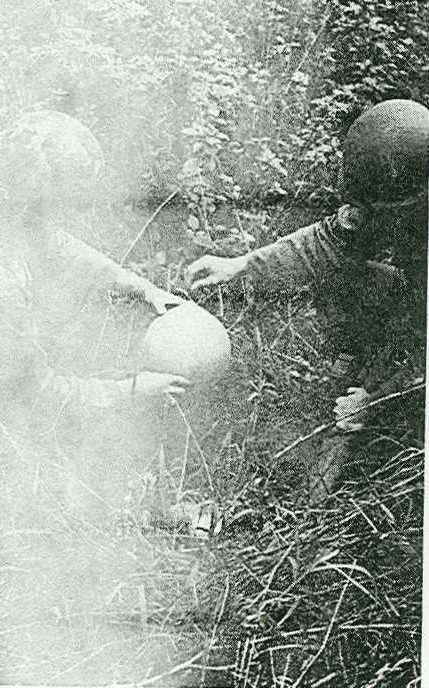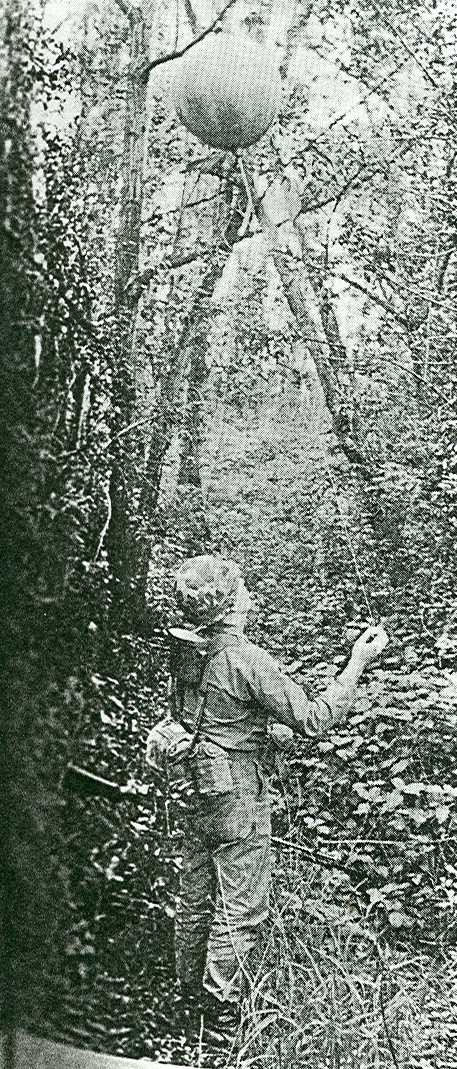UPDATED 14 December 2009
Return of the Air Commandos: USAF Close Air Support for the 21st Century

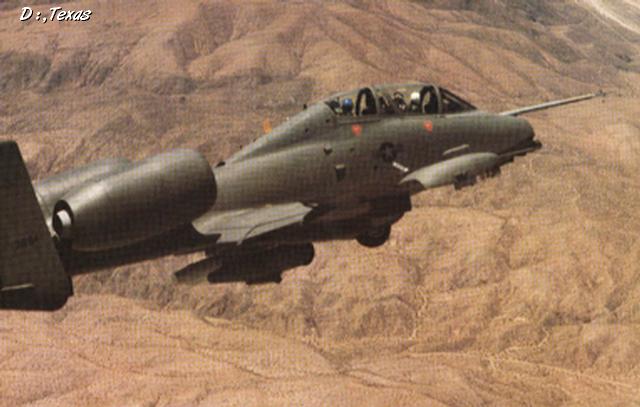

"'Fast moving aircraft are not designed to support ground troops,' said Army Sgt. First Class Frank Antenori. 'As much as the Air Force and Navy would like to think that, fighter aircraft that travel at speeds can't slow down to identify the targets,' he told National Defense......
He said the Air Force A-10 attack plane and the Army Apache helicopter are the ideal platforms for close air support, best suited to SOF missions. Air Force F-16s and Navy F/A-18s are much too fast to be able to properly identify targets, he said. 'The problem is getting the pilots at the altitudes and speeds that they are flying to be able to ID the targets,' he said.
A-10s and Apaches do a much better job, because they can move at a slower speed. 'With fast movers, I never had any success," he said.'
"Fast Jets Not Ideal Choice for Close Air Support" by Roxana Tiron, National Defense magazine, April 2004
1st Tactical Studies Group (Airborne) Director, Mike Sparks writes:
"This web page of the Maneuver Air Support Working Group (MASWG) of the 1st TSG (A) was originally published as an article in the December 2002 issue of Armed Forces Journal International magazine offered below as pictures (click on them to see full-sized version). This web page is now an enhanced version of that article with new information, pictures and references."
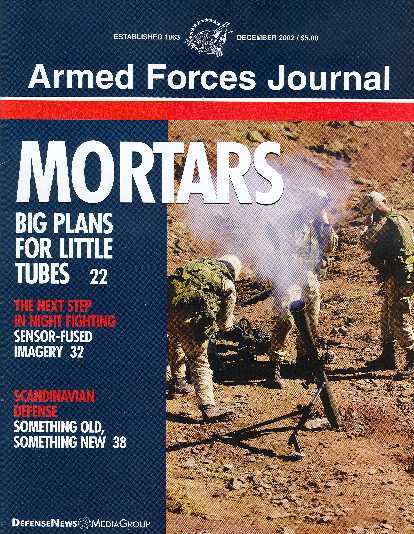
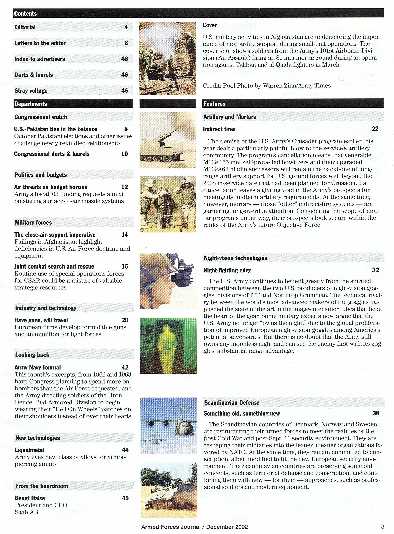


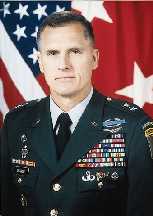
Brigadier General David L. Grange U.S. Army (R) wrote in 2001:
"As the military continues to transform into a truly 'integrated' joint force capable of operating against all adversaries, from armored forces to guerrilla bands, a critical requirement missing today, and into the future, is Close Air Support (CAS). Current aerial weapon platforms designed for CAS; trained and equipped Forward Air Controller (FAC), both ground and air; as well as the training of tactics, techniques and procedures are lacking or insufficient to meet the demands of today's battlefield.
CAS has taken a 'back seat' to precision-guided munitions (PGMs) and pre-planned aerial-delivered fires when what we need is a 'back seat' in CAS aircraft for an aerial observer to help spot targets. Though precision fires are critical, advantageous improvements, many fleeting targets on the battleground still require immediate, suppressive and pinning fires, at times over large pieces of ground, brought in very close to maneuvering ground units. Cannon and machine gun fire, bombs under 500 lbs., and napalm are still viable supporting munitions to the advancing infantryman.
Ground Soldiers and air controllers still must have the ability to call for, mark, direct, and adjust CAS for maneuver forces who are locating, encircling and destroying enemies and controlling key ground to keep the peace. The capability to attain the synergistic effect of simultaneous fire from ground and air weapons is critical to combat operations. Trained personnel on the battlefield and in the air as observers must exist with the know-how to employ USAF, USN, and USMC fixed-wing aircraft along with Army lift and gunship helicopters; indirect mortar, artillery, rocket-fire; in conjunction with ground assaults.
Recent war games and combat operations in SW Asia, such as 'Anaconda,' have demonstrated that our Armed Forces' ability to provide and employ effective CAS is waning. The CAS requirement today is no different for the grunt than it was during the Vietnam War.
I will never forget the lifesaving CAS capability provided by the A-1E, A-37B, and even the marking rounds: the OV-10 in Vietnam that saved us on many occasions from being over-run by more numerous enemies.
Over 20 years later, the same was true with Air National Guard and Active AF A-10s in the deserts of western Iraq during the Gulf War. Today in Afghanistan, if we have Gulf War II, or in any other future conflict, CAS will be a decisive 'force multiplier' in combat.
This web page expresses the views of experienced warfighters outlining the critical requirements for effective CAS today and in future conflicts.
Sergeant Grunt needs CAS.
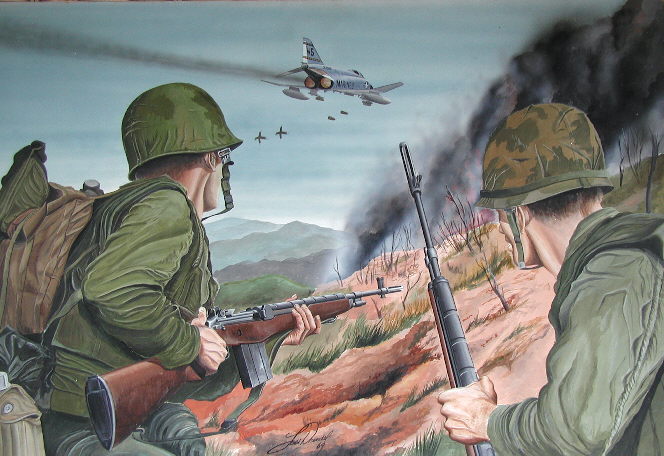
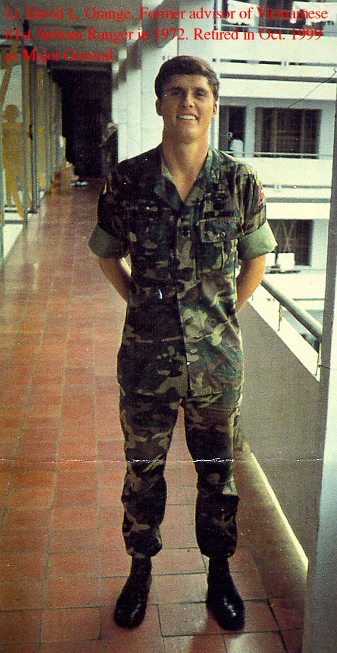

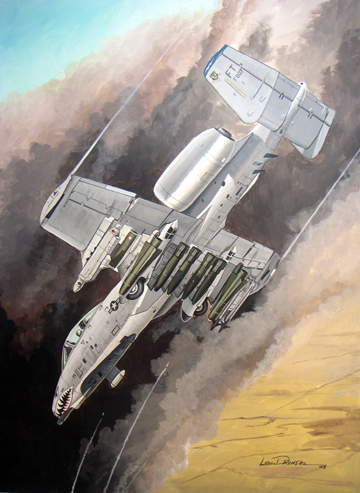
CAS failings in Afghanistan
Pinned down by enemy mortar fire with longer reach than the rifles and machine guns in their hands, the rescuers for Navy SEAL Neil Roberts are themselves in need of rescue. Rallying around a downed MH-47E Chinook helicopter they have dead and some men who will be dead if they cannot secure the area for an evacuation helicopter to land.
Finally after over an hour's wait, F-15Es appear and have to be talked into doing gun strafing runs on the enemy's positions since they've never trained to do this Close Air Support (CAS) task.
Hours later, the area is secure for extraction helicopters to land but not in time to save some men who died from their wounds and exposure.
The USAF in a recent interview with Stars 'n Stripes has tried to put a "happy face" on all this (see below), but the fact remains that after building over 700+ heavily armored A-10 attack planes built specifically for CAS for helping Army maneuver units; only a small fraction are on active flying status and when the troops needed the air strikes, the Army had to wait and men died needlessly.
In the September 30, 2002, Army Times, "Officers: Air Force Policy Left Ground Troops High And Dry: General, senior officer say units need more personnel to call in munitions" even status quo apologist Sean D. Naylor reports:
"The Army general who ran Operation ANACONDA and one of his senior fire-support officers are taking issue with Air Force practices they say allowed enemy targets to escape destruction and deprived Soldiers under fire of badly needed close air support.
In particular, they say, the Air Force's reliance on precision-guided bombs created several problems for troops on the ground in Anaconda, the March battle in Afghanistan's Shah-e-Kot Valley. The comments come at a time when Army leaders are fighting a rear-guard action in Washington against what they see as the Defense Department's trend toward over-reliance on precision-guided munitions in shaping the future U.S. military.
Their arguments are laid out in two articles in the September-October issue of Field Artillery magazine, the official journal of the Field Artillery Center and School at Fort Sill, Okla. The first article is an interview with Maj. Gen. Franklin 'Buster' Hagenbeck, the 10th Mountain Division commander who was in charge during Anaconda. The second article, 'Afghanistan: Joint and Coalition Fire Support in Operation Anaconda,' was written by Lt. Col. Christopher Bentley, Hagenbeck's fire support coordinator during the operation.
It sometimes took 'hours' for the Air Force to deliver close air support to Soldiers on the ground, Hagenbeck told Field Artillery. Once a request for close air support had been passed to a jet by an Airborne Warning and Control System aircraft, it took the Air Force 26 minutes to calculate the desired mean point of impact, which is required to ensure the bomb hits the target, Hagenbeck said.
After that, the aircraft had to get into a busy airspace management scheme before it could attack the target and deliver the bomb. 'Aircraft were stacked up to the ceiling' and could only be flown in a few at a time, he told Field Artillery. 'It took anywhere from 26 minutes to hours [on occasion] for the precision munitions to hit the targets.'
'That's okay if you're not being shot at or the targets aren't fleeting,' Hagenbeck told Field Artillery. But often U.S. troops were under fire, and the targets were 'fleeting.'
When al-Qaida forces on resupply missions stopped their sport-utility vehicles in one place long enough, 'the fixed-wing aircraft would slam them,' Hagenbeck told the magazine. But, he said, that didn't happen often enough.
'We really worked to find ways to kill fleeting targets the first three or so days,' he told Field Artillery. 'Honestly, we weren't that successful.' But getting the jets on station quickly enough was only part of the problem. All too often, according to Hagenbeck and Bentley, even when a jet was available, Air Force rules prevented it from coming to the aid of Soldiers who needed its support.
'We have a huge procedural and training issue we've got to work through with our Air Force friends,' Hagenbeck told Field Artillery.
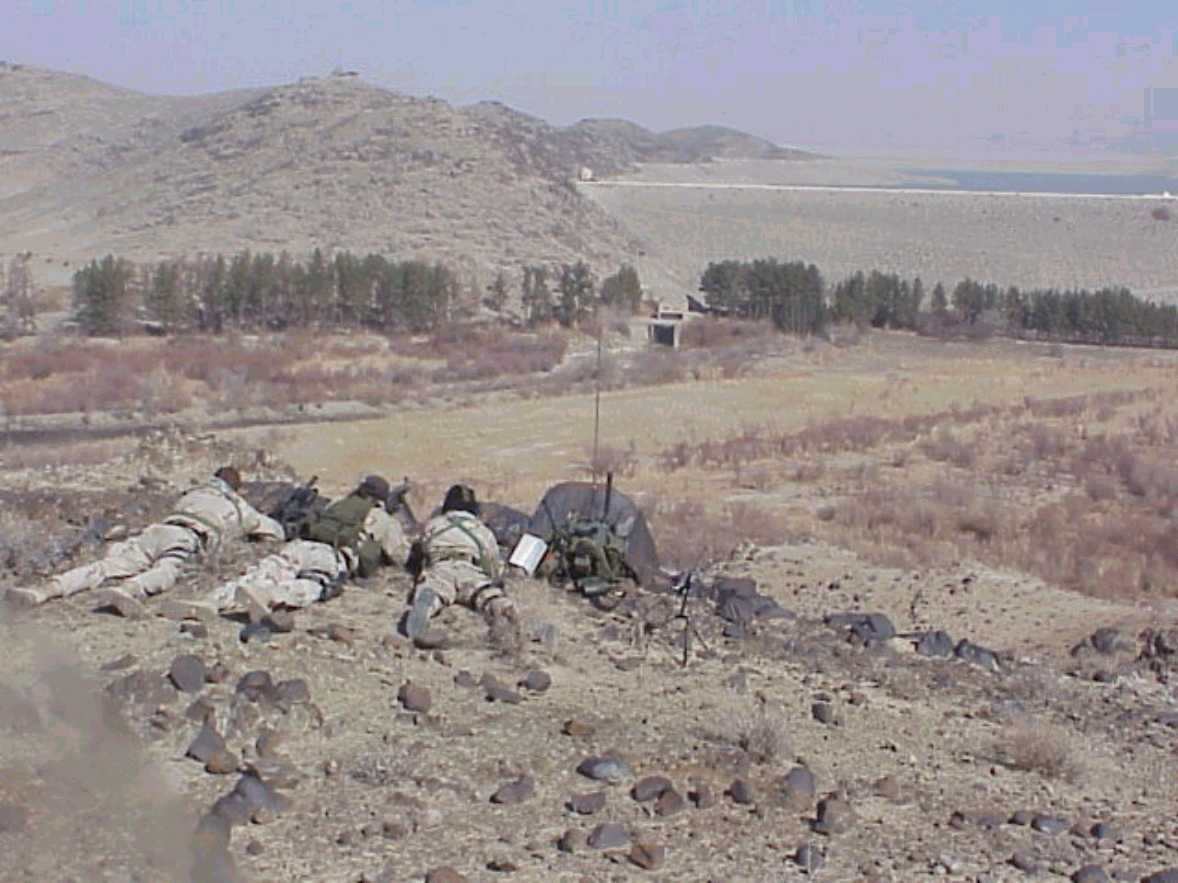
The problem, as he explained it, is that the Air Force refuses to drop precision-guided munitions unless the strike has been called in by an Air Force ground forward air controller or an Air Force enlisted terminal attack controller. But there are not enough of these personnel for one to be placed in every Army unit that might require close air support. This particularly was the case in Anaconda, Hagenbeck told Field Artillery.
'This war became platoon fights separated by distances in very rugged terrain with too few ETACs to go around,' he said.
Even infantry units with an airman to call in strikes, he said, can easily lose that critical capability during combat.
'What happens if the ETAC is injured and has to be medevaced [medically evacuated] or is killed?'
'We needed as many ETACs and GFACs as we could [get] on the ground, and the Air Force doesn't have them now, and they probably won't have them in the foreseeable future,' he told Army Times.
The solution, according to Hagenbeck and Bentley, is to train and certify the Army's forward observers - who call in artillery and mortar fire - as 'universal observers,' able to call in any Army or Air Force munitions. 'Our FOs must be certified as ground forward air controllers,' Bentley said in the article. 'This may be a sore spot with the Air Force, but I believe it to be nonnegotiable.'
For his part, Hagenbeck said while it may be a 'sore spot' among Bentley's counterparts in the Air Force, it was not a point of discord between Army and Air Force generals. 'Conceptually, we're all in agreement that it needs to happen,' Hagenbeck told Army Times.
'Fight As A Team'
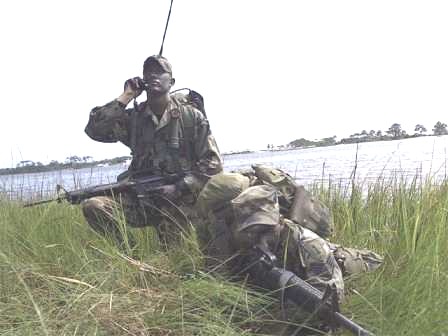
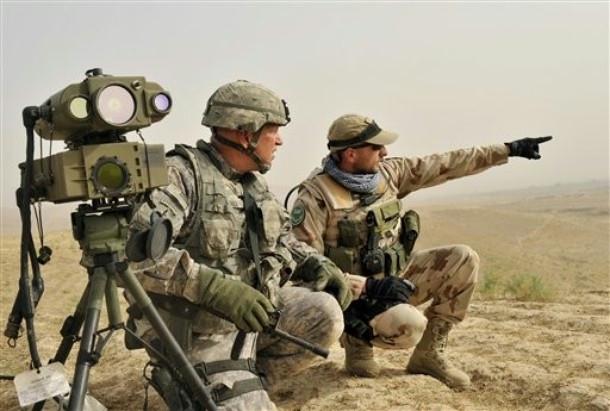
In the meantime, the Army must do a better job of integrating Air Force tactical air control party personnel - the EFACs and GFACs - into ground maneuver units' training and operations, according to Bentley.
'We cannot continue to operate with an add-on conglomerate of Air Force personnel, especially during combat operations,' he writes. 'We must train and fight as a team.'
The Air Force did not provide an official to discuss the issues raised by Hagenbeck and Bentley before Army Times' deadline.
Hagenbeck and Bentley also touched on other procedural problems that surfaced with the Air Force during Anaconda.
Bentley criticized the need to coordinate what strike aircraft would be needed over the battlefield 36 hours ahead of time, as part of the air tasking order process.
The ATO is 'the best mechanism available to coordinate the hundreds of human and mechanical pieces involved in getting air on station, but it is conversely inflexible and not well-suited to support a nonlinear, asymmetrical battlefield,' he wrote. 'The ATO must be flexible enough to change aircraft and munitions packages as the intelligence picture changes by the minute. Increasing the flexibility of the ATO cycle is imperative to responsiveness in today's' operational environment.
In his article, Bentley suggests that perhaps the Air Force was reluctant to take steps that would lead to better close air support.
'In some cases, the inabilities of aircraft to break self-imposed [Air Force] altitude restrictions, slow their strike speed down or strafe the battlefield (the latter in the case of bombers) restricted these aircrafts' abilities to deliver timely munitions in close support of troops on the ground,' he wrote.
Hagenbeck also warned against being too impressed by the numbers that get thrown around whenever air campaigns are discussed.
'A ground force commander does not care about the number of sorties being flown or the number and types of bombs being dropped and their tonnage,' he told Field Artillery. 'Those statistics mean nothing to ground forces in combat. All that matters is whether or not the munitions are time-on-target and provide the right effects.'
Hagenbeck told Army Times that he was not 'pointing a finger at the Air Force' with these comments.
'It's easy to understand numbers, and I think we all often fall into those kinds of traps,' he said.
Nevertheless, the general said, 'To tell me that we flew this many sorties and dropped this many bombs, in and of itself, doesn't tell me that it's been effective in the war fight. It doesn't tell me where the bombs landed.'
A Few Praises, Too
Hagenbeck and Bentley were not completely dismissive of precision-guided bombs, the best known of which is the Joint Direct Attack Munition, or JDAM. 'The JDAMs were terribly effective against fixed targets,' Hagenbeck told Army Times. 'If we were receiving fire from a cave, if we knew there was going to be a delay [before the close air support arrived], we could continue suppressive fires with our mortars and machine guns, and then they could put a bomb inside the cave. What was more difficult for us is if there were fleeting targets on the ridgeline. ... Then the JDAMs were not effective."
In those instances, it was better for the jets to strafe the target area with cannons. The best close air support aircraft for these missions were the Army's AH-64 Apache attack helicopters and the Air Force's A-10 "Warthog" ground attack aircraft during the day, and the Air Force Special Operations AC-130 Spectre gunship at night, according to Hagenbeck and Bentley.
'The most effective close air support asset we had was the Apache, hands down,' Hagenbeck told Field Artillery. 'The detainees later said the Apaches were the most feared weapons on the battlefield - the helicopters were on top of them before they knew what was happening. The Apaches came as close to 'one shot, one kill' as you can get.'
Both officers also had high praise for the Spectre gunship. 'Its effectiveness was amazing,' Bentley writes. 'The enemy began referring to it as the 'Spitting Witch.'' He advocated giving each of the Army's four light infantry divisions a squadron of AC-130s, or at least making the aircraft available for 'all light infantry training and military operations around the world.'
Hagenbeck also made the following points in Field Artillery:
**He didn't consider bringing in 105mm howitzers 'because I knew we could accomplish the mission without them.' The 10th Mountain and 101st Airborne (Air Assault) divisions, each of which contributed troops to Anaconda, are armed with 105mm towed howitzers, but none was deployed to Afghanistan. Hagenbeck told Army Times he did not know who made the decision not to deploy them, but he acknowledged in Field Artillery that even if he'd had them available in Afghanistan, he wouldn't have taken them into the battle on the first day, because he had too few CH-47 Chinook helicopters to carry them and his infantry force.
However, he also told the magazine that an organic ground-based indirect fire capability is 'indispensable' for the close fight.
**The U.S. troops might not have had artillery, but al-Qaida certainly did. U.S. forces destroyed five Soviet-made D-30 122mm towed howitzers that the enemy used to fire on a joint attack by Special Forces troops with Afghan allies in the early hours of the battle's first day, and also on the infantry force's helicopter landing zones, Hagenbeck told Field Artillery. U.S. forces found several others in caves, Hagenbeck said. He told Army Times he did not know whether the enemy guns inflicted any casualties.
**American surveillance and reconnaissance aircraft found it very difficult to identify al-Qaida troops and their cave complexes around the valley. 'It took 'boots-on-the- ground' to find the caves,' Hagenbeck told Field Artillery. 'The shadows alone precluded our discovering a cave until our Soldiers were almost on top of it.'
The enemy moved in small groups of 3 to 5 fighters, making them hard to spot. "During the daylight, we watched them on the Predator,' Hagenbeck told Field Artillery. 'At night, when these groups heard a Predator or AC-130 coming, they pulled a blanket over themselves to disappear from the night-vision screen. They used low-tech to beat high-tech."
2002 Ranger Association Banquet Remarks
The following message from Bill Schwartz '59 is reposted with his permission.George Lawton
On Close Air Support issues, Bill Schwartz, after listening tocomments and discussions from various 10th Mountain Division officers who fought in Afghanistan and participated in the Senior Leaders Panel, came to the following conclusions:
"CAS in Afghanistan was abysmal until the arrival of the A-10s, months into the operations. As I listened to the informal tales told by 10th Mountain Division people about the lack of support, my stomach turned. This was not the Air Force that supported us in Vietnam. Air Force shooters would not fly below 10,000 feet in daylight per Air Force dictates, not for political reasons. Hence no strafing runs. No AC-130 support was permitted by the Air Force during daylight hours. For example, when the Rangers were going back into Roberts Ridge to find the SEAL who was killed and support the operators in the area, AC-130 support was withdrawn by the AF Cmd Center in Saudi Arabia five minutes before Chinook touchdown at the LZ because it was daylight. The result as we know contributed to dead and wounded Rangers.
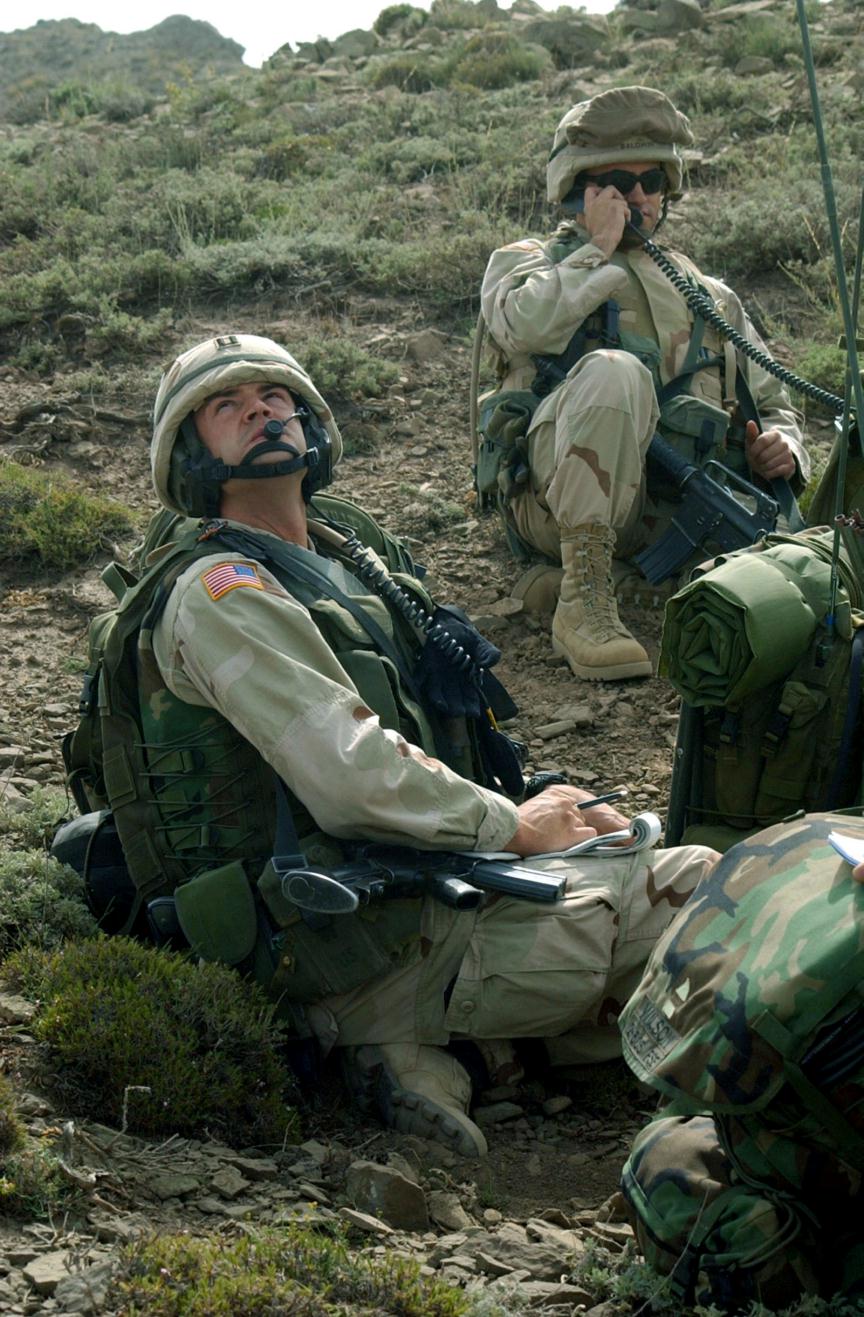
CAS as we knew it was only provided by Navy and marine aircraft when they were in the AO. Only they would come in low for strafing and bombing runs. Unless a unit had an ETAC or FAC they weren't permitted to call in AF close air support. Small units lacked this support. Precision munitions often weren't and could require hours to get on target. At one point it took five hours to bring in close air support for 10th Mountain troops that were in a tough fight. After the Rangers were evacuated from Roberts Ridge, the Air Force pounded the hell out of it for hours with precision munitions prior to a reinsertion by the 1-87 Inf. When the 1-87 hit the LZ the same Al Queda who fought the Rangers were still on the ground. None had been killed. It took troops on the ground to kill the 12 Al Queda that continued to fight from their fortified positions.
One of the reasons for poor CAS was that the Air Tasking Order was laid out 72 hours in advance, and the Air Force staffers were so bureaucratic that they wouldn't adjust weapons loads or missions. By the time the 10th left, they were able to reduce this to 18 hours. This approach to air support means that hitting fleeting or moving targets is very unlikely.
The ASOC in Afghanistan was often overruled by Blue Suit staffers at the Command Center in Saudi Arabia who didnt have a clue as to the real situation on the ground.
For a long period, the Air Force would not allow heavy lifters to land in Afghanistan in daylight. Because of poor weather conditions at night this stifled resupply operations. God forbid a round should hit a resupply bird. I contrast this with Vietnam when C-123s and C-130s landed under fire in daylight to support troops on the ground.
In effect there is a significant cultural difference between the views of the Army and the Air Force when it comes down to close air support. These problems must be ironed out before any further operations, such as in Iraq, are undertaken.
Former Commander of the OPFOR at NTC, Colonel John D. Rosenberger, U.S. Army presented the following report; The Inherent Vulnerabilities of Technology: Insights from the National Training Center's Opposing Force:
"To the 2,500 troopers of the 11th Armored Cavalry Regiment, the Opposing Force (OPFOR) at the U.S. Army's National Training Center (NTC), it came as no surprise to watch the 3rd Serbian Army march back into Serbia virtually unscathed by the relentless attacks of NATO air power during the Kosovo conflict this past year. Moreover, it came as no surprise to see the Serbian Army employ a wide variety of physical and electronic deception techniques, remain tactically well-dispersed, and hide their combat systems in the infrastructure of cities and villages to preserve their combat power.This is old news to the combined-arms team of the NTC's Opposing Force. These same Serbian adaptations have been learned and employed successfully by the OPFOR at the NTC since 1994-adaptive countermeasures critical to preserving combat capability at the tactical level of war against the impressive array of intelligence collection and attack technologies employed by America's joint team. Moreover, this is only one of several insights the OPFOR can provide into the limitations and vulnerabilities of the current warfighting technology that underpins America's style of warfare in the 21st Century.
In the past six years, the NTC OPFOR has exposed many limitations and vulnerabilities inherent to the warfighting technologies our joint services are currently pursuing. Moreover, they've learned to defeat them just like any adaptive and savvy opponent will do-just as the Serbian Army did this past year. In my view, these vulnerabilities that we have exposed are compelling, not simply to make smarter technological investments in the years ahead, but equally important, ensure we do not forfeit combat effectiveness, the ability to deter, or the ability to quickly defeat our enemies at both the operational and tactical levels of war in the years ahead.
To begin with, we have learned that active and passive force protection measures are vital to preserving combat power against asymmetric technologies, asymmetric in this case meaning some technological capability that provides a decisive advantage over an opponent in combat. For example, cruise missiles, laser-guided bombs, satellite reconnaissance systems, high altitude reconnaissance aircraft, and unmanned aerial vehicles have provided us an asymmetric combat advantage over all our opponents this past decade.
In response to these capabilities, we have learned that thermal deception, vehicle and unit dispersion, decoys of all types, camouflage, concealment, and electronic deception are vital means and ways to protect and preserve our ground combat power. Furthermore, the OPFOR has learned that air power and overhead intelligence acquisition systems have significant limitations and are inherently vulnerable to deception-even in desert and mountainous terrain. And by extension, even more so in densely forested areas and jungles, not to mention complex and urban terrain.
Take fixed-wing attack aircraft. It is not difficult to survive against the existing suite of joint close air support aircraft (F-16, F-18, A-10, and equivalents), attacking at altitudes above 15,000 feet, even in the desert. Given the target acquisition capability and the speed in which these aircraft fly, target acquisition and target recognition at these altitudes is difficult at best. We have learned that if we limit our movement, don't create dust clouds, remain tactically dispersed, use camouflage, and employ decoy equipment, we will absorb few losses to fixed wing attack above 15,000 feet-the same methodology of force protection the Serbian Army and para-military forces employed in the dense forests, cities, and villages in Kosovo.
By using a combination of these force protection techniques, the effectiveness of high-altitude, fixed-wing attack against ground forces can be limited and thereby endured. Moreover, this ability to eliminate the effectiveness of high-altitude fixed-wing attack, in turn, places an even higher value on overhead target acquisition platforms like satellites, JSTARS, and unmanned aerial vehicles. And as we have learned, these overhead intelligence collection systems-the operators and analysts-are inherently easy to deceive.
Take reconnaissance satellites in low earth orbit. Given our experience, it takes about 18 hours to complete the targeting process using these sensors-from acquisition, to imagery analysis, to integration into the ATO, to effective attack. Consequently, we've learned to move critical combat systems every 10-12 hours to protect them and keep them in the fight. Frequent survivability moves, in small packets of vehicles are an essential technique to employ to preserve combat power."
Iraq: Single-seat A-10s strafe a friendly British vehicle convoy: USAF SABOTAGE OF THE A-10 IS THE REAL CAUSE
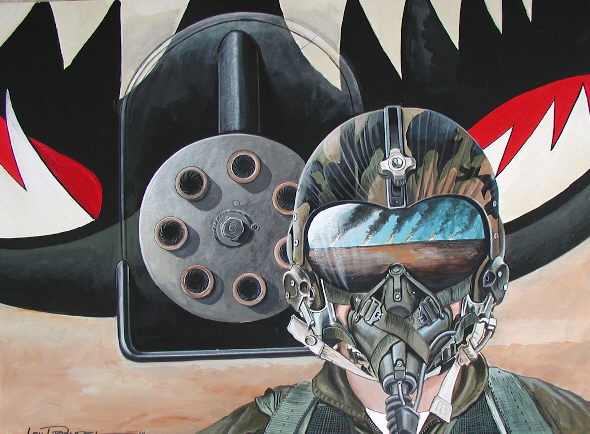
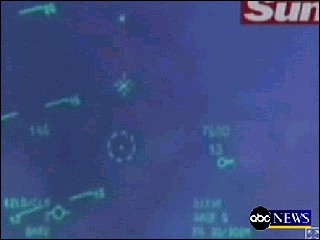

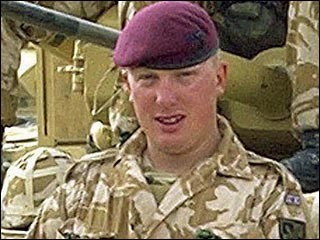
The REAL moral of this story is that A-10s need a BACK-SEAT OBSERVER who might actually study what a British Warrior armored fighting vehicle looks like and could operate optics to zoom in on a target to identify it before engaging.
Pilots are too busy and too full of piloting concerns (don't fly into the ground) as it is.
The USAF controlled by fast jet fighter egomaniacs hates the A-10 and is constantly undermining it by not sending it to Iraq unless Army generals insist on it, lest it get the glory because its more effective than fast fighter jets at CAS. When the marginalized A-10 has problems (surprise! Surprise!) the USAF is quick to "leak" the dirty laundry to further their we-can-do-CAS-with-expensive-PGMs-from-our-sexy-fast-jets lies. So if you really "care about our troops" instead of crying about how heroic and fascist we are, put some heat on DoD through your Congressmen/Senators to stop neglecting our best attack planes which the USAF dislikes because they don't fly over 1, 000 mph and look sexy, and to IMPROVE on the potential of these planes by giving them an OBSERVATION capability they should have had all along. If the USAF refuses to do this transfer the A-10s to the Army to fly. O, yeah Army helicopter gunships flying 1/2 the speeds of the A-10 have 2 crewmen inside, one just to observe and act as gunner. Hint, hint.
http://news.aol.com/topnews/articles/_a/tape-said-to-show-us-killing-british/20070206094909990001?ncid=NWS00010000000001
Updated:2007-02-06 16:47:38
Tape Said to Show U.S. Killing British Soldier
By PAISLEY DODDS
APLONDON (Feb. 6) - A leaked cockpit video published Tuesday captures a dramatic exchange between two American pilots whose voices choke up when they learn they have killed a British Soldier in a 2003 friendly fire incident in Iraq . "I'm going to be sick. We're in jail, dude," one pilot says.
Jump Below: Watch Video
http://us.video.aol.com/?pmmsid=1837447
Despite British requests, the Pentagon had refused to release the video to the family of Lance Cpl. Matty Hull, who died when U.S. jets fired on his convoy in the southern city of Basra. But after excerpts of the video were published in The Sun newspaper, and the footage was widely broadcast, U.S. authorities agreed to release it for the British inquest.
Neither pilot from the Boise, Idaho-based 190th Fighter Squadron was disciplined in the U.S. military's own investigation, which concluded the pilots "followed the procedures and processes for engaging targets," Pentagon spokesman Bryan Whitman said Tuesday.
The leaking of the tape strained relations between the Department of Defense and their British counterparts, who were previously given a DVD of the classified video.
The dramatic cockpit video and recording begins with two pilots identifying a target and checking with ground control that there are no coalition troops in the area - to which ground control says, "That is an affirm. You are well clear of friendlies," according to the transcript released by The Sun.
Tempers flare between the two pilots, with one saying it looks like the prospective targets are carrying orange rockets. Coalition troops are often equipped with bright orange markers to identify them as friendly forces.
"I know what you're talking about!" the first pilot says, after asking about the alleged rockets.
"OK, well they got orange rockets on them," the second pilot says.
"Orange rockets?" the first pilot asks again, telling the other pilot they need to get back to base soon.
"I think killing these damn rocket launchers, it would be great," the second pilot says.
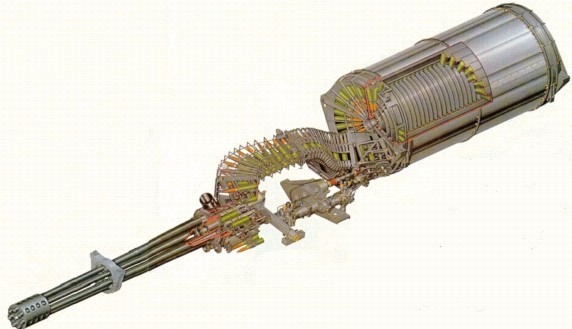
The two U.S. A-10 jets opened fire on Hull's tank, which was part of a five-vehicle convoy engaged in combat outside Basra on March 28, 2003. Four other Soldiers were wounded, including the convoy's leader, Capt. Alexander MacEwen.
Gunfire is heard. Minutes later they learn there are friendly forces in the area and that one person is dead and another is wounded.
Pilot 1: "I'm going to be sick."
Pilot 2: "Ah f---."
Pilot 1: "Did you hear?"
Pilot 2: "Yeah, this sucks."
Pilot 1: "We're in jail, dude."
The pilots communicate with ground control again. "They did say there were no friendlies," the first pilot says.
"Yeah, I know that thing with the orange panels is going to screw us. They look like orange rockets on top," the second pilot says.
The first pilot then asks if his tape is still on. Seconds later, there is silence.
A publicly releasable version of the U.S. investigation report - which found the pilots followed procedures and practices for engaging targets - was given to the British Defense Ministry in November 2003, said Lt. Col. Teresa Connor, a spokeswoman at U.S. Central Command headquarters in Tampa, Fla.
On Tuesday, after the leaking of the tape, Connor said Central Command authorized Britain to display the video to the coroner and family in the presence of the Defense Ministry. It is up to the ministry to decide whether and when to do so, she said.
The U.S. military has no plan to release the names of the pilot or their unit, Connor said.
The U.S. Embassy's deputy chief of mission, David Johnson, said he thought the coroner had already viewed the video.
"Our focus is really on finding out where our procedures fell down and allowed information that was classified to be provided to individuals who did not have appropriate access to it," Johnson told the AP, saying that U.S. and British exchanges had been "military-to-military."
Oxfordshire Assistant Deputy Coroner Andrew Walker is hearing the inquest, which resumes Feb. 16.
British coroners tasked with inquests into suspicious deaths have become increasingly critical of military errors. One coroner last year criticized American authorities for failing to provide access and name U.S. marines involved in the death of British television journalist Terry Lloyd, shot in Iraq in March 2003.
Johnson said the British inquests were "unique."
"It's a very delicate situation in looking at this issue in the context of domestic law when what has happened has occurred on the battlefield," he said.
He said the video humanized the tragedy on both sides but that nothing could compare to the family's loss.
State Department spokesman Sean McCormack told reporters in Washington that he had read the transcript of the incident. "My reaction is that these people immediately understood that it was a terrible, terrible mistake, and they felt immediate remorse of what happened."
Susan Hull, Hull's widow, welcomed the release of video, saying it was "vital evidence and must be shown" at the inquest.
"The inquest is my one and only chance to hear how and why Matty died," she said in a statement released by her lawyers. "I would have preferred to hear the evidence from the U.S. pilots themselves. However, they cannot be compelled to come and they have not come voluntarily. The video is therefore vital evidence and must be shown. I do not relish hearing it in open court, but after years of being told that it did not exist or was secret I feel that it was right not to give up hope."
Previously, the Defense Ministry had said it was unable to persuade the U.S. to declassify the footage - a recording British authorities initially claimed did not exist.
Britain's defense secretary, Des Browne, welcomed the U.S. release of the video. "The release of classified information, even for the closest of allies, is never straightforward, but this is the right thing to do," he said.
Former U.S intelligence officer Bob Ayers, now a security analyst based in London, said pilots in fluid combat situations often do not have real-time intelligence and logistics information. He also said the situation underscores the problem of forces unable to communicate with each other on the ground.
"This was happening during the mad rush toward Baghdad," Ayers said. "You have planes that are going 300 mph and by the time they get coordinates, they're five to 10 miles off the mark."
Paul Smyth, a navigator and wing commander with the Royal Air Force who flew combat missions to Iraq in 1991, said the pilots should not be blamed.
"I had a lot of empathy with the pilots and how awful it must have felt," he said, noting that units are provided with only a limited number of radios and have limited ability to communicate between forces.
"I don't think we should be looking at blame," he said. "If you look at the conflicts in N. Korea and other places, there have been advances. It's a case of the glass being half full and half empty, but at the end of the day you're never going to be able to completely eradicate friendly fire incidents in fluid combat situations."

These excuse-mongers are full of BS. If the pilots were not to blame, notice NOTHING was DONE to IMPROVE the A-10 by having an EXTRA SET OF EYES to operate radios and VERIFY TARGETS are targets and not friendlies. The over-worked pilots were the CAUSE of the fratricide but the BLAME is on the A-10 not having an extra crewmen.
The A-10 Saga Began with the A-X to Spite the Army for the Cheyenne Attack Helicopter--and before that--the Germans in WW2!
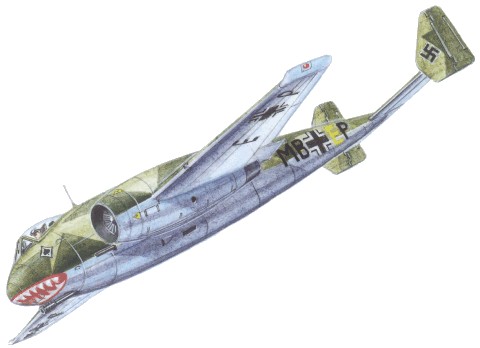
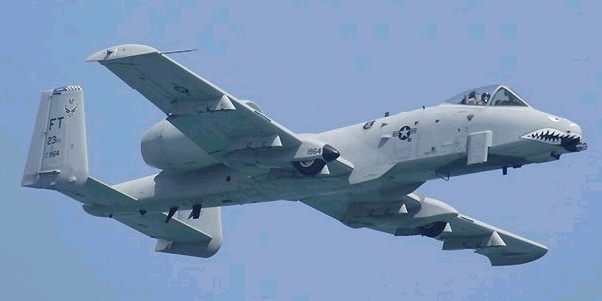
The Germans first came-up with the A-10 design in WW2! Compare to the A-10!
Our tragic story began in 1943.
The integrated U.S. Army has landed in North Africa. The Army Air Force is a PART OF THE GROUND MANEUVER FORCES. Fighting the high-technology Germans that pose a mortal threat to America is a difficult task and the Jerries had been practicing for 4 YEARS by the time we enter the fray.
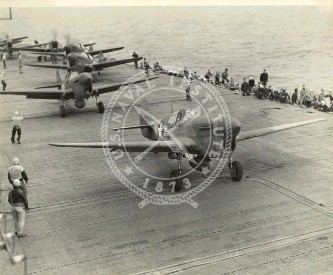
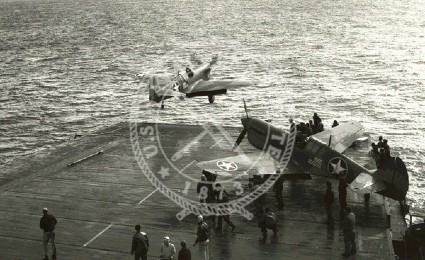
Army commanders neglect to use their P-40 Warhawks previously launched from the USN aircraft carrier the USS Ranger against German Luftwaffe air bases to destroy their aircraft on-the-ground in what's termed a "counter-air" mission. Army ground maneuver focused commanders want their P-40s to do close air support (CAS) to help their units break through enemy resistance--just as the German Stukas had proven so devastating in the war.
Along comes the Luftwaffe and it begins to strafe and bomb Army maneuver units with their hands-full just learning how to fight the combined-arms Afrika Corps under competent mastermind General Erwin Rommel. We even lose the battle for Kasserine Pass and afterwards, the Army Air Force egotists that have long sought to be broken free from support for the Army with their own Air Force bureaucracy began to clamor for CENTRALIZED CONTROL of ALL AIRCRAFT---THEIR CONTROL--so they can do the sexy things they want to do which is fight mirror images of themselves in the air or by counter-air.
Thereafter "1943" is the curse word and rallying cry of the centralizing USAF bureaucrat and it gave birth in 1947 to the independent U.S. Air Force in the particularly disastrous National Security Act creating the "Department of Defense" (DoD) that also begat the selfish egomaniac USMC and the actual Nazi-run CIA. It was President Truman's most terrible error and one we as a nation may not recover from. The malignant narcissist USMC perverts any kind of joint service teamwork with their trash-talk while botching amphibious warfare to such a degree that the nation is at risk of losing a war by their own WW2 re-enactment stupidity. The CIA doesn't even work for the American people; it works for the violence-loving, Rockefeller Illuminati best seen not as "neocons" but as actual AmeroNazis that predate the GermanoNazis of the 1930s--who they funded into power since the U.S. Constitution stands in their way of making the U.S. a fascist lemming police state.
Now back to the USAF.
As to be expected, the USAF began to centralize all its functions into their service bureaucracies and one aircraft type: the fighter-bomber. As flaming egomaniacs themselves, the USAF was dividided (and still is) by the studs--the fighter pilots who can pull Gs in aerobatic maneuvers and the lesser pilots who "can't" pull-Gs who fly bombers straight & level and the even lower underclass--the transport pilots. Nevermind that all these aircraft and functions are vital--the USAF Pyramid-of-Ego doesn't value them and that's what drives the culture.
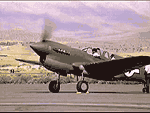
In WW2, all planes until the very end were prop-driven and could even operate from grass fields. Thus, you could have one plane type, a fighter-bomber do both counter-air, air-to-air and ground attack CAS because you were flying under 400 mph and could actually see what you were attacking. Jets appeared at the end of the war that now flew at 500-700 mph and would not only need extremely long runways, COULD NOT SEE GROUND TARGETS ON THEIR OWN.
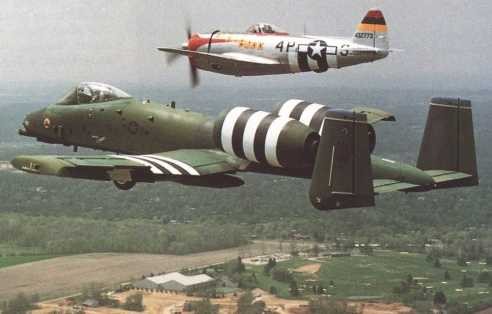
The USAF jet jock ego inflated by jet speeds missed these realities from 1945-1950 as documents from the time indicate. They were going to continue with their fighter-bombers-for-everything mentality just as they had in WW2--they'd just use sexier jets and comfy air bases.
Suddenly in 1950, North Korea invades South Korea with T34/85 medium tanks leading the way and both South Korean and U.S. Army forces that had ditched combined-arms warfare using light tanks in favor of good 'ole foot-slogging, light infantry narcissism were sent reeling in retreat after the defeat of Task Force Smith.
Screams were heard for CAS from the USAF to stem the North Korean communist tide. F-80 fighters sent in from Japan could not hit shit. Nor could the F-84s. We were about to be over-run and forced into the sea at the Pusan Perimeter when Navy A-1 SkyRaiders and USMC F-4U Corsairs operating from off-shore, aircraft carriers began to render EFFECTIVE CAS by way of their slower speeds, long loiter times and rugged construction to take battle damage. Realizing its nearly fatal error, the USAF takes back all the F-51 Mustangs it gave to the Air National Guard and sends them to Korea to do CAS operating from small, forward air bases. The Colonel Dean Hess USAF story eloquently presents how F-51s were supplied to the fledgling Souith Korean AF to defend their country.

South Korea is saved.
However, the USAF fighter-bomber mentality was not. What should have happened--did not. Unarmored, F-51 Mustangs with vulnerable liquid-cooled engines suffered enormous casualties in the Korean War. USMC F-4Us difficult-to-fly because of their huge engine noses and high torque were "ensign eliminators" and suffered high losses to enemy AAA fire until an armored AU-1 variant appeared. The SkyRaiders were also improved by heavy armor plate. What common sense dictated was for a CONTRA-ROTATING PROP (eliminates torque problems) CAS Attack plane to be developed from the SkyRaider (DarkShark) for the USAF, USN, USMC and the Army. When the American engine makers couldn't field a contra-prop power plant, the British Mamba was available and highly successful in the Fairey Gannet carrier-based, ASW plane.
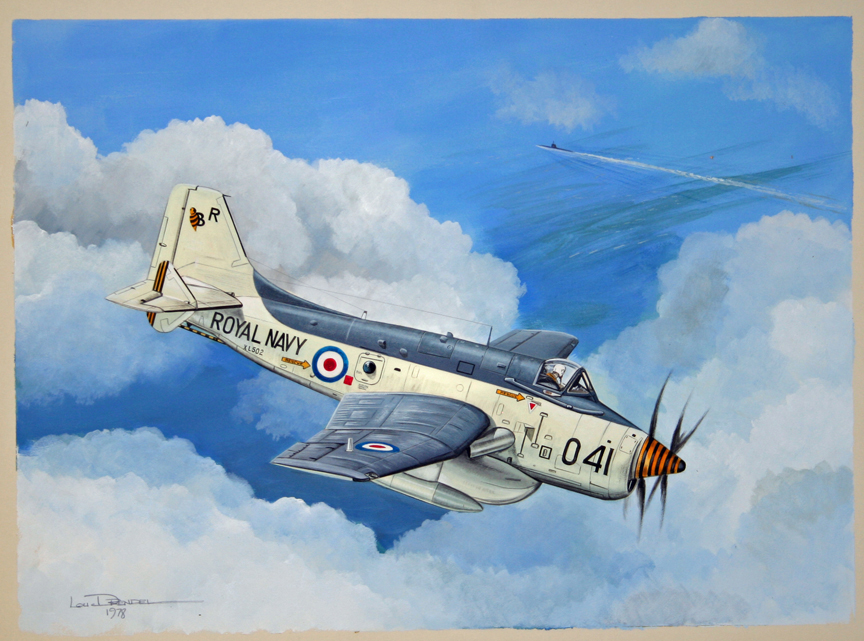
American pride and ego killed any future developments of the A-1 and production ceased in 1958. Korea was written off as an aberration by all fly boy clubs until Vietnam smacked them in the face--just like Korea had earlier. One man who did not buy into the fighter-bomber panacea was Major (now Brigadier General) Heinie Aderholdt who got amazing results with old WW2 prop planes in places like Korea, Laos, Tibet, Cuba, and of course, Vietnam. He re-created the "Air Commando" legacy began by Colonel Phil Cochrane who combined fighter-bombers, transport planes with Paratroopers and gliders into a powerful, egalitarian combined-arms AIR FORCE in the China-Burma-India (CBI) theater in WW2. Legendary General Claire Chennault whose P-40 "Flying Tigers" smashed the bombers-will-always-get-through hubris of the Douhet strategic bomber crowd joined up with the CIA and Aderholdt to fly secret agent and supply airdrop missions later becoming "Air America". This is one area, lead by USAF professionals where the CIA excelled in excepting one notable failure in trying to force President John F. Kennedy to send in U.S. forces to save prop-plane B-26 Invader supported Assault Brigade 2506 in the face of T-33 (2-seat F-80s) jets at the Bay of Pigs in 1961:
A Beach-Head Too Far: What would an Airborne Bay of Pigs Looked Like?
Racketeers in the USAF and Navy had dishonestly cherry-picked events during the Korean war to further their fighter-bomber and carrier non-senses. The Korean war should have taught them to have lots of contraprop SkyRaiders operating from grassy fields not prone to enemy air base destruction and small escort carriers that could be economically operated en masse. Instead, they went ahead with jets needing bloated air bases and bloated supercarriers. When Vietnam became an U.S. war, huge air bases had to be built on land in South Vietnam which in turn had to be defended--drawing in the incompetent marines in 1965--who then proceeded to get themselves killed, creating a blood lust for revenge in the American populace as American jet fighter-bombers unable to see squat on the ground began to bomb villages and kill innocent civilians, whose surviving relatives joined the ranks of the Viet Cong rebels.
Fortunately at that time, the U.S. military still had some no-BS adults in the ranks who demanded Airborne Forward Air Controllers (AFACs) flying in O-1 Bird Dog (ands later O-2s, OV-10s) STOL Grasshopper planes to guide air strikes, the SkyRaiders were taken out of mothballs, and the trainers like the T-28 and the amazing T-37 jet trainer were converted into attack platforms like the A-37 Dragonfly that while a jet could fly slow enough and long enough to do CAS. Gunships firing massed fires from AC-47s, AC-119s and AC-130s appeared. The USAF had finally adapted correctly to a "limited war".
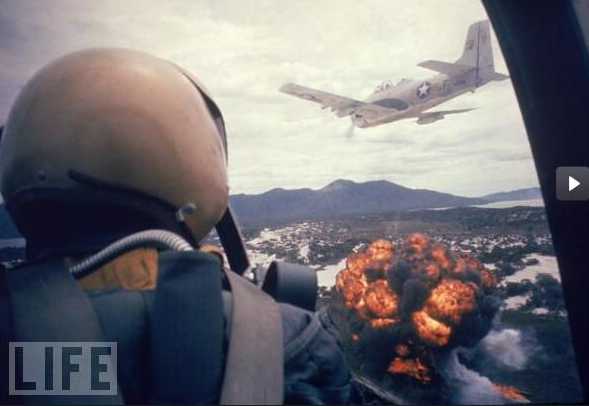
However, as an ego-driven bureaucracy with the fighter-bomber at the top of the pyramid, the USAF's heart was never in to helping the ARMY--in ANY WAR--limited or all-out. It longs for MIGs to shoot-down to become aces and to hit the other guy's air bases and failing that to strategic bomb factories, oil storage tanks, with their sexy fighter-bomber lawn darts even if it meant constant trips to the air tanker being flown by lower class pilots.
As soon as Vietnam ended, the USAF got rid of all the un-sexy prop planes needed to do CAS using the shoulder-fired, surface-to-air missile (SAM) as the convenient bogeyman excuse. The Army knew that the USAF converting trainers and bringing back surplus prop planes for Vietnam meant as soon as the war ended these assets would vanish. The Army had developed and fielded the world's first attack helicopter, the AH-1 Huey Cobra as an interim measure and had the fast, 250 mph compound helicopter AH-56 Cheyenne under development.
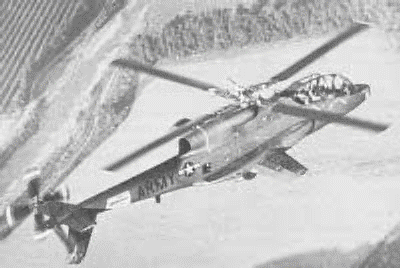
The assholes in the USAF had a conniption fit!
How dare the Army do CAS when we refused to do it for them!
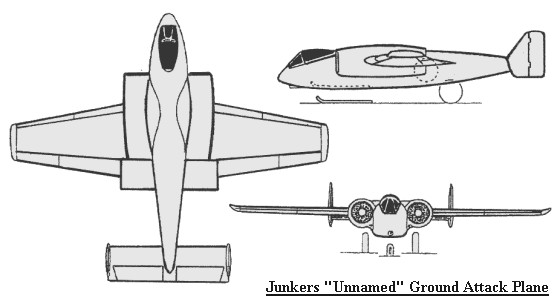
So, to spite the Army, the USAF created the A-X program to kill the Cheyenne and went back looking through old Nazi designs for a jet-powered Stuka.
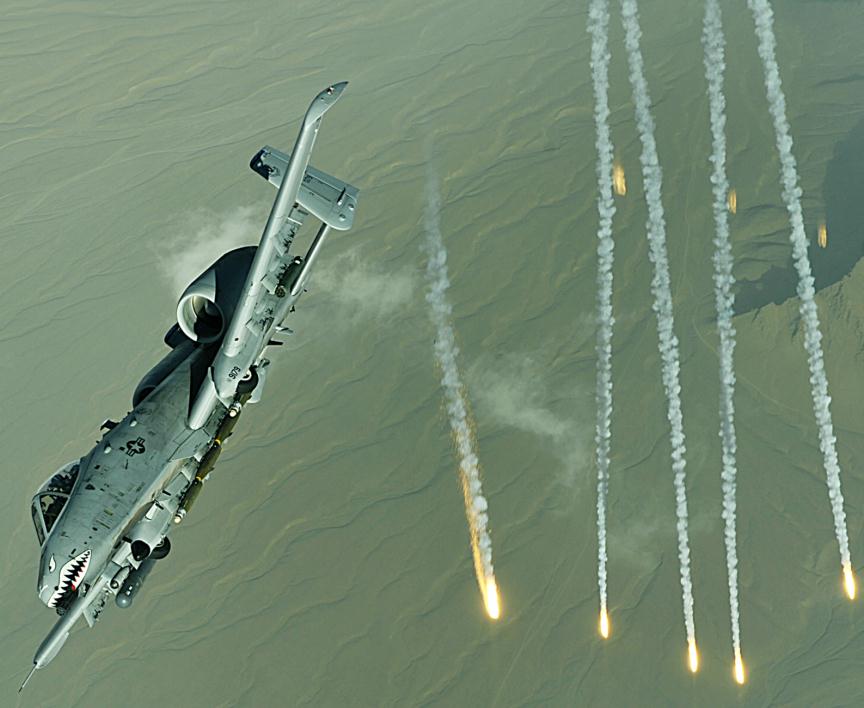
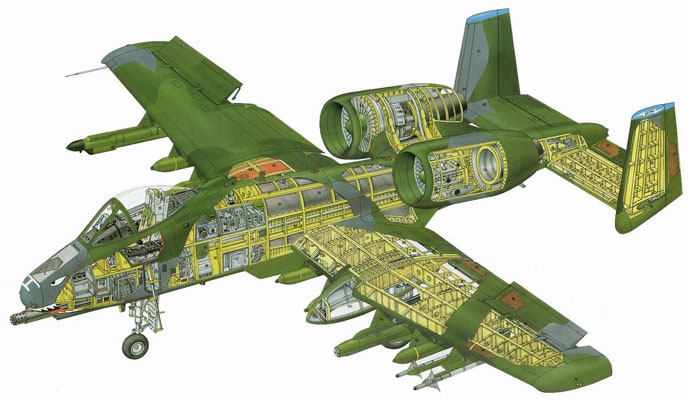
A neat feature of the A-10's design is that its main landing gear wheels stick out a bit from under its wings like the C-47 so if they cannot be lowered, the plane will still be able to roll to a smooth landing. This feature was just utilized a few months ago in Iraq.
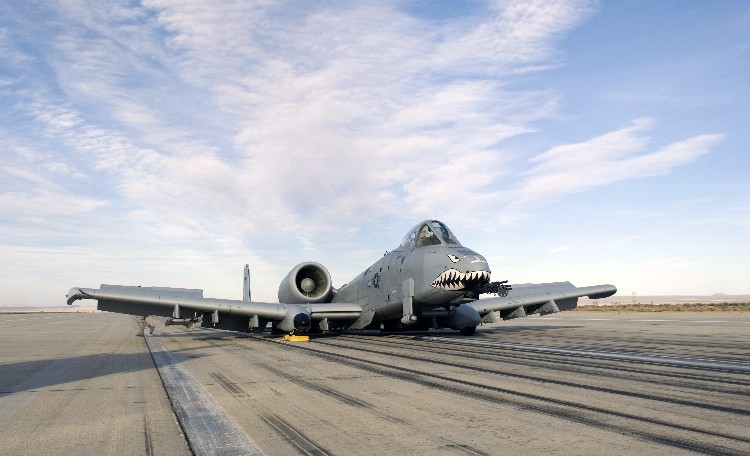
The Northrop A-9 had the fuselage-mounted engines of the German design and was later copied by the Russians into the formidable SU-25 Frogfoot CAS aircraft which has been highly successful in Afghanistan and more recently Georgia. Below is an amazing picture of an A-10 with SU-25s in the background for comparison.
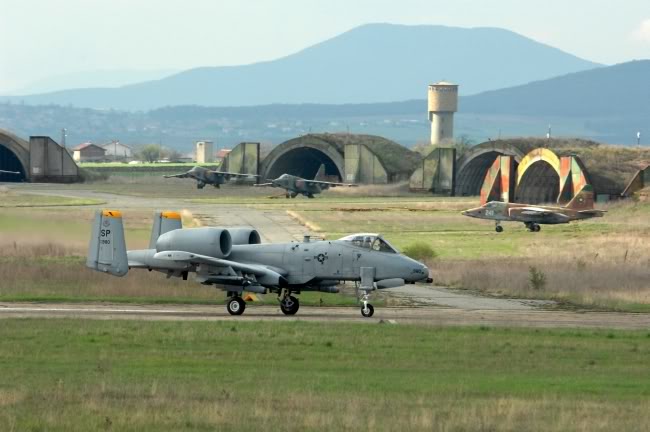
The A-X design chosen by the U.S. employed the twin-tail lay-out and became the amazing, Fairchild-Republic A-10. Congress funded over 700 and they are still in service today--reluctantly by the USAF until such time that they can get rid of them using the excuse of age. The USAF's plan is to replace armored A-10s that can fly low to render CAS with unarmored F-35As that can't. The A-10 can operate from short runways from forward air fields; the F-35A will need a long runway at a pampered pilot air base.
In the early 1990s, Congress saw through the USAF's BS at undermining the A-10 and the CAS mission and ordered it to turn-over one A-10 to the Army as each OV-1 Mohawk observation/attack (O/A) Grasshopper plane was retired. Now don't get me wrong, this retirement of OV-1s was wrong; the Army needs these planes to do AFAC work to direct A-10 and AH-64 strikes.
However, we know ALL of the Army's OV-1s were retired in 1996 and NOT A SINGLE A-10 went over to the Army.
WTFO?
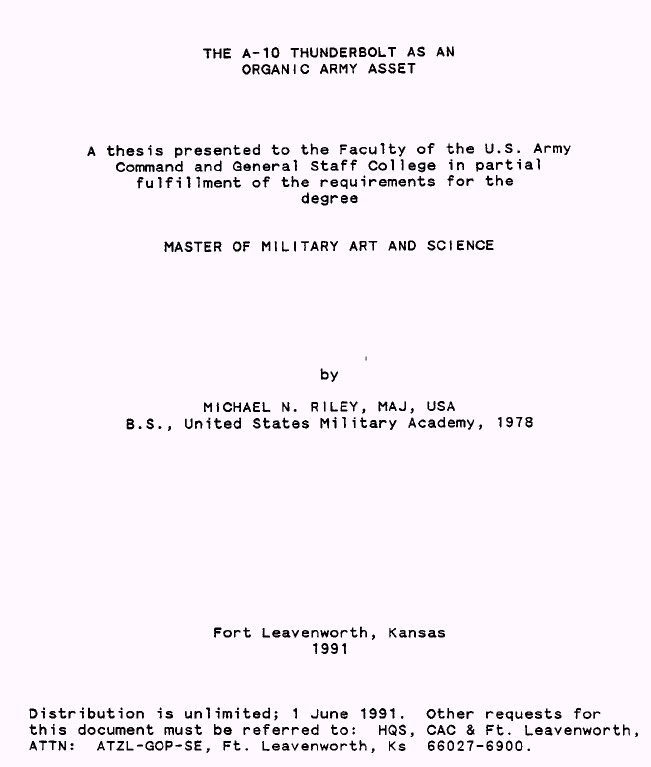

"THE A-10 THUNDERBOLT AS AN ORGANIC ARMY ASSET" A thesis presented to the Faculty of the U.S. Army Command and General Staff College in partial fulfillment of the requirements for the degree, MASTER OF MILITARY ART AND SCIENCE, MICHAEL N. RILEY, MAJOR, USA B.S., United States Military Academy, 1978 Fort Leavenworth, Kansas 1991
Our sources indicate a weak ego Army rotorhead fucktard nixed the plan to get the A-10s that combined together with AH-64 attack helos would have made the most powerful combination as the report above proves.
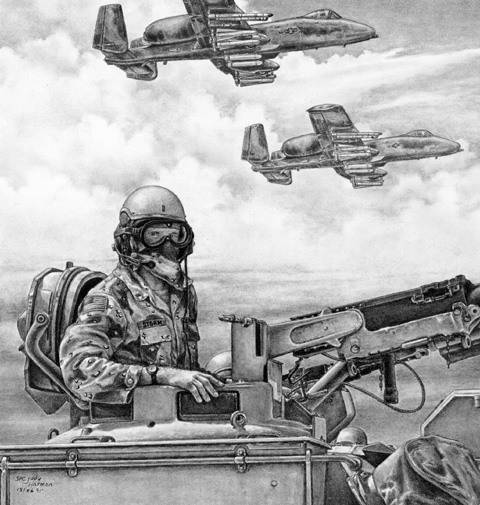
So now the fixed-wing A-10 has two enemies; the USAF fighter-bomber egotists who think it flies TOO SLOW and gets all the "action" helping the Army maneuver to take places like Baghdad--and Army rotorhead egomaniacs who think it flies TOO FAST and will make them look inferior. Never mind that Army A-10s would be flown by THEM--ARMY PILOTS.
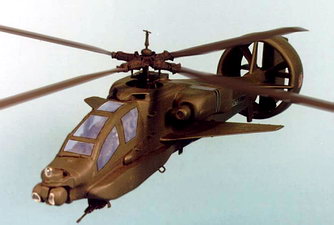
So today, we have Army AH-64 helicopter gunship aviators living in denial that their choppers fly TOO SLOW and need Piasecki Vectored Thrust Ducted Propellers (VTDP) kits to get to 250 mph to survive over the modern battlefield we knew was necessary even back during Vietnam. In fact, the Army rotorhead is so stubborn and refuses to adapt, he continues to fly in broad BLUE sky daylight in OD GREEN helicopters, yet wonders why he is getting shot down?. We have a fighter jock USAF that lusts for twin-engined, F-22s that we simply cannot afford at $100M each who wonders why he has less and less aircraft to fly as F-15s and F-16s begin to fall apart? All the fighter-bomber jock ego clubs (USAF, USN, USMC) eagerly await salvation from mass production of single-engine stealth F-35s whose flight performance is inferior to the thrust-vectored, canard SU-35 and must shoot the other guy down by radar-guided missiles from beyond dogfighting range. All pay lip service to CAS and think they will lob guided bombs from a stand-off distance for air support (SODAS) when its already a proven failure in Iraq/Afghanistan as it kills more innocent civilians than enemy soldiers.
The Russians have SU-25s OWNED & OPERATED by their ground maneuver elements. If the USAF wants to retire A-10s they should instead be transferred to the Army. New production models can be built by Northrop-Grumman who own the plans from defunct Fairchild-Republic. Even the centralization-crazy Israeli Air Force (IAF) is farming out fighter-bombers to ground units. We can have BOTH an air force to fight other air forces AND an air force that supports ground maneuver. CAS should be an U.S. Army mission empowered by the required fixed-wing Killer Bee attack planes that together with helicopter gunships make for the most powerful combination. Don't leave these force structure decisions up to weak egomaniac pilots to decide as per their prejudices.
www.globaltimes.cn/www/english/military/2009-07/442741.html
Each Israeli infantry battalion in war to have fighter jet: report Source: Xinhua[09:04 July 04 2009]
The Israel Defense Forces (IDF) has decided every single infantry battalion participating in war will soon have its "very own" Israel Air Force (IAF) fighter jet at its beck and call, waiting for its instructions to give it close air support, Israel National News reported Friday on its website.
If identifying a target it wants to use force from the air, an infantry battalion will be able to authorize the strikes easily and independently, without having to pass the order up through the chain-of-command, said the report.
Standing army battalions will receive this extra empowerment by the end of 2010, and reserve battalions will all receive it in the course of the next 3 years.
These goals were defined in the course of staff work currently being carried out by the Ground Force Command and the Air Force, with the goal of laying systematic rules of combat support for ground battalions.
According to the report, responsibility for directing the actions of the fighter jets supporting the battalions will be in the hands of the Artillery Liaison Officers (ALOs), because the Artillery Corps is responsible for elements of firepower from the regimental level downwards.
The ALOs will be deployed as part of an Aerial Direction Crew that will also include a communications operator and Assistant ALO.
The need for deployment of fighter jets in support of IDF battalions was one of the conclusions from the Second Lebanon War in 2006 and from Operation Cast Lead in 2009. As a first step, the IDF decided to embed close air support in the regimental level by creating the positions of Air Support Officers (ASOs).
The IDF has yet to decide whether the final authorization for attacks will be given by the ALO and the Battalion Commander, or by the ASO, who is in effect the IAF representative in the regiment.
It was decided that the fighter jet will attack ground targets at the request of the battalion commander only after other options have been tried, including the firing of "Gil" missiles, mortars, artillery and combat helicopters.
It was also decided that in certain cases, fighter jets will be allowed to attack targets that are less than 1,000 meters away from the IDF forces -- the minimum range of safety that was in force in the IAF until now.
The new orders apply mainly to combat in urban settings, in which most targets are situated at a relatively close range to the troops. Authorization for decreasing the minimum range of safety will only be given by the Division Commander.
To Optimize the A-10 it Needs a Back-Seat AFAC Observer--who says the USAF is interested?
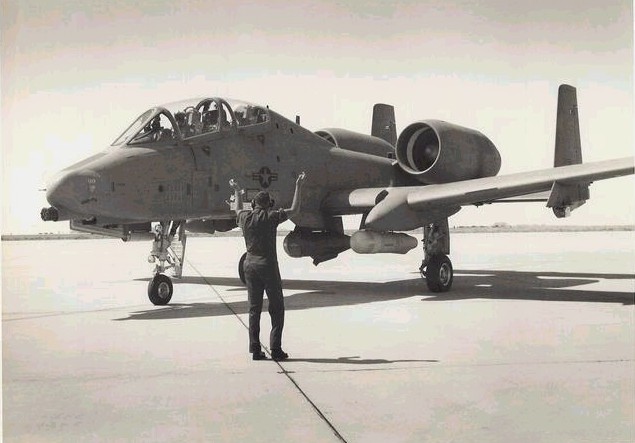
The sad truth is that the U.S. military has no 2-seat manned long loiter-time, fixed-wing observation/attack aircraft with the forced retirement of Army OV-1s and the self-inflicted retirement of Army OV-1s and Air Force/marine OV-10s. UAVs cannot see like human eyes can from an aircraft which can also investigate! Media pundits and technology worshippers are quick to offer an unmanned combat air vehicle (UCAV) as the salvation for CAS when anyone who has actually studied the X-45 program will see its not intended to nor does it have the capability to do active ground searching and attacking with its limited "tunnel vision". X-45 UCAVs are designed to take out fixed, prior known enemy air defense targets so the manned fighter-bombers can penetrate to do quasi-strategic bombing and battlefield air interdiction. The UCAV is not even close to providing CAS and no funds or efforts are being used in that direction. If we are going to have CAS for ground maneuver that encircles and collapses the enemies so they don't escape we better do something TODAY with existing manned aircraft.
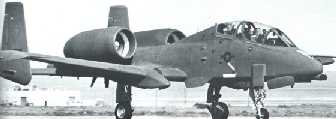
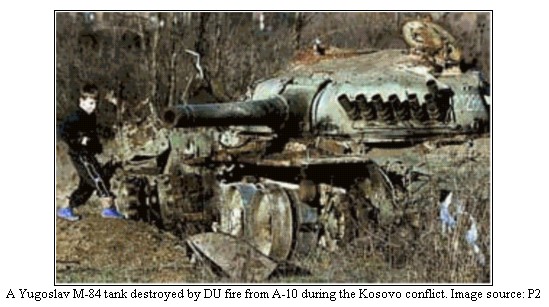
Even more troubling is that the AF has almost two hundred A-10s in mothballs and at least 1 or as many as 30 were two-seat types that could be used to house an aerial observer to render the kind of alert air support ground combat units need, freeing the pilot to fly the aircraft.
This state of affairs is not satisfactory with the new geopolitical situation where asymmetric, primarily light infantry enemies will seek to attack the U.S. while hiding behind difficult terrain, vegetation and civilian populations. The U.S. military must regain "air observational superiority" by fielding a two-seat observation/attack aircraft to win the war on sub-national terrorism or else the bad guys will continue to get away. In future nation-state combats, alert, agile CAS guided by Forward Air Controllers (FACs) in the air (AFACs) and on the ground (GFACs) will insure that friendly troops are not killed by "friendly" fires since over-relying on precision guided munitions to get accuracy without FAC help to get aircraft line-of-sight (LOS) means at least 10% of this ordnance will go out of control and could kill our men.
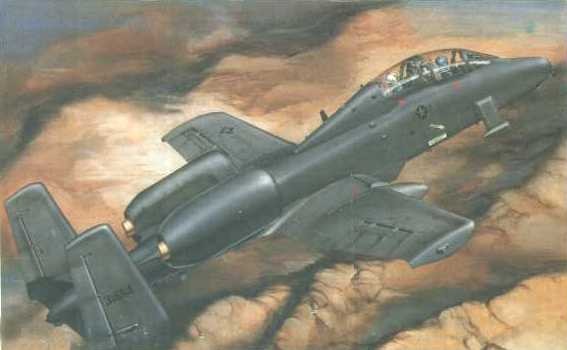
Therefore we propose:
1. All OA-10As be made into 2-seat OA-10B models for observer in back to spot targets
2. More powerful engines fitted to ALL A-10As and OA-10Bs
3. A Night Observation sensor package be fitted to the OA-10Bs
4. SLEP ALL A-10s so the aircraft can fly to 2050
5. Unused A-10A/Bs taken out of storage returned to flight status for AFSOC
6. Rebuild OA-10Bs "Warthog IIs" supplied to to AFSOC for deep-penetration helo/V-22 escort
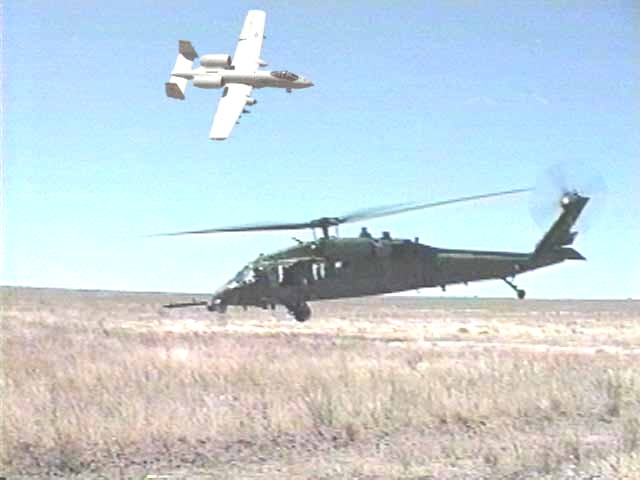
7. The synergism between Army attack helicopters and USAF A-10As/OA-10Bs exploit both aircraft's inherent STOL capabilities: "Cactus Air Force" Joint Air Attack Team (JAAT) to be forward-deployed with Army ground units to render better CAS and to evade asymmetric enemy attacks on fixed airfields
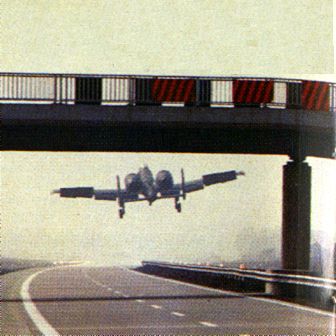
The revamped OA-10B should be capable of operating out of 3000 foot strip up to say 10000 feet density altitude at full loaded combat weight. (Equivalent to Cheyenne WY airport at 100F) Might take revised flaps to do that. Big fat tires, long stroke gear for bumpy runways/hard pan. Should be able to operate out of any assault runway suitable for C-130/C-17.
8. Comm/C4I Package- everybody talk to everybody else (UHF/VHF/FM/HFSSB) plus secure system. Data link. Secure nav system. Color TISEO synched with laser designator and the night observation system.
9. Air-to-air IFF. UHF/GPS/DF (find troops/CSAR survivors/other aircraft). Both IFR systems
10. Both "probe and drogue" and receptacle mid-air refueling.
11. Selectable ejection system.
12. Autopilot (long ferry flights, orbiting and looking out).
13. Wingtip AIM-9X air-to-air self-protection missiles or tiptanks - saves 2 stations for air-to-ground ordnance plus tip tanks increase ferry range over standard underwing drops. Rear quarter missile detection system.
14. Also needs a modular ECM/IRCM system capability to accept upgrades as they develop.
15. General Dynamics GAU-19/A .50 caliber heavy machine gun pods fitted to all A-10s to increase their gun strafing capability: this is the safest and most responsive fires for CAS. Their 2.75" Hydra 70mm rockets must up upgraded to laser guidance, also.
GENERAL DYNAMICS ARMAMENT SYSTEMS
Lakeside Avenue Burlington, VT 05401
Tel: 802/657-6841
Fax: 802/657-7493
nblancha@gdarm.com
Contact: Mr. Norman Blanchard
General Dynamics Armament Systems (GDAS) is a world-class defense company with a range of armament and munitions capabilities from 12.7mm Gatling guns to 155mm artillery projectiles. Its weapon systems are in production for aircraft, helicopters, vehicles and ships across all branches of the U.S. armed forces and more than 20 allied nations. GDAS has design, systems management and production expertise in all aspects of armament system development, including high rate of fire guns, gun barrels, ammunition handling systems, turrets, fire control computers, drive mechanisms, munitions demilaritization, ammunition and sensor integration. GDAS is a leading systems management company with the capability to integrate weapon systems on a full range of aircraft, naval and land-based platforms. Its products featured Eurosatory included HYDRA-70 rockets, reactive armor tiles, 120-mm mortar rounds, munitions demilitarization, GAU-19/A 12.7mm pintle systems and 40mm grenades.
16. A FAC Career field for non-rated officers instead of the grounded flyers who are now called Air Liaison Officers (ALOs) but frankly, unhappily filling a position in an ad hoc manner. FAC officers would also be OA-10B observers for a 20+ year USAF career and see to it that their enlisted FACs are taken care of and that their service area is vibrant and improved constantly with officer clout so the Army doesn't have to suffer from a lack of CAS as it has had to in recent years.
17. Decide on a single name for FAC/ROMAD/ETAC/TACs etc. and stick to it
We suggest the Army name-recognition term of "FAC" be used in two forms;
"AFAC" means an Airborne Forward Air Controller in the rear seat of an aircraft like an OA-10B
"GFAC" means a Ground Forward Air Controller on foot or in an armored fighting vehicle with laser ranging and target designation, and secure commo with all players in the air and on the ground.
It should be a JOINT term used by all the services in DoD. In fact, DoD should come up with standardized criteria for ALL AFACs and GFACs in use by ALL of the services.
Collectively, all the A-10 pilots, ground crews and observers would be termed "Air Commandos" in AFSOC, reviving a tradition lost when the A-1 "Sandy" SkyRaider fixed-wing prop attack and A-37B turbojet observation/aircraft were retired.
18. Enlistedmen would also be OA-10B observers so they have a perspective from the air, too. In fact, they should rotate tours of duty from inside the rear cockpit of the OA-10Bs and on the ground throughout their careers. This will also make this career field challenging and rewarding for all involved.
19. Fold A-10 wings during SLEP so they can have ground mobility via trailers. Add a tail hook for short field operations. Develop a centerline ordnance hard point to attach JATO rockets.
20. Regain PHYSICAL VISUAL MARKS for pilots, AFACs and GFACs to use.


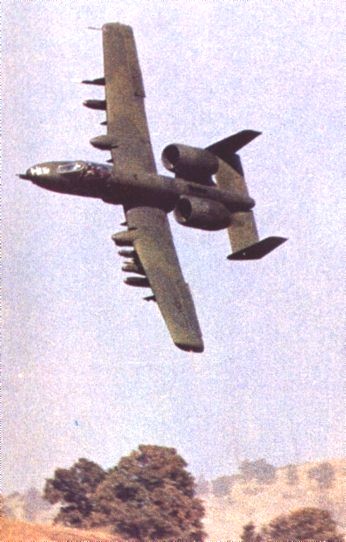
This OA-10A is equipped with 2.75" Hydra-70mm rocket pods with White Phosphorous (WP) rockets for AFAC work. However, with an overworked pilot trying to avoid flying into the ground, many of the A-10s fatal crashes could have been avoided by help from a back-seat air observer if A-10s for AFAC work were accordingly modified. Why do you think Army/marine AH-64 Apaches and AH-1 SuperCobras have two-man crews to help in ground attack? Why shouldn't the A-10 have a 2-man crew considering its GOING TWICE AS FAST AS THE U.S. ATTACK HELICOPTERS!

One of the erosions of the electronic, mental gadget RMA mentality is the devaluation of PHYSICAL, VISUAL means to mark targets for pilots to see them and control where their ordnance goes. We used to be very good in Vietnam designating targets with smoke rockets from L-19/O-1 Bird Dog "Grasshopper" aircraft flown by AFACs:
 www.youtube.com/watch?v=8MKQnqOuW10
www.youtube.com/watch?v=8MKQnqOuW10
Shining a laser beam requires SOMEONE to be exposed to get a line-of-sight (LOS) and the munition that follows the laser reflection off the target is not cheap. GPS both the human inputs (GIGO) and how the munition behaves can be off with deadly fratricide consequences as the reports on this web page show. The recent integration of laser target designators onto road-bound, immobile, wheeled trucks is the height of absurdity.
The excellent AFPAK photo web site (16+ pages)
http://cryptome.org/info/afpak-archive/afpak-archive-1.htm
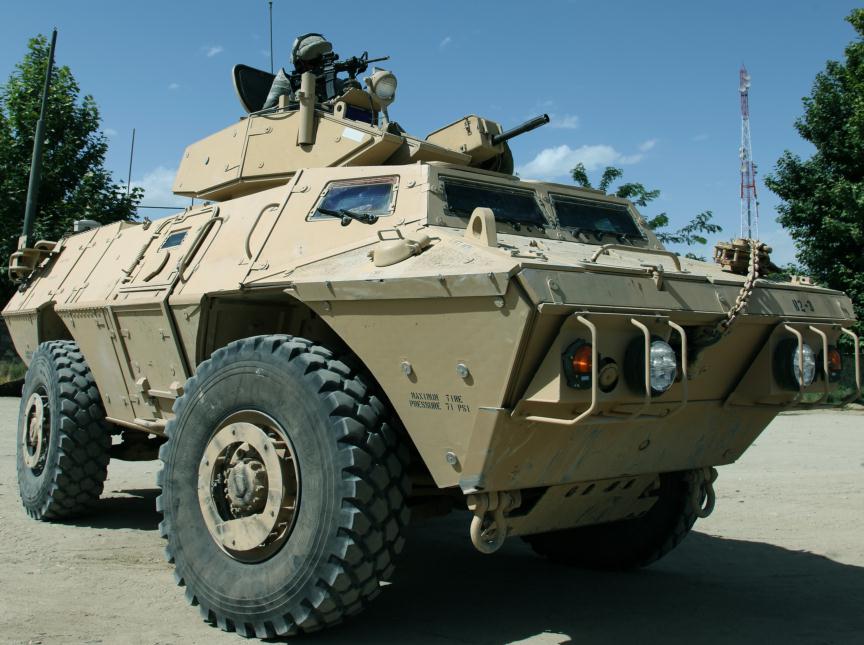


...shows the 4x4 ASV in action in Afghanistan where its wheeled handicap cannot gain a killing Line-Of-Sight (LOS) for its wimpy heavy machine gun and grenade launcher--much less LAZE for USAF bombs or Army missiles/rockets to strike.
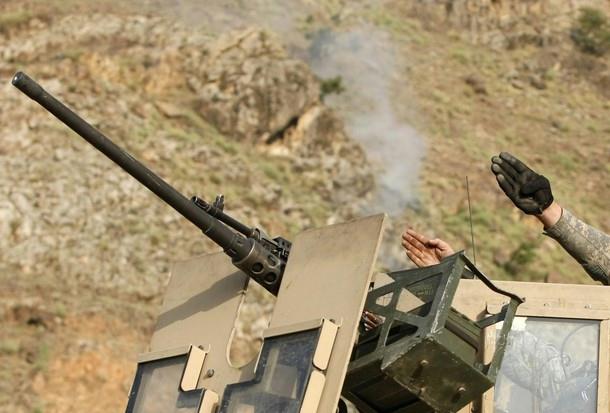
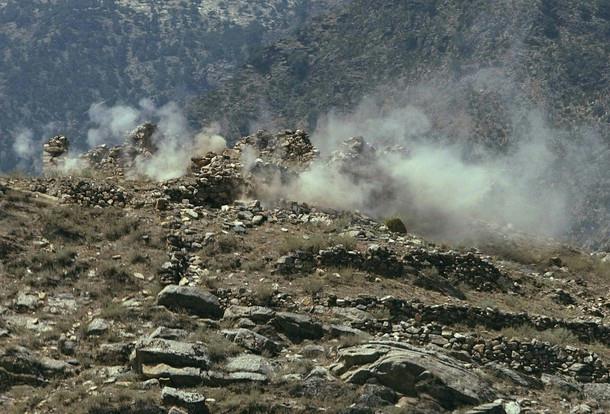
Notice how UNDERwhelming air strikes are in the AFPAK terrain which readily absorbs it.
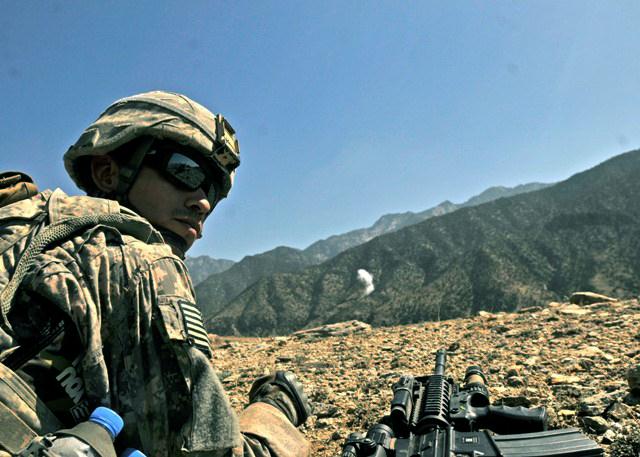
LOS must be good enough to get a direct path to the bad guys or else the terrain is just going to absorb it.
This is more wheeled narcissism by the light infantry mafia to further take over the Army from the tracked "mech pussies". Their hypocrisy in not following their own preaching to "stay off roads they are mined" reeks to high heaven.
The best application for CAS LAZE means is on a LIGHT tracked tank with MAXIMUM MOBILITY so it can gain LOS in as many situations as possible; and a GOOD LOS that kills not just absorbs our costly firepower.
StrategyPage.comDecember 22, 2009
The Armored Knights Keep Coming
The U.S. Army has ordered another 27 x M1200 Armored Knight vehicles, at a cost of about $370,000 each. These are wheeled armored vehicles, similar to the Stryker, that carry the equipment needed to quickly bring in guided bombs, missiles and shells. The M1200 contains a laser designator, a laser range finder and GPS, plus radios and computers that take target position data and transmit it to distant artillery units, or bombers overhead, and get the firepower on the target within minutes. Previously, all this gear was mounted on an unarmored hummer. But the M1200 enables the vehicle to operate in an area where bullets and shells are flying about, and still get the job done.
The armored vehicle the M1200 is built on the 4x4 LAV-150 Commando. This 11-ton vehicle mounts a machine-gun on the turret, but the real "weapons" in the turret are the laser designator and rangefinder. The laser designator enables the most precise smart bombs (that can be sent through small openings, like a window) to be used.
The first 19 M1200s were delivered two years ago, with another 40 last year and, eventually, 107. The M1200 carries a crew of three or four and, because most have seen duty in Iraq or Afghanistan, an IED jammer come as standard equipment.
 www.youtube.com/watch?v=RbWbkOkTydk
www.youtube.com/watch?v=RbWbkOkTydk
The IDEAL GFAC vehicle is a High Technology M113 Super Gavin Light Tank
If we'd drop the technohubris, we'd employ M113 Gavins as the universal GFAC ground mobility mount and provide them with roof-top M224 60mm mortars (M24 Chaffee light tanks and IDF Merkava heavy tanks have this) with smoke and white phosphorous bombs so we can clearly mark targets for air strikes like we used to do in Vietnam. A WP hand grenade is so lethal you can BARELY through it beyond its lethal radius. Therefore, the best WP self-mark for GFACs would be having M113 Gavins with M224 60mm mortars connected to a bracket or ground mount trigger-fired to indirectly project a nasty incendiary bomb that will clearly show a white smoke cloud above anyone and anything unlucky to be under it. We lost WP tank round point & shoot, direct-fire capability when we went from 105mm to 120mm and it behooves us to either develop a 120mm WP round or bring back 105mm via M8 Buford AGS light tanks--or BOTH.
Another visual mark we could gain is MARKER BALLOONS that the British used extensively in their COIN operation in Malaya to get a visual mark above jungle foliage since smoke grenades couldn't rise out.

Here's what jungle canopy looks like from the air over Vietnam....
Ironically, we contacted the Army years ago on creating a CAS marker balloon kit AND THEY AGREED, then promptly DID NOTHING about creating such a device.
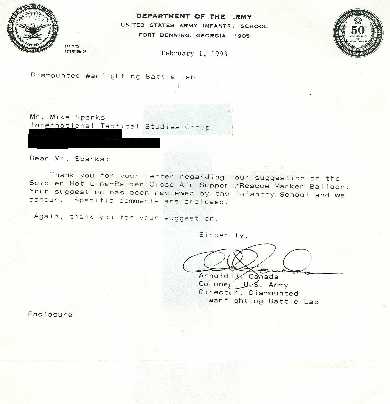
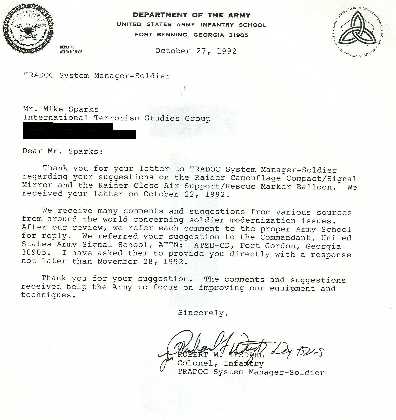
Despite U.S. Army Infantry Center stating an interest in marking balloons, nothing happened to make kits for this a reality and Mike found the following article in the Fort Benning Library when he was gathering up all of Colonel Hackworth's articles for him in 1997. The following article from the 1966 U.S. Army Infantry Journal shows that U.S. Army infantry units realized like the British in Malaya that they needed marker balloons for aircraft to see a distinct and clear mark above thick vegetation to render effective close air support. Why this equipment was not made a part of the tools available to the U.S. armed forces is a mystery and is something that still needs to be acted on today.
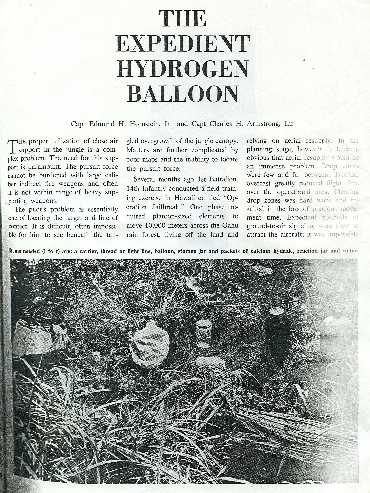
THE EXPEDIENT HYDROGEN BALLOONCapt Edmund H. Hornstein, Inf and Capt Charles H. Armstrong, Inf
The proper utilization of close air support in the jungle is a complex problem. The need for this support is paramount. The pursuit force cannot be burdened with large caliber indirect fire weapons and often it is not within range of heavy supporting weapons.
The pilot's problem is essentially one of locating the target and line of contact. It is difficult, often impossible for him to see beneath the tangled overgrowth of the jungle canopy. Matters are further complicated by poor maps and the inability to locate the pursuit force.
Several months ago 1st Battalion, 14th Infantry conducted a field training exercise in Hawaii entitled "Operation JAILBREAK." One phase required platoon-sized elements to move 10,000 meters across the Oahu rain forest, living off the land and relying on aerial resupply. In the planning stage, however, it became obvious that aerial resupply would be an immense problem. Drop zones were few and far between Tropical overcast greatly reduced flight time over the operational area. Clearing drop zones was hard work and resulted in the loss of precious movement time. Expedient methods of ground-to-air signaling were slow to attract the aircraft; it was impossible
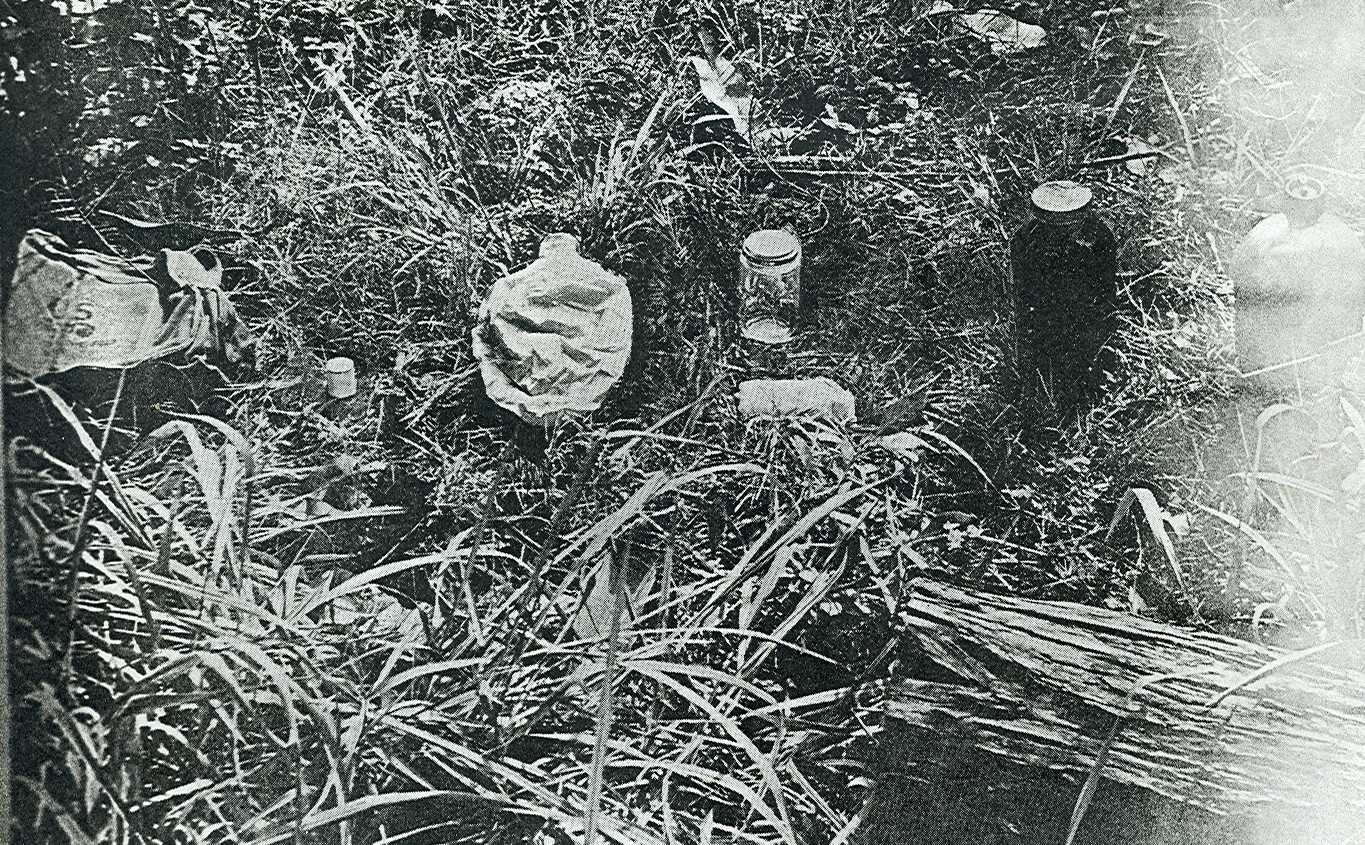
Items needed (L to R) are: a carrier, thread or light line, balloon, storage jar and packets of calcium hydride, reaction jar and water.
Page 27
to determine which patrol was signaling for what supplies. Dropping bundles on radio direction-finding was inaccurate. Sometimes it would take hours to recover a bundle dropped a few hundred meters off the mark.
A signaling expedient had to be devised that could be transported easily by the patrol, prepared rapidly and could be identified readily by the aerial observer. Thus, the idea of the field expedient hydrogen balloon was born.
If a device could be fabricated to yield hydrogen, the patrol could inflate a balloon, allow it to float above the jungle canopy on a light line and await the bundle drop. Each patrol could be identified by balloons of different colors.
After much experimenting the hydrogen problem was solved with calcium hydride (CaH2) which, when mixed with water generates hydrogen. The calcium hydride is readily available from metro elements, organic to division artillery and rocket battalions, or from any air base that utilizes weather balloons.
All that is necessary are 75-gram packets of calcium hydride (approximately three-quarters of a cigarette pack) wrapped in paper toweling to slow the violent, hydrogen-producing reaction.
A small baby food jar is used to protect the package until ready for use. A wide-mouth jar of pint or quart size (an APC bottle for example) makes an excellent reaction chamber or hydrogen generator.
The balloon may be either the 10- or 30-gram size also available from metro elements. Of course, the lighter the line, the less drag there will be on the balloon. The common gas mask carrier can hold 15 complete hydrogen-producing setups. The total weight is less than six pounds.
Activating the balloon is a simple five-step procedure:
1. Pour about three-quarters of a canteen of water into reaction jar. A half canteen will do but the more water, the less explosive the reaction.
2. Add calcium hydride packet.
3. Quickly slide balloon neck over the mouth of the jar. The hydrogen producing reaction will begin immediately. Hold the balloon in a raised position above the generator as the bottle will get extremely hot and could rupture the balloon on contact.
4 Wait approximately 10 minutes for the balloon to fill and cool. Cooling can be eliminated but the hot balloon may burst while ascending. By firmly shaking the jar you ensure maximum hydrogen yield.
5. Shake balloon slightly so that condensation formed on the inside of the balloon will drain back into the reaction chamber. Twist the neck of the balloon, remove from the jar and secure with a light line.
While inflating the balloon several safety precautions should be served. There should be no open flame or smoking near the operation.' Avoid bare skin contact with the generator jar during the reaction as it will get extremely hot. When the balloon is detached from the jar take care that drippings do not get into eyes. If only one generator available and it is desired to inflate
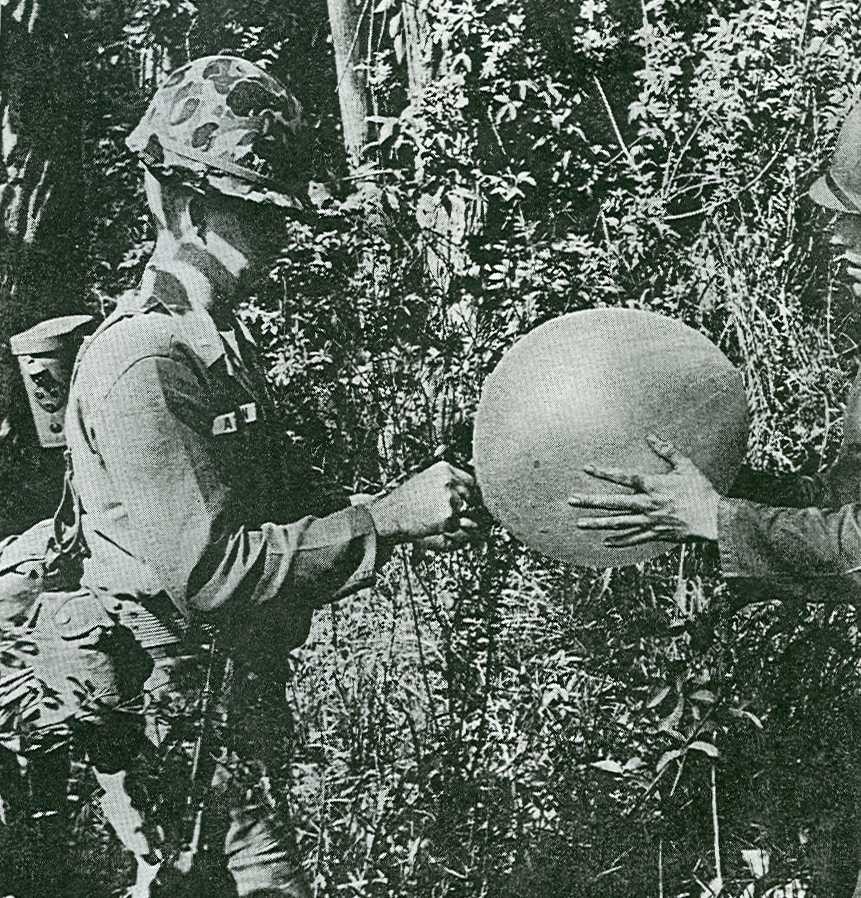
Page 28
another balloon immediately, the jar can it be cooled rapidly by filling with dirt and then washing. The balloons can be reused if necessary.
The best method for signaling is to allow the balloon to rise to an altitude of several hundred feet. Once detected by the aerial observer, the balloon is then reeled into position just above the jungle canopy over the desired drop zone. This compensates for balloon wind drift and ensures pinpoint aerial resupply, even though the aircraft pilot might never see a patrol member or any other DZ marking.
Another use for the balloon was discovered during the exercise. A small patrol without indirect fire support found a hidden guerrilla jungle base. The patrol activated a balloon, gave a compass heading and distance to the target area from the balloon, and radioed for a simulated ordnance and napalm air attack. The execution of the mission was perfect.
The system was even used with some degree of success at night. By using light-colored balloons it was found a strong flashlight beam could be reflected off the balloons and make them detectable to an airborne observer. The expedient rig we put together is by no means refined. For instance, there is no reason a metal container cannot be substituted for the glass jar.
The expedient was effective beyond our wildest expectations. By utilizing the expedient hydrogen balloons, the battalion was able to effect continual aerial support of a number of platoon-sized patrols in dense jungle. Without the balloons, this could only have been accomplished with great delay, if at all.

Page 29
DISCUSSION: Add to the list urban combat; its very hard to see friendly forces in tight alleyways surrounded by buildings; a colored balloon could solve this. The potential of a deliberately produced "CAS/MAS Marker Balloon Kit" is vast; the reaction jar can be lined with heat insulating material to be held without gloves. The balloons can be in myriad colors to include glow-in-the-dark for night signaling. A small chemlight could also be attached in visible or infared visible light giving properties. If the cord was a thin wire or a fiber-optic cable a small video camera could be held aloft for observation as a "hip-pocket" observation balloon capability. The point of all of this is that for CAS/MAS GFACs and Army Attack Pathfinders must get out of their VS-17 panel and radio and electronic gadget doldrums and use balloons as PHYSICAL marking means to better effect air/ground interface especially when amongst closed terrain clutter. Army Pathfinders and USAF CCTs use balloons to measure winds for parachute drops, why not for signaling to aircraft for CAS/MAS & resupply? We need human AFACs in the air to see the marker balloons to guide them in dropping supplies as well as ordnance.
Other World Armies Realize the need for effective CAS and DO SOMETHING ABOUT IT
We recently discovered we have counterparts in Australia!! Their Army Aviation Association has been fighting a battle to get their wannabe-lawn darts Air Force to provide CAS. In their excellent report, "The Tactical Air Support Group" they make some observations about the highly successful German Air Force/Army cooperation in WWII where ground troops served as air observers:
The Tactical Air Support Group
By O.M. Eather MBA.
www.fourays.org/archives/closeair.htm
"Examining the Luftwaffe's development reveals sound principles of tactical air support that were later reflected by other air forces as they sought to emulate the effectiveness of the Luftwaffe's 'Blitzkrieg' techniques. From the outset and in spite of the pervasive influence of classical air theorists, the German High Command realised that technical limitations would always constrain air power from being the decisive arm. Rather, the Luftwaffe would always act in concert with the Wehrmacht, and to a lesser extent, the Kreigsmarine. Great attention was paid to cross-training army officers and non-commissioned officers as observers in reconnaissance squadrons and, both in basic flying training and at the Air Command and Staff School, to train young flyers in 'the science of Army Tactics.' (Ref 15) This had the very real benefit of giving Air Force officers, particularly air crew, a proper military education grounded in an appreciation of those elements of their defence forces that were actually decisive.Mobility, short flight times and immediate reaction were required from the Luftwaffe to match this new style of fluid warfare. This necessitated minimal reliance on fixed bases by operational squadrons and co-location of Luftwaffe and Army headquarters to maximise effectiveness by minimising chain-of-command decision time. Squadrons followed their Army units or the unfolding battle, 'lodging' with independent airfield companies who operated and prepared tactical airfields. Difficulties arose when 'Luftwaffe command units were not based forward' but improved when forward command and control elements moved with the ground combat units.
Ultimately, in Greece and Russia, liaison teams and forward observers were in the frontline, directing aircraft to targets nominated by the immediate infantry or artillery regimental commanders. Also, in Russia, the value of smaller units, 2 to 3 bomb-carrying aircraft, was recognised in their greater flexibility, and manoeuvrability and that they could attend to targets too small for larger units.(Ref 17) The combined air and land forces of Germany were: 'Self-contained. Stukas, tanks, recovery vehicles, petrol wagons, anti-tank gunners, all went forward together and their senior officers were often in the van.' (Ref 18)
The German General Staff calculated that, between 1939 and 1942, aircraft were employed in the ratio of 5:4 for Strategic as to Direct Support roles. This would include fighter and suitable bomber aircraft detached after the air superiority battle was won. However, the actual number of aircraft used for direct Army support was more modest and could not, at any time, have been considered an imbalance against the Luftwaffe's other missions. At the beginning of the French campaign, of 3,824 operational aircraft, there were 342 dive-bombers, 42 ground attack and 501 reconnaissance. Similarly, in Russia, with 3,701 operational aircraft, 302 were dive-bombers and 593 reconnaissance. However, close tactical support is always accompanied by high attrition in aircraft; if not in crews, due to aircraft being downed from low-level and mostly in reach of friendly forces. By the battle of Kursk, both the Germans and the Soviets had come to expect destruction to be almost equal amongst aircraft and tanks. The Red Army fielded 3,600 tanks and 2,400 aircraft, the Germans, 2,700 tanks and 2,000 aircraft. So, whilst purpose designed close air support types have always been a small proportion of total air resources, in an intense surface battle, high levels of attrition of air assets, as well as armour and artillery, came to be expected and allowed for.(Ref 19)
The Luftwaffe was not merely an adjunct of the Wehrmacht. From the outset its doctrines were meshed to the theories of Douhet. Indeed, whilst those theories were seen as fundamental in defining the singularity of the service, the Luftwaffe contrived to be an effective mariner to reconcile the unique properties of airpower without ignoring the needs of the land battle or indulging in naive dismissal of surface forces as obsolete. The German Air Ministry field manual, 'The Conduct of Air Operations', which lay down doctrine, stated the overriding mission was to 'secure and maintain air superiority' and only then to provide 'combat and other air action supporting army forces on the ground'. The 'Air Field Manual No. 16' went further, stating the prime missions as 'strategic operations against sources of hostile military power' and 'attacks against targets in large cities.' (Ref 20) The Luftwaffe always figured about 40% of its strength would be bombers, 25% to 30% fighters, and the rest for the support of ground forces, including transport. Its first two phases of operations were to attack and destroy enemy air forces and aircraft factories and then 'vital centres'. But always included was the intention to aid the Army in its decisive engagements. For this reason, purpose-built aircraft, such as the Junkers 87 dive-bomber,", were permanently under command of the Army to 'concentrate all striking power' with the service best able to judge its effective application in the land battle. (Ref 21)
Control of the Luftwaffe was always at the highest level with the Commander in Chief of the German High Command and, whilst there was general agreement that Air Superiority forces stayed under the command of the Luftwaffe, fighter units were assigned to Army control when circumstances justified such a change. In effect, they became specialist Army units and both services planned and trained for this as a normal part of operations. The Army local commander directed Luftwaffe units as he was best qualified to direct their activities, whilst in no way interfering with the technical command of Air units.(Ref 22) It is a common fallacy that the Luftwaffe was only ever the air arm of the German Army. Examination of its own doctrine refutes this. Its performance in gaining air superiority in Europe, from 1939 to at least 1943, and in the Western Desert up to the First Battle of El Alamein, and then its consistently determined defence of Germany against the Allied bomber offensive, gives the lie to such criticisms. But it never lost sight of the inescapable reality that, if ever it was to be credible, it must be part of the land battle. It took the Air Forces of its opponents several galling years to reach the same conclusion and to begin to copy the principles that the Luftwaffe had established for effective support of the Army.
The principles that the Luftwaffe experience showed to be successful in the Air Arm's support of the land battle can he now drawn. Those principles, for the use of air assets for Close Air Support, are:
a. Operational command by Ground Force Commander.
b. Forward location, preferably within short flight time of in action combat elements.
c. Control by Air Arm personnel or fire support control specialists with leading combat elements.
d. Maximum and early use to assist in either breakup of aggressive enemy ground concentrations or, in assault, breakthrough with disabling concentration and surprise.
e. An irreducible proportion of specialist Close Air Support aircraft, organic to the Ground Force and commanded by it and not available (or suitable) for Control of the Air tasks.
f. Side-by-side location and direct command links between Ground and Air
20. GFACs must have not only SOFLAM laser rangefinders and target designators but M224 60mm mortars which can trigger-fire colored smoke bombs (prevent spoofing) to in a "low-tech" way mark targets for CAS aircraft to strike. If we had Army M8 Buford AGS light tanks and M1064A4 Gavin 120mm mortar vehicles with turrets shooting White Phosphorous (WP) rounds this would be another clear mark for CAS aircraft to aim in on.
A multi-war CAS attack pilot writes about GFAC to AFAC radio "talk-ons":
"Been thinking over troubles I experienced with green ALOs and here's a technique.
Presupposing the guy on the ground has a laser ranger (available even from Cabela's, etc) and a field compass he can give both magnetic azimuth and a good range to the target for the CAS pilots. I know the ones I've seen advertised only go out to 800 yards but surely that is pretty good for field use. And who knows? Maybe the manufacturer can tweak the thing to go out further or we can buy an expensive binocular with laser rangefinder like the Leica VECTOR used by Canadian snipers in Afghanistan.
On another track, the big problems was that green guys on the ground saw landmarks with a different idea as what stood out than the guy in the air saw. Quote from a ROMAD in Korea - 'we're up the little canyon off the big one' Hell, Korea is full of canyons of all sizes and from the air they look like roots from a tree . . .we did get it straightened out but it took a while. Also - 100 meters on the ground and eyeballed from the air can be wildly different. I once had a USAF FAC (new guy) almost run me out of bombs before we got on the target, dropping one at a time and moving "50 meters" (?) each time. (He wasn't very good with his smoke rockets either).
A good mark is a great start.
Another super technique is sort of a 'delayed TOT'.
If the fighters know where the GFAC is, they can give him an ETA - the GFAC can give the CAS a target azimuth and range or a vector off a prominent landmark, mark the target (laser or pyro) when the fighters are 4-5 miles out (30 seconds) and give the bad guys a real surprise. At an attack speed of 550 or better the airplane gets there at about the same time as the sound of an exploding smoke bomb/rocket. Only works for ordnance that is cleared for release that fast (unless the CAS has balls) - doesn't work for high drags cause the fins can fail above 450 mph. But slick bombs, rockets, strafing, cluster bombs [CBUs] all work just fine when released supersonic."
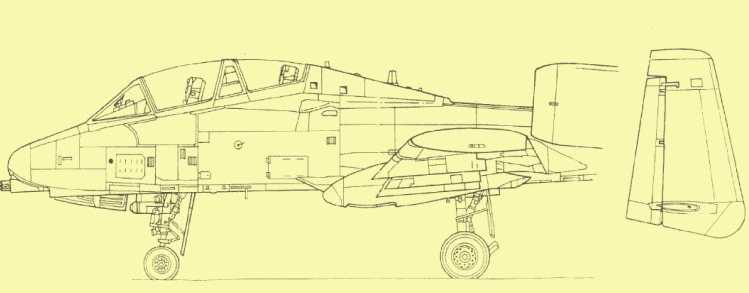


www.aerospaceweb.org/aircraft/attack/a10/index.shtml
Once we have the "Air Commandos" in place with upgraded OA-10Bs with AFAC in the rear seat and GFACs on the ground designating and ranging with lasers, we would normally have an OA-10B flying continuously overhead of friendly ground maneuver troops. The RAND enemy Air Defense-is-doomsday crowd should take note that the A-10s would be primarily BEHIND friendly lines and not subject to all the nasty missile and gun weapons systems they read about in Jane's and work into expensive DoD-funded computer simulations of worse-case "boogie man" nation-state threats.
If targets appear and are requested to be struck, the OA-10B can immediately take care of small targets with its 30mm cannon and twin underwing GAU-19/A .50 caliber Gatling gun pods and laser-guided Hydra-70mm rockets. If the target needs more firepower to be suppressed/destroyed, the OA-10B can shoot smoke rockets to assist other fighter-bombers like F-15E Strike Eagles or other single-seat A-10s to hit the target with guns, rockets and with controlled bombs.

MODELLING THE OA-10B: Click to enlarge image of the mighty OA-10B!
Chinese communist Trumpeter models make a large 1:35 scale two-seat OA-10B which you can buy from Squadron in Texas.
www.squadron.com/ItemDetails.asp?item=TR32215
1/32 (54mm) Scale
Manufacturer: Trumpeter from China
Subject: A-10 Thunderbolt DoubleSeat
Stock No: TR32215
Type: Aircraft Models
Description: A-10 Thunderbolt Double Seat. 1970s experimental USAF night/all-weather attack a/c based on A-10. Detailed exterior w/ engraved panel lines. Detailed cockpits, engines, and landing gear. USAF mkgs. See Review by ModelingMadness - Roberto
MSRP: $109.95
Your Price: $98.96
Here's pics of the OA-10B model we built:
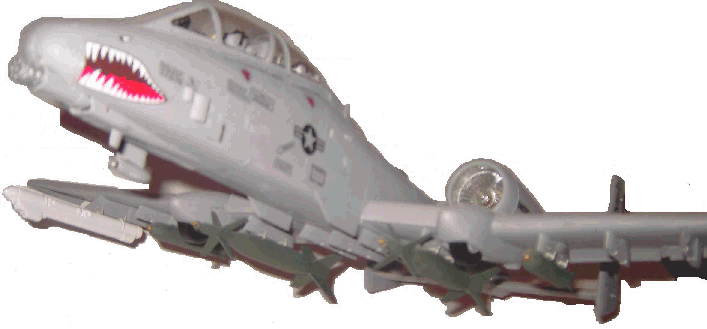


Toys R US also offer a remote-controlled two-seat OA-10B in tan that we repainted to look more realistic. Here's a pic of their AIR FORCES line of aircraft so you know what to look for in the store except look for a tan two-seat OA-10B.

Here's what it looks like now after a "MAS make-over"
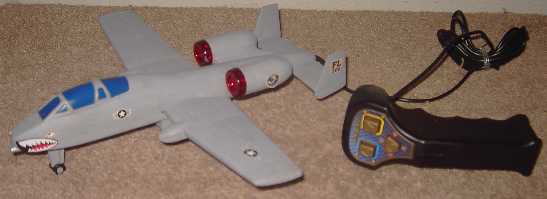
MAS Details:
The Precision Firepower Myth is a recipe for disaster
The current media feeding frenzy over expensive guided munitions hasn't factored in the many friendly deaths these bombs have inflicted on our men and WHY.
1. JDAMs are not terminally guided with only internal GPS and INS guidance and can go astray killing our own troops. Terminally guided means a FAC on the air or ground designates the target shining a laser beam and the ordnance flies directly to this spot and/or the FAC radio-directs the attack aircraft to a SAFE LOS attack path parallel not perpendicular to the friendly troops. A First Sergeant in the 101st Air Assault Division writes:
"Equipment wise, our greatest shortcomings were optics and organic or direct support long-range weapons. After the initial fight all our targets were at a minimum of 1500m all the way out to as far as you could see. Our 60[mm] and 81[mm]'s accounted for most of the kills. Next was a Canadian Sniper team with a MacMillian .50 cal [sniper rifle]. They got kills all the way out to 2500m.
The problem with our mortars was there as a 24 hour [Close Air Support] cas cap. And they wouldn't fly near us if we were firing indirect. Even though our max ordnant: how high mortar rounds arc into the sky] was far beneath their patterns. Something for you and your alo [Air Liaison Officer] to work out. The other problem was the Air Force could never fly in small groups of personnel, I watched and called corrections on numerous sorties and they could never hit the targets. My verdict is if you want it killed use your mortars. Pay close attention to ti-hz direction of attack your ALO is bringing in the CAS. Every time it was perpendicular to us we were hit with shrapnel. Not to mention the time they dropped a 2,000 lbs [bomb] in the middle of our company, it didn't go off by a sheer miracle I'm sure. [Marine] Cobras and 2.75" [rockets] shot at us. Also, once again, they were shooting perpendicular to our trace. Aviation provided the most near misses of all the things we did".
Below is a story on how a JDAM killed some of our men recently...
3 Special Forces killed, 19 wounded by friendly fire
Fort Drum Soldier dead

http://cryptome.org/info/afpak-archive/afpak-archive-14.htm
Medical people at Ramstein Air Base, Germany, transport one of the 19 servicemembers who were injured during a friendly-fire incident in Afghanistan on Dec. 5, 2001. Fourteen of the Soldiers arrived at Ramstein on Dec. 7 aboard a C-141 Starlifter from McGuire Air Force Base, N.J., and were transported to nearby Landstuhl Regional Medical Center for treatment. The Soldiers, all members of elite special operations units, were injured Dec. 5 north of Kandahar, when ordnance dropped from a B-52H Stratofortress inadvertently struck near their position. The friendly-fire incident is currently under investigation. (U.S. Air Force photo by Master Sgt. Keith Reed)
By Staff Sgt. Marcia Triggs
WASHINGTON (Army News Service, Dec. 5, 2001) - Three Special Forces Soldiers were killed and 19 were wounded north of Kandahar, Afghanistan, when a 2,000-pound U.S. bomb missed it's target and hit in close proximity to friendly forces Dec. 4.
The names are being withheld until next-of-kin notifications have been completed.
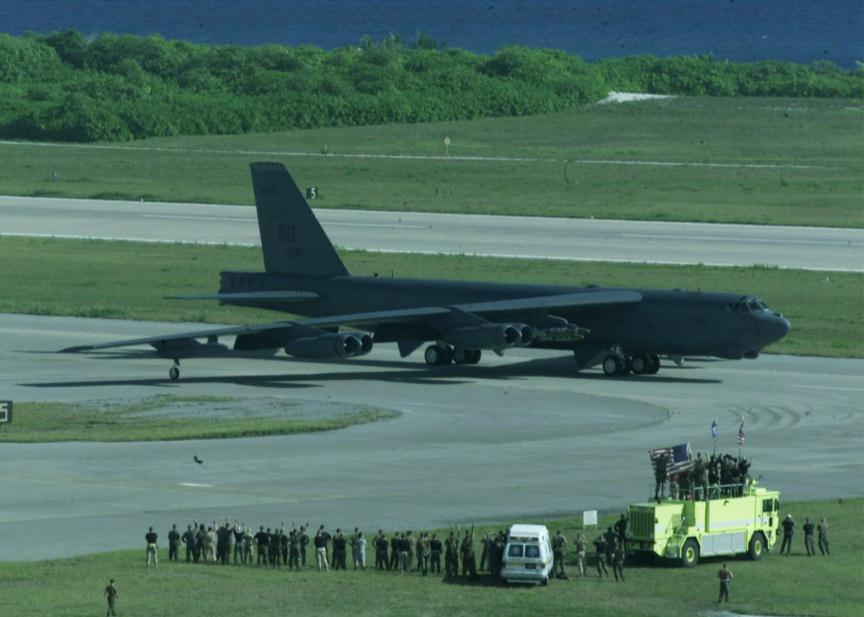
A B-52 that was called in to provide fire support to ground forces who were under fire, reportedly dropped it's ordnance about a football field away from two Special Forces teams and Afghan opposition fighters, officials said.
Two Soldiers were pronounced dead at the scene, and the third Soldier died while being transported to a medical facility in the region, officials said. Five Afghan opposition fighters were also killed and an unknown amount wounded, officials said.
"A close air-support strike is one of the most potentially hazardous types of missions used," officials said. "Simultaneously calling in air strikes on your own position and the enemy's position that you're engaged with takes very fine control, coordination and precision. Unfortunately, it doesn't always happen without causing our own casualties."
Officials said they would not speculate on the reason the precision-guided bomb missed its target, whether the wrong coordinates were given, wrong coordinates were entered on the plane or the system malfunctioned.
A second bomb was also dropped and it did hit the intended target, but officials said they did not know how much damage the bomb inflicted on enemy forces.
Since the war began this is the second U.S. bomb that has missed its target and hit in the proximity of U.S. troops. A stray bomb hit four Soldiers and an airman while they were helping Northern Alliance forces fighting armed Taliban captives in a fort near Mazar-e Sharif.
In an unrelated incident, an infantryman from the 10th Mountain Division, Fort Drum, N.Y. died Nov. 29 in Uzbekistan. Pvt. 2 Giovanny Maria, 19, was a native of Camden, N.J., and had enlisted in the Army in May.
Although the incident in under investigation, Maria's death was not the result of enemy action, officials said.
Link to original news item:
www.dtic.mil/armylink/news/Aug2002/a2002080282ndided.html
www.cbsnews.com/stories/2003/04/10/48hours/main548724.shtml
Fog of War: Facing Friendly Fire
Mistakes Still Happen In Battle
By Rebecca Leung(CBS) Even with all the modern weapons of this war, warriors are still bedeviled by old-fashioned problems.
It happened just this week. In Northern Iraq, a convoy of U.S. Special Forces Soldiers and Kurdish allies was attacked by American bombs. Eighteen Kurds were killed and more than 45 injured, including the brother and son of a Kurdish leader.
The weapons fired in this war are supposed to be precision guided and pinpoint accurate. But mistakes still happen. Correspondent Richard Schlesinger reports.
U.S. commanders think a sophisticated American anti-missile battery brought down a fighter plane, killing the pilot. In all, roughly 40 coalition Soldiers have been killed by accidents and what's been called "friendly fire."
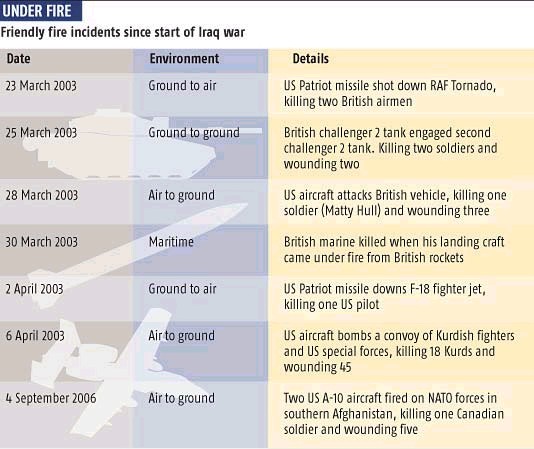
"There have been friendly fire incidents in every war in the history of mankind," says Defense Secretary Donald Rumsfeld.
"There are portions of this battle space that enormously complex. Human beings are human beings, and things are going to happen. It has always been so, and it will be so this time."
The Pentagon has been able to eliminate much of the mechanical error in warfare. Satellite-guided bombs, for instance, can be programmed to hit within feet of a target -- and 12,000 of them have been dropped so far.
But, it's human error that can't be eliminated.
Captain Jason Amerine is a Green Beret and knows the price paid when smart bombs go astray.
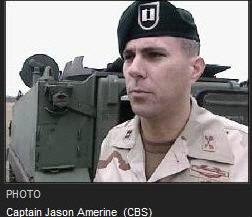
"It's only a tool that's as good as the people actually using it," says Amerine.
Amerine was commander of the Special Forces unit sent into Southern Afghanistan in November 2001 to link up with pro-Western leader Hamid Karzai. His mission was to assist Karzai in organizing a rebellion against the Taliban.

He credits their quick success to the role of air power and satellite-guided bombs.
"Those pilots kept my team alive while we were out fighting the Taliban," says Amerine, who credits their quick success to the role of air power and satellite-guided bombs. "They kept Hamid Karzai alive. If it wasn't for those aircraft, we wouldn't have been as successful."
By Dec. 5, 2001, they were just 18 miles north of Kandahar, a key city, and just days away from a complete Taliban surrender.
"We knew there was Taliban positions across from us," says Amerine. "We desired to continue to pound those positions to let them know it was a good idea to leave."
One of the Soldiers traveling with Amerine's unit transmitted their location and the enemy's location to a B-52 circling above. It was standard procedure...but this time something went terribly wrong. A bomb was programmed with U.S. coordinates and sent hurtling toward Amerine's unit.
"The bomb actually struck our hill," says Amerine, who flew through the air and landed on the ground. "It was a mess, carnage. It was the most horrible thing I've seen in my life."
23 Afghan fighters and 3 Americans, Sgt. Daniel Petithory, Master Sgt. Jefferson Davis and Sgt. Cody Prosser, were killed. Another 37 were wounded, including Amerine. Luckily, Karzai escaped with just cuts on his face.
"The same day we were bombed, Kandahar sent a delegation to surrender the city to Karzai," Amerine remembers. "The day we were bombed, our mission had ended."
The accident could have been caused by human error, or as CBS News reported, the problem could have been faulty batteries that interfered with the guidance system.
The military insists mistakes with these bombs are rare. Figures show these weapons are 90 percent accurate. They are unquestionably among the most precise weapons in the history of warfare.
But Amerine and the men in that Iraqi convoy learned tragically that even the most sophisticated weapon has to be aimed by people -- and people make mistakes.
The CBS article is incorrect; there are additional MECHANICAL problems with guided munitions--they will sometimes bump into each other upon release from the aircraft. Trying to blame all PGM fratricide on human error to subsidize technohubris is immoral and dangerous.
2. Trying to STEER bombs and missiles from a distant, offset location is problem-prone and gets worse the farther away you try to do it. Alleged "Precision" guidance on munitions has led to a lack of appreciation for the CAS strikes being guided by a FAC on the ground be it radio verbal directions and/or a laser spot for terminal guidance so the PHYSICAL aircraft delivery platform is lined up on the target so there is less physical "murphy" things that can go wrong. Munitions still bump into each other on release from the rack and fins get bent for example.
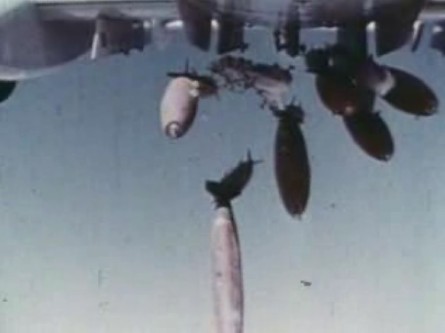
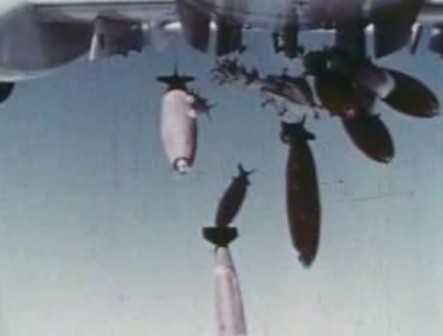


Former USMC Captain Carlton Meyers writes:
"G2 gem: GPS Guided Munitions and Fratricide
The May 2002 issue of the Marine Corps Gazette has an interesting article by LtCol John T. Rahm entitled: 'Bombing Accuracy for Idiots'. He points out the circular error probable (CEP) is commonly used to measure the accuracy of a weapon. However, he points out that "probable" means the circle, often very elliptical, where 50% a projectile or bomb is likely to hit. While that was good for ballistic weaponry, it is very misleading for GPS guided munitions. While they have great CEPs, many of their guidance systems malfunction and the bomb goes miles off target. LtCol Rahm states that testers disregard such failures when measuring CEPs anyway, and he worked at China Lake were the testing occurred. He writes this makes them too dangerous for close air support.
This explains the frequent 'mistakes' in Afghanistan where bombs landed far from any real target. The complexity of GPS guided bombs like JDAM, or the Navy 5-inch ERGM still under development, or the proposed 155mm Excalibur will often lead to friendly fire casualties which may be caused by any of these factors: a defective guidance system; a guidance system damaged during transport or installation; an incorrect GPS coordinate sent by the targeting system; and incorrect GPS coordinate entered into the bomb; GPS signal interference from nearby mountains, buildings, or solar flares; or GPS signal jamming. So if an aircraft drops a GPS guided bomb from several miles away, any guidance problem may prove disastrous. Even if 90% work great, that loose 10% may prove too dangerous".
Even the USAF is grudgingly admitting that it needs men on the ground to call in strikes:
European Stars and Stripes
August 15, 2002
Afghanistan War Showing Air Force The Importance Of "Eyes-On-The-Ground"
By Lisa Burgess, Stars and Stripes
ARLINGTON, Va. - Afghanistan has added a "new wrinkle"; to the Air Force's basic doctrine, according to the service's top analyst for the war on terrorism: Wars aren't won by air alone.
The rugged and unforgiving mountains of Central Asia have revealed many hard truths to each of the services. But for the Air Force, perhaps no single lesson resonates more clearly, Col. Fred Weiners said Tuesday: "Eyes-on-the ground" are essential to round out the advanced space- and air-based sensors, weapons and platforms that make up the service's inventory.
"You can have all the high technology you want, but it's these 25-year-old staff sergeants on the ground making strike decisions" that, according to Weiners, have in the past been made by high-level planning officers located nowhere near the battlefield.
Weiners is acting director of the Air Force's Task Force Enduring Look, and spoke with Stripes in an interview in his office in Arlington, Va.
Air campaigns traditionally have been planned in advance. Coordinates have been known, and target sets could be chosen from data gathered weeks or months in advance.
To hear an Air Force official emphasizing the need for "boots-on-the-ground" is a significant shift in conventional U.S. military thinking.
The Army and marine corps both are founded on the principle that war is never won until "boots-hit-the-ground" - when military personnel actually occupy the turf. The Air Force has tended to be dominated by officers who believe air operations alone can conquer an enemy.
In Afghanistan, however, forward air controllers and special operations forces -not planners sitting in Washington with maps and satellite photographs - have been responsible for almost all critical targeting calls, Weiners said.
"They are our most versatile and highly sophisticated sensor, and they are proving highly effective," Weiners said. "They dramatically enhance overall air power and bombing effectiveness."
Thanks to ground controllers, "We've enjoyed an accuracy like we've never enjoyed," Weiners said - and not only due to more sophisticated "smart" bombs, such as the Joint Direct Attack Munition.
Sensor-To-Shooter Loop
But Afghanistan also revealed a critical break in this "sensor-to-shooter" loop: Air Force pilots had not had enough practice working with the ground operators, particularly the special operations forces.
The service has moved with extraordinary speed to remedy that deficiency, Weiners said.
His task force first identified the need for more pilot training with ground forces in January, and by June, pilots at the Air Force Weapons School at Nellis Air Force Base, Nev., were "engaging special operations forces on the ground, including full mission profiles and simulations, to replicate what we were doing [in Afghanistan]."
Not every lesson coming out of Afghanistan is revolutionary. Much of what the Air Force is gleaning validates tactics and technologies that have worked well in exercises, but never have been proven in combat, Weiners said.
One especially critical validation to come out of the Central Asian campaign is proof that the Air Force's Air and Space Expeditionary Forces, which were designed for peacetime, also work in war, Weiners said.
As the Defense Department continued to pull back from its overseas bases throughout the 1990s, Air Force leaders decided they needed a way to keep the increasingly home-based service ready for action.
C-17 Proves Itself
One example: Afghanistan is the first major conflict for the Pentagon that has required "everything to come in and out by air," Weiners noted.
The Air Force's newest transport, the C-17, was key, Weiners said.
"The C-17 really proved itself, given the austere nature of our bases" in Central Asia, he said.
Creative aircrews also have found ways for the C-17 to perform that its designers never anticipated, Weiners said, citing in particular its function as a "mobile filling station."
Afghanistan has no fuel supply infrastructure, and roads there are so treacherous that trucking large amounts of fuel in is out of the question.
That means every drop of aviation gas and jet fuel needed by the U.S. forces is supplied by the Pentagon's fleet of KC-10 and KC-135 tanker aircraft.
Meanwhile, Army and marine helicopters and the assorted special operations aircraft stationed at the rough airfields that dot Afghanistan "need a lot of gas," Weiners said.
During Operation ANACONDA in March, when fuel was at an absolute premium, an unknown airman came up with a novel idea to get fuel to the fighters quickly: Combine the C-17's ability to land almost anywhere with its large fuel tanks.
"We would park a tanker in an orbit, and the C-17 would go up, tap the tanker, land and off-load the fuel - and now you have avgas [aviation gas]" where tankers can't land, Weiners said.
Bombers With Eyes
Another much-discussed evolution was the decision to use of Cold-war era strategic bombers in tactical combat.
The Air Force's B-1, B-2 and B-52 bombers all were originally designed to deliver nuclear munitions in end-of-the-world scenarios.
In Afghanistan, however, Air Force officials took advantage of the bombers' extensive payloads, range and high-altitude capability to deliver lethal strikes on enemy forces - all while being directed by ground-based forces.
The bombers proved very effective, Weiners said.
"The B-1s and B-52s flew approximately 10 percent of the sorties and delivered close to 60 percent of the weapons," Weiners said.
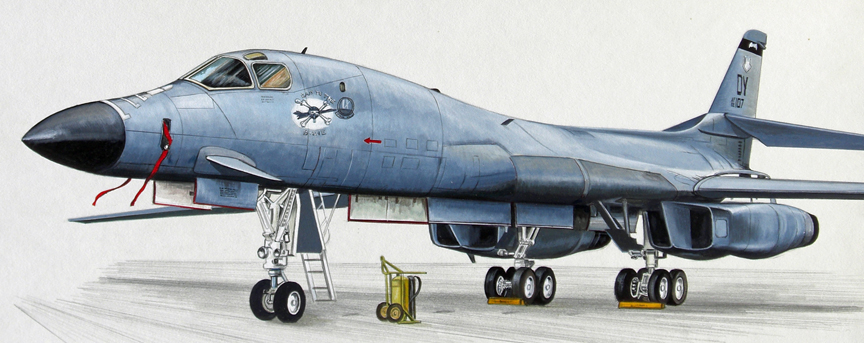
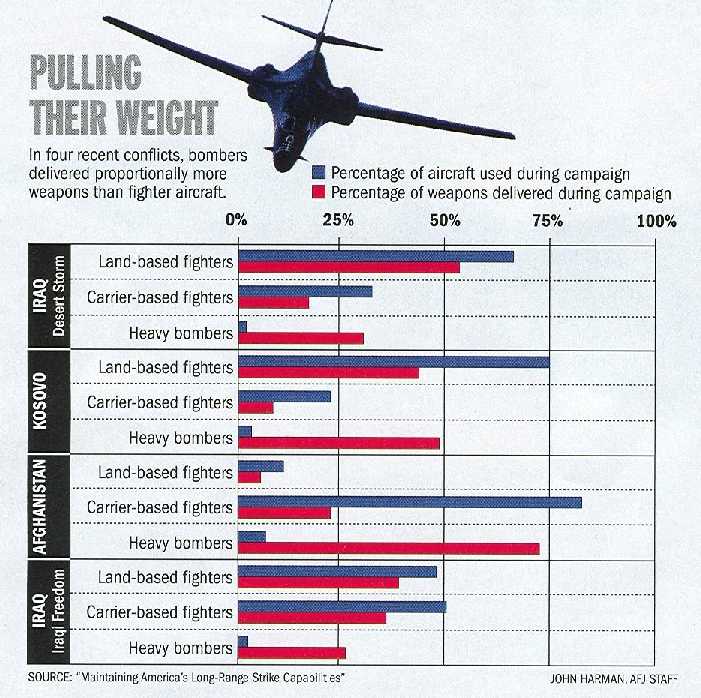
During the Gulf War, B-52s dropped some 30% of all U.S. bombs. Neither the B-1 nor the B-2 was deployed.
One reason for that is the versatility of the bombers: They can carry traditional "dumb" bombs, but thanks to modifications, they also can deliver a range of smart weapons.
Secondly, all this can be done with greater standoff. The bombers fly much higher than fighter craft with no need for a visual, using coordinates from forward air controllers - the eyes on the ground.
Change comes with difficulty for the military; it's a "risk-averse group," Weiners said.
But, he said, "this is a great time to question the old way of doing things."
F/A-22: Deja Me-262 Fighter-Bomber all over again?
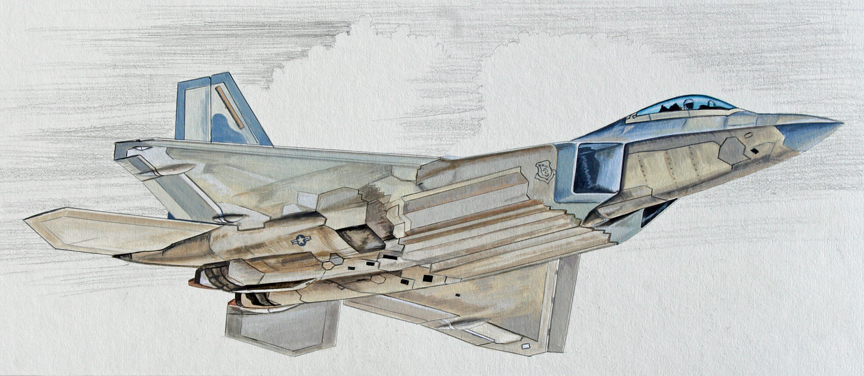
The new tailspin of calling the F-22 Raptor a "F/A-22" to imply an unarmored, compromised-flight-performance-for-low-radar signature (F-15s have faster top seeds than F-22s) medium-high altitude air-to-air combat aircraft can perform Close Air Support (CAS) ground attack is a dangerous lie. The F-22 has an internal weapons bay to not have sharp-sided bombs sticking out which reflect radar signals; these small internal spaces are designed to carry slim air-to-air missiles, not large, fat bombs--in order to shoot down enemy aircraft because its an air-superiority FIGHTER not a ground attack aircraft. Giving the AF the benefit of the doubt, with the space available, how many bombs can a "F/A-22" carry internally?
Two.
That's right, 1, 2.
A recent Defense News article by Vago Muradian, Gail Kaufman and Bruce Rolfsen reports (see below):
"The aircraft's initial striking ability will come from a pair of 1,000-pound Joint Direct Attack Munitions in its weapons bays, then get beefed up over time through fleetwide upgrades, Air Force spokesman William Bodie said".
AF spokesman Willian Bodie elaborates further in the article:
"Given the size of the 1,000-pound weapon, the aircraft can carry only two of the bombs internally. That will change, however, with the arrival of the Small Diameter Bomb in 2006. The F/A-22 will be able to carry eight of the 250-pound, high-yield precision munitions internally, and additional ones on the underwing weapons stations. Upgrades will eventually allow the Raptor to hit moving ground targets in all-weather conditions", Bodie said.
Bodie then boasts that the F/A-22 will somehow render CAS for Army Brigade Combat Teams:
"Air Force planners are teaming with their Army counterparts to support the ground service's new Brigade Combat Teams," he said.
"The Raptor can support mobility forces deep in enemy territory while at the same time penetrating any defenses to come to the aid of Soldiers on the ground, 24 hours a day and in any weather," Bodie said."
Troops on the ground require ordnance that is directed by both human observers on the ground and in the air that is released by aircraft on physical, low-altitude flight paths that are safe in event the bomb tailfins are bent on release, the guidance goes awry and any other myriad problems occur. The hypocrisy of using the enemy ADA threat as a convenient "strawman" to say armored, highly agile A-10s cannot do low-level CAS is made evident when you strap bombs under the wings of "F/A-22s" because this is said to be justified because the ADA threat has subsided so its stealth features---now negated by the externally hung bombs---are not needed. Either the enemy ADA threat has been taken out or it has not; if it has, then what's good for F/A-22s to carry bombs externally is also good for A-10s; except the A-10 can fly low with armor protection and agility to fly beneath overcast weather conditions to render effective
F/A-22s trying to fly CAS missions under 15K if hit by enemy ground fire will be shot down and could crash into steep terrain if boxed in by low cloud ceilings. Knowing this limitation, on "bad weather days" the F/A-22s will not fly and our ground troops will again be without CAS as they were in the dark days of the 1945 Battle of the Bulge in WWII. Dropping bombs blind through clouds by F/A-22s even with allegedy "precision guided" bombs to do CAS is a recipe for killing our own ground troops. JDAMS have already killed American Soldiers in Afghanistan when used in such a fool-hardy manner. In fact, large bombs are not what's needed to do CAS well; guns and rockets aimed by aircraft line-of-sight aircraft under 15,000 feet talked onto target by FACs and terminally guided by their laser designators is what's required.
Cautionary examples of trying to make fighters into quasi-fighter-bombers are the German Me-262 fighter jet which could have as an air superiority fighter swept the prop-driven U.S. Army Air Force from the skies over Europe in WWII. However, instead Hitler insisted it be laden with bombs negating its speed advantage over prop planes. Strapping bombs onto F/A-22s will eliminate any stealth it has to enemy radar detection. Another bad compromised design example is the overweight, under-performing F/A-18 and F/A Super Hornets used by the Navy/marines which cannot even fly Mach 2 but are stuffed with attack avionics. Hornets are unarmored and fly too fast in relation to the ground to provide CAS let alone under operate under low overcast conditions. The ability to be "multi-role" and carry bombs was the design intent of the Joint Strike Fighter (JSF), which would also have STOVL variants that could operate without needing vulnerable, fixed air bases easily ground attacked by asymmetric enemies. Renaming the F-22 a quasi-attack aircraft is likely an opening shot to abandon funding of the JSF and upgrades to actual A-10 CAS aircraft by the USAF in favor of their sexier F-22s operated from comfortable, air-conditioned bases. While our men on the ground that are actually finding, locating and encircling our elusive enemies---and not blowing up decoys, civilians and clumps of rocks from 15,000 feet---who need attack aircraft continuously overhead as far forward as possible operating from dirt strips to render effective CAS---will once more go without.
OA-10C SeaHogs: Saving Naval Aviation with a High-Low Mix
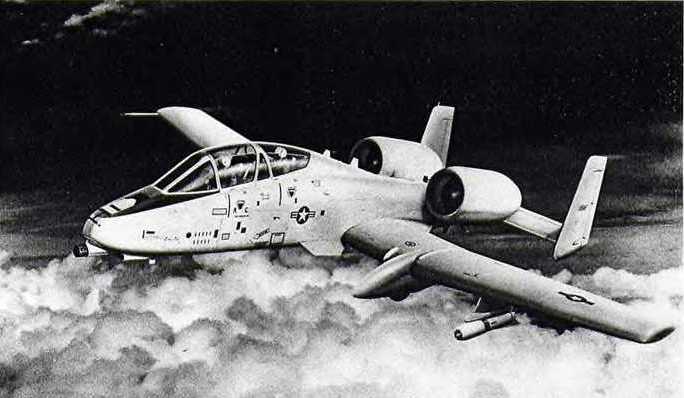
Sadly, America's industrial base is dying as we prefer to build mental gadgets to feed consumerism and not produce PHYSICAL, durable things which takes hard work, character and toil. What this means for America's defense is we will soon not be able to make planes, tanks and ships and will have to try to fight wars with men with rifles in their hands and military versions of mental gadgets driven around in SUVs with a splash of military color. This emasculated U.S. military has already failed and continues to fail daily on the non-linear battlefield of Iraq dominated by high explosives bombs, and RPGs. The enemy is using "smart bombs" against us--they just are not dropped from an expensive aircraft. Great Britain at the time of the 1956 Suez invasion had 14 aircraft carriers, 20 cruisers, 68 destroyers, 186 frigates, 54 submarines, 30 landing ships and 36 major landing craft. The Royal Navy of 1956 is bigger than the U.S. Navy of today. The Royal Navy of today 20 times smaller with the collapse of their overseas empire. America is on the same downward spiral.
In Naval Aviation, the rising "death spiral" of aircraft complexity and costs has driven our aircraft carriers to just one fighting aircraft type: F/A-18 Hornets to try to fly both fast and slow, short and long with F-35 Joint Strike Fighter (JSF) "salvation" at the end of the tunnel to keep 1 out of two U.S. plane makers in business. This represents a "high" cost aircraft that simply will not be affordable in the numbers needed nor able to perform the "low" end missions needed. Something will have to give. And what that will be will be a "Hollow Navy" with multi-billion dollar aircraft carriers sitting in port with no aircraft. It will continue to mean U.S. ground troops getting blown up by enemy roadside bombs because we have no low-speed, low-altitude manned observation/attack aircraft to maintain 24/7/365 cover overhead. It will mean more never-ending "no-win" wars like Iraq draining the U.S. economy by $1 BILLION A WEEK, which means the end of naval aviation when we can no longer afford aircraft carriers, either. Many countries would like to have aircraft carriers but cannot afford them--we might be joining their ranks.
If America wants to keep operating aircraft carriers they will need to offer important capabilities to non-linear battlefields (NLBs) and to simply survive from enemy submarines, and air-refuel to even reach distances to strike air, land or sea targets will need a low-speed aircraft. We propose that we create a "High/Low mix" for U.S. Naval Aviation by taking the 188 x A-10 Warthog attack planes sitting in the Mojave desert at Davis-Monthan AFB and navalize them into 15 squadrons of OA-10B "SeaHogs" with new engines, folding wings, tail-hook and a second back seat. Another option is the 300+ A-7 Corsair II attack planes sitting alongside the Warthogs under the southwestern US sun that are already "navalized". Plug-in rudder pedals, HOTAS flight controls and instrument panels make any designated SeaHog/Corsair II a trainer aircraft. After flight training, the rear seat is reconfigured to act as an attack observer with image intensifier/thermal vision TV that can be transmitted directly to Army and marine grunts on the ground with wrist-watch TV screens like the IDF uses.
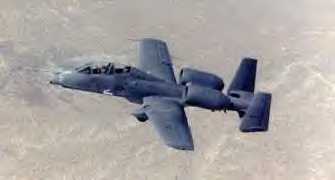
The rear seat observer Airborne Forward Air Controller (AFAC) would be an ANGLICO marine who would do tours on the ground as a Ground Forward Air Controller (GFAC) talking on air strikes by radio, balloon, smoke, air panel and laser marking. With proper coordination with USAF A-10 and ETAC communities this same synergism could be achieved by USAF ETACs doing tours in the back seat of USAF A-10s or A-7s modified into 2-seat configuration. Naval SeaHogs would have the low-speed agility, 30mm gatling cannon, bombs, rocket, missile armaments and armored construction to loiter over battlefields after launch from the sea to provide legendary air tactician Chuck Myers' Maneuver Air Support (MAS) that stops bad guys laying bombs on roads as well as busts enemy nation-state tanks on the roll towards a beach landing. The SeaHogs can deploy ashore onto short take off and landing (STOL) strips as the ground maneuver advances inland for continuous MAS. Without use of our Iowa class battleships for naval gunfire support, we need SeaHogs' close air support strikes just to make sure our marines on foot and flimsy wheeled trucks are not repulsed by swarms of enemy mechanized troops in tracked armored fighting vehicles. We should put two Iowas back in service with rear ski jumps to operate F-35 JSFs to enable us to go into harm's way via their armored construction and beach-clearing fire support to land our Army troops in tracked armored fighting vehicles like the 3rd Infantry Division from sealift ships using Navy LCACs with RO-RO interfaces and heavy lift helicopters. The U.S. Army's 3rd ID (M) was the first to Baghdad because it has the tracked AFV armored and off-road mobility to bypass enemy rear guards that stymie those in rubber-tired trucks.
The SeaHog because of its second seat could house an operator of an Anti-Submarine Warfare (ASW) array, drop sonobuoys and depth charges to attack enemy diesel-electric submarines lurking to sink an American flat top. The SeaHog can sip fuel while offering a hose/drogue to thirsty Hornets and Joint Strike Fighters.
Thus, the SeaHog and/or A-7 Corsair II,"Multi-Purpose Corsairs" could perform the missions now lost when the S-3 Viking ASW/tanker, A-6 Intruder, A-4 SkyHawks were retired--reinstituting a low part of a high/low mix to give Naval Aviation frankly an ability to continue to exist. Without bending to the needs of the low speed/altitude arena Naval Aviation is going to simply break by out of control costs, a dying physical industrial base and the coffin clincher: irrelevance when wars are fought by people who live ashore. This ain't "Waterworld". And it certainly ain't "Demolition Man" where mental gadgets have made physical capabilities mouse clicked away. We need to inject some muscle back into Naval Aviation ASAP by a high/low mix that provides enough aircraft to make aircraft carriers viable and relevant to 4th generation wars.
The First Air Battle Decides the War?
On the Road to Abilene...
Its apparent in the U.S. military that at the rank of Major, the staff officer loses contact with reality and buys into the corporate mythology (lies) if he wants to advance. The key cut-off point in the U.S. Army is Command & General Staff College (CGSC) at Fort Leavenworth (the school, not the prison--though many students could use incarceration). One of the colorful sayings students there have created is "we are on the road to Abilene" when they are clearly on a ride of corporate fantasy. A long journey on a hot, dusty trail that in the end leaves you in a dirty, beaten down town (no pot of gold at end of rainbow).
The U.S. DoD/military is clearly dead set on taking several fatal rides to "Abilene" where it may be "Boot Hill" as their final destination. One of these is the implosion of manned fighter aircraft by death spiral. Future war pundits will say, "Good! about time the fighter jock egomaniacs got what's coming to them" and that "we are now fighting sub-national wars where who needs fighter jets?". The problem is that if you are a nation-state and you control the skies, you can put even the best ground nation-state Army out of business and force it into hiding like we did to the VC/NVA for a decade. We will not have a decade and we may not have 10 months...we may not even have 10 DAYS to decide an issue, we may have just 10 HOURS. He who wins the first air battle may win the war. The reason is that we do not know whose Air Force is going to dominate; whose is full of Brewster Buffalos and who's got the Jap Zeros...who figured out the future pattern of war best?
The Journey Stops at Boot Hill...
Its our belief that Beyond Visual Range (BVR) air-to-air missiles are now at the point of near hit certainty after lock-on, there's nothing for the pilot to do but evade, drop countermeasures then eject before being incinerated. Using the western analogy, the side that "draws" first, wins. The U.S. Air and Naval Forces are in deep trouble because the number of "bullets" in their "6-shooters" is dwindling due to military stupidity and corporate greed resulting in us having less and less shooting aircraft.
USAF
224 x F-15s 1, 000+ F-16s 335 x A-10s
USN/Mc
No F-14s, No A-6s, No A-7s, No A-4s 1, 000+ x F-18s 200 x AV-8Bs
Nation-State War "Doomsday" Scenario
If regional power, the Red Chinese (CHICOMs) invade Taiwan, they can put up into the sky 1, 000 day fighters with AAMs. The USAF will be thousands of miles away and out of the fight even with air refueling. This means initially 2 aircraft carrier battle groups of the Navy/Mc with 124 x F-18s each with 4 x AMRAAM BVR missiles and 4 visual range (VR) Sidewinder missiles. If the F-18s close with the "alien" CHICOM force they will be able to at best kill only 50% of them before having to make a hard choice--continue ahead and get into short-range dogfights where the enemy SU-30 fighter clearly has the advantage to get lock-on by its superior maneuverability and helmet aimed sighting and POSSIBLY finishing off the CHICOMs or POSSIBLY getting themselves all shot down and leaving their carriers undefended and certain to be sunk. If the CHICOMs have a reserve of fighters they hold back and wait for the U.S. F-18s to show their intention ("hand" in poker) they could finish off the F-18s as they turn back low on fuel/armament and/or follow them back to their carriers to sink them. If we lose this air battle, we will not likely insert any ground forces to defend the island and Taiwan will be lost.
Notice, we didn't even talk about what the CHICOM diesel-electric submarines, surface ships, sea mines etc. are going to do to harm our carrier battle groups, too.
The F-35 Radar Stealth Salvation: is it there or not?
The bottom line is will the F-35 JSF be radar invisible so it cannot be taken out in a volley of BVR missiles?
Yes or no?
If no, then we certainly do not need its reduced numbers due to its excessive costs reducing the number of "shots" we have to get our first licks in.
Will the F-35A/C JSF out-maneuver a SU-30, yes or no?
Would a F-35B STOVL with thrust vectoring be able to out dogfight a SU-30?
Obviously, we do not know the answers to these questions but if they are indeed no and no then we should cancel the F-35 pronto and get a radar stealthy superior dogfighter forgetting all the V/TOL stuff (we don't have the time) on a P-51 style crash course basis (Mark Ash's "clean slate" proposals).
Avoiding an Air Debacle

Could the SeaHog be a latter-day version of the F-6D-1 "Missileer"?
If we had a leading edge of fighters that are truly radar un-targetable "F-Invisibles" by the other side, we could indeed get the first volley in. However, we will not have enough of these F-Invisibles even if frugal Burt Rutan created and produced them at $30M each. We need more BVR missiles than can be carried internally to preserve stealth...we need an "Archer" force to rain BVR missiles that is called in after the enemy's leaders are taken out by the F-Invisibles. The "Attack-Archers" or A-Archers would carry under their wings a massive amount of BVR AMRAAMs to cover the F-Invisibles as they withdraw. We propose that we create a 2-seat navalized OA-10B WartHog (SeaHog) whose 60 foot (but now foldable) wings would carry 12 x AMRAAM BVR missiles with the rear seat crewman directing them using a simple search radar. Sort of like the proposed "Missileer" concept to get lots of AIM-10 Eagle (antecessors to the Phoenix) BVR AAMs into the air from the 1960s before the F-14 Tomcat was created. We take every A-10 we own out of the boneyard and make them into SeaHogs to be the "low" end of the current everything mediocre F-18 non-mix and a future F-35 JSF or F-Invisible "high" end mix. .
While we slink our way to Abilene, each year NAVAIR loses a squadron of 12 x F-18s to combat and accidents at $56M each. If we don't keep building F-18s at a low rate in 5 years an entire aircraft carrier would have no planes to fly. In an all-out war with Red China, we could lose half a carrier's F-18s every 24 hours. If we commit two carriers, after 3 days they would have to withdraw because they'd have not enough airplanes to defend themselves--if they are not sunk before that. If we surge 6 carrier battle groups, we could lose 25% of the entire F-18 force if we win the war and 50% of it if we lose the war. We'd have 6 aircraft carriers with no aircraft at best and 6 aircraft carriers sunk and 30, 000 men dead at worst. This is why we must have a "low" end, affordable, IN PRODUCTION (100 aircraft a year) non-stealthy, SLOW attack plane to do the ASW, ASUW, MAS/CAS and A-Archer missions that the mediocre "high" end F-18 cannot do or is too expensive to keep flying in adequate numbers to do everything required.
Defense writer Joe Katzman observes:
"An Aside: While my research over the last couple years has flipped me into being a supporter of the F-22, I have also changed my views re: the F-35 JSF, and become a harsh skeptic but a despairing one. Despairing, because the Navy has few alternatives and a 9-nation program is orders of magnitude more difficult to cancel due to diplomatic and industrial fallout.Meanwhile, I tend to agree with Super Hornet characterizations as 'The Brewster Buffalo of its era' if put up against the increasingly common SU-30 family over the next couple of decades. Worse, I'm not sure that the F-35 does a whole lot better in that matchup.
I've seen some thought-provoking ideas here, but nothing yet that really seems like a viable way out of the conundra. I'm going to try to state them, in hopes of provoking a fruitful discussion:
[1] The F-18 E/F Super Hornet can't compete with the SU-30 family in the air, and the reasons are too fundamental to its design to be changed. It's also a non-starter as a primary opponent to air defense systems using SA-15s, S-300s, and other advanced SAM/radar combinations, unless the U.S. puts the responsibility more or less entirely on air-launched, medium range missiles like SLAM-ER or JASSM and invests in new models for anti-radar work. Adding EA-18Gs to the mix evens the odds somewhat in both scenarios. Enough? I don't know. Suspect not.
This means the F-35 can't be a "low end" complement to the F-22A, but is being pushed toward a "high end" platform by BOTH the US Navy AND allies who will buy the F-35 as their only aircraft. F-22A/ F-35 JSF are therefore evolving into a "high/high" combination, not a "high/low" one.
To go with a "low" option, an answer to the "high" problem of the SU-30s must be found OR the goal of competitiveness in this area for naval aviation must be abandoned, and another solution must be found for high-end SAM systems.
[1a] I'm not sure the F-35 will be a whole lot better against SU-30 family planes than the F-18, for a variety of reasons (rear visibility questionable, stealth questionable with recent downgrades, range questionable, maneuverability and ability to change state quickly unknown to me but unlikely to be canard equivalent, no thrust vectoring).
[1b] I've come to the conclusion that the F-35 won't really work as an F-22 replacement on the high end. Stealth is sub-par, range is sub-par for Pacific theater needs, lack of supercruise means much less time over target at range and shorter AAM reach, inlet design means adding supercruise later not an option without a whole stealth redesign, no thrust vectoring, cockpit visibility not outstanding, no gun in F-35B and F-35C models, etc.
[2] The USA has 6 Tarawa Class LHAs, 8 Wasp Class LHDs, and more LHA-Rs coming. Each is effectively a $1.5 billion investment given replacement costs. Planes or plane equivalents that can operate from these ships are a non-negotiable requirement, and producing more Harriers isn't really in the cards.
(The modified "Singaporean A-4SU Super Skyhawk" solution with the F404 engine was primarily interesting on these grounds as a low-end but compatible solution - but you'd have to either cut all long-range air-air missile capability or make a lot of airframe changes, and the wiring/electronics would need to be designed from scratch, etc... by the time you're all done I wonder if you're looking at another several-year development cycle and $40 million sub-par airplane. As for converting existing airframes, there are major safety and fatigue modeling issues that would make it a problem verging on non-starter. Take a close look at efforts by countries like Canada to implement these kinds of "conversion/bargains" in various areas. This whole model has a very unencouraging history.)
[3] Pulling out of a multinational program with 9 partners would be incredibly painful, and so won't be done except under the greatest duress. Corollary conclusion: it probably takes a huge operational failure that's so glaring it can't be covered up (and consider that all foreign allies in the program will have even MORE vested interest in spinning any bad results).
[4] The U.S. Air Force continues to shrink, as it has since about the 1950s for reasons ably detailed by Spinney. That shrinkage may now be reaching the dangerous/critical level among fighters.
[4a] For 80+% of the USA's military needs in combat theaters, even an F-16 is overkill. For the other 20%, it's unlikely that even an F-35 will do throughout the next 20 years. How to solve #4, deal with this reality, and yet address the issues in #1 and #2 for the Navy is not obvious to me at this point. Without an answer, the barrier in #3 goes from extremely difficult to insuperable.
* My personal sense is that an O/A-10 E/F "SeaHog" (or resurrected and navalized A-9, which the SU-25 Frogfoot strongly resembles) is part of the solution.
* Compound attack helicopters might have a role to play answering issue #2, but we're now at a point where development schedule & timelines could be a problem.
* Do not yet see good answers to #1 and #4. One potential answer I'm beginning to see given is that fighters are now overrated in many day-day roles due to range and loiter issues, and perhaps the answer is more bombers and fewer fighters outside of true air superiority and close air support roles. Not sure what I think of this - it has some rationale to it, but would really accelerate the numbers collapse unless we came up with something quite clever. If this answer is rejected, the question comes back to "What would a true high/low force model involving the F-22 at the high end and adequate overall numbers look like? And what does the Navy do?"
[As far as Iran goes], if the U.S. faces Sparrow clones, it wins. The AIM-7 Sparrow was not a good missile. Don't have data on whether the Iranians own R-77 "AMRAAMskis," or indeed whether their MiG-29 fleet's radars are fully compatible (earlier versions are not, apparently). Short-range, you'd be facing a bunch of Chinese AIM-9L equivalents, plus some AA-11/R-73s which are excellent missiles. (Testing them on East German MiG-29s is what pulled the Germans out of ASRAAM, because they saw the AA-11's design as better in some very fundamental ways. They went on to develop the multinational IRIS-T).
Iran has also adapted some F-14s to carry modified Hawk SAMs (effectiveness uncertain) - and there's data that suggests it has kept some of its Phoenix missiles operational. Official U.S. sources were writing the F-14s and Phoenix off in the Iran-Iraq war, but credible research suggests that this was not true and the F-14/Phoenix combination was very effective.
See this DID article.
www.defenseindustrydaily.com/2006/03/chesire-tomcats-the-f14-fades-into-us-naval-history/index.php
Flip side note... if Cooper & Bishop's research on Iranian F-14 performance is correct, the implications for the F-22A Raptor debate are very large indeed. The Iranian case clearly showed a lot of military utility in small numbers of air dominance fighters that could kill before you knew they were there. Stealth + Supercruise + very advanced passive EM detectors gets the F-22 that ability, and the more I thought about this research the more it shook my views re: the F-22. So Iran's F-14 experience is actually worth close and careful study for many reasons.
Final thing to remember about Iran is that it has TWO air forces. The regular air force, and the Revolutionary Guard air force. They have separate equipment, support, and command structures. Suffice to say that coordination is going to be poor and subversion opportunities large, as the Iranians have even more reasons that the usual 3rd world air force template to distrust its regular pilots."
STEPS TO SUCCESS:
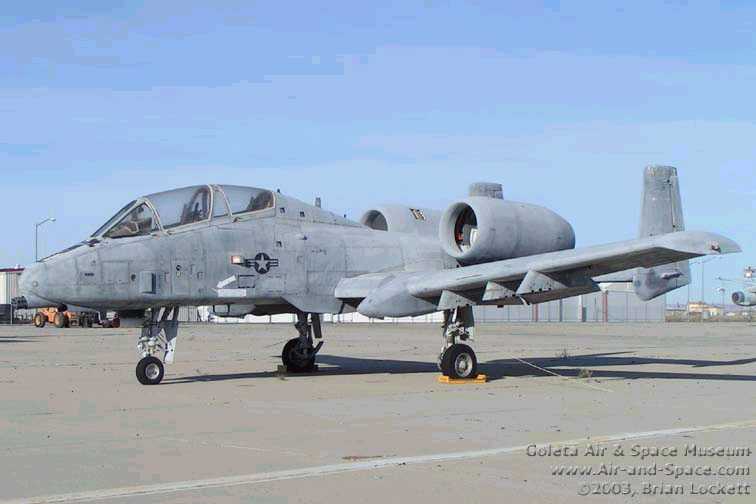
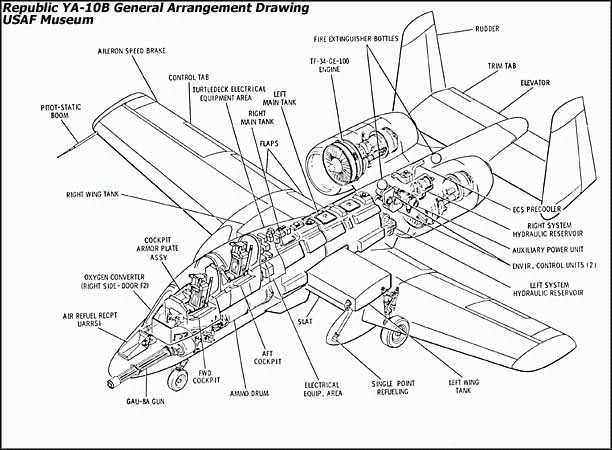
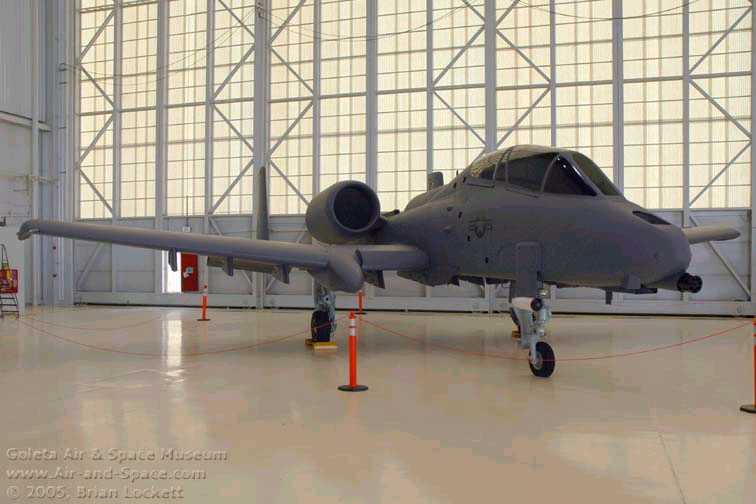
1. Begin with the MAS-WG OA-10B Proposal for the USAF
What we really need is to take some of those 188 x A-10s sitting in mothballs at Davis-Monthan AFB, upgrade with bigger engines, a second seat for an observer and fly several squadrons off the decks of our carriers. OA-10B Air Commandos:
www.combatreform.com/aircommandos.htm
2. Carlton Meyer's A-10 "Sea Hogs"
Carlton Meyer's article: www.g2mil.com/Carriers.htm
There has been some discussion as to whether aircraft carriers are obsolete or far too costly. Cruise missiles fired from bombers, destroyers, cruisers or submarines can strike targets at a far lower total cost. Political leaders now ask if the USA afford 12 "supercarriers", in addition to 13 LHD/LHA "helicopter carriers" which also operate Harrier fighter-attack aircraft, are larger than American World War II carriers, or any foreign aircraft carriers today.
Does the USA need 25 aircraft carriers?
The biggest problem is that new carrier aircraft cost twice as much as those they replace, even after adjusting for inflation. The Navy maintains 10 Carrier Air Wings (CAWs), two fewer since one carrier is always undergoing an extensive multi-year overhaul, and another was deleted a few years ago due to a lack of aircraft. A shortage of aircraft has resulted in the number of fighter-attack aircraft deployed with each CAW to fall from 50 during the 1990s to around 36, typically with 26 x F/A-18Cs and 10 x F-14s. Even with planned budget increases, the Navy cannot afford to fill each carrier deck with its goal of 48 fighter-attack aircraft, giving rise to speculation that two carriers will be trimmed from the fleet. However, the Navy can retain all its carriers if it takes three steps to save billions of dollars while improving the value of CAWs.
#1 Assign a marine corps squadron to each CAW
While the cost effectiveness of carrier strike missions is debated, their value to attack moving targets and provide close air support is unquestioned. Marine corps pilots are specifically trained at close air support and can provide the staff of CAWs with valuable insight and skills. The marine corps has 21 active-duty fighter-attack squadrons, eight F/A-18C and six F/A-18D (two seat) squadrons with 10 aircraft each; and seven AV-8B squadrons with 16 aircraft each. The AV-8B "Harrier" aircraft deploy and support forward deployed marine units from the smaller LHD/LHA carriers.
However, the F/A-18 squadrons have no real peacetime role. They continue Cold War deployments to Iwakuni, Japan, where one squadron is permanently based and two others are maintained through six-month rotations. There is no need for marine squadrons to continue these costly deployments to a region which has overwhelming U.S. and allied airpower. Several years ago, the Navy lacked aircraft to fill out its CAWs, so the marine corps agreed to assign four F/A-18 squadrons. This has worked well over the past decade and should be expanded to cover the growing shortage of Navy carrier jets.
The marine corps should assign 10 F/A-18 squadrons to the 10 CAWs, to allow the Navy to return a CAW to service and reduce op-tempo. This would still leave three marine squadrons for other missions, which could be permanently based at Iwakuni if Generals insist. If a major war occurred, the marines have seven AV-8B squadrons, three F/A-18A squadrons in the reserves, and Navy reserve squadrons could relieve some carrier-based marine squadrons to transition ashore. It makes no sense to deploy multi-billion dollar carriers overseas without a full complement of aircraft while carrier-trained marine corps squadrons sit back home or in peaceful Japan. If this upsets some marine generals, then perhaps these aircraft and their manpower funding should be shifted to the Navy. However, if marines are serious about being "First-to-Fight", they should eagerly accept the idea of using Navy aircraft carriers to forward-deploy.
#2 Cancel the F-35C Navy JSF-Carrier version
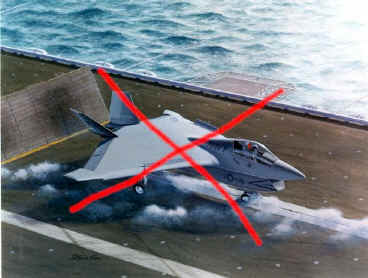
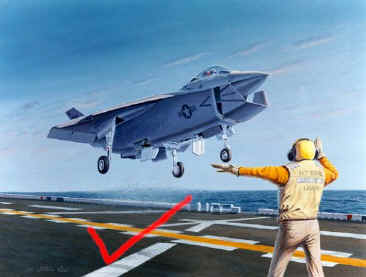
There is no need for a Navy "catapult" carrier version of the Joint Strike Fighter (JSF), which requires a larger wing, strengthened fuselage, catapult attachment points, improved landing gear, and other modifications. This will cost an additional billion dollars to finish development and testing. Since the Navy plans to buy just 300 JSF aircraft, it should simply buy the (Short Take-Off and Vertical Landing) STOVL version, of which 642 are planned for the Marine Corps and 60 for the Royal Navy, with possible sales to Italy, Spain, and even the U.S. Air Force.
Including one STOVL JSF squadron in each CAW would add new capabilities. Carrier operations during adverse weather are very difficult, and almost impossible with ice. STOVL JSF aircraft can operate safely in any conditions. Although the prospect that Navy ships may suffer combat damage seems remote today, STOVL JSF aircraft could operate from a damaged carrier deck. During the 1991 Persian Gulf war, 20 x marine STOVL Harriers operating from the USS Nassau proved that an aircraft carrier can launch a STOVL squadron four times faster than one requiring catapults, which is very important when reacting to threats near shore.
Navy STOVL JSF could also operate from smaller LHD/LHA carriers if necessary, which may become vital if the number of super-carriers decline. STOVL JSF aircraft could be attached to almost any Navy ship for a variety of missions. Finally, STOVL aircraft can make emergency landings on any ship or flat surface, an important advantage during chaotic combat operations STOVL JSF aircraft can provide aircraft carriers with unique capabilities to complement those of the F/A-18s. Ironically, a truly "joint" STOVL variant of the JSF would save almost a billion dollars in development and simplify training and maintenance for the Navy/Marine team.
Most carrier pilots will oppose a STOVL JSF because they are too easy to operate from carriers, which is hard to understand, but true. The Navy carrier-version is planned to carry 4,000lbs more payload, but this does not outweigh the advantages of the STOVL version. Imagine a pair of STOVL fighters detached to a cruiser to greatly expand the fleet air defense perimeter. Imagine STOVL fighters landing on destroyers to refuel, or sitting on their decks on alert rather than clogging a carrier's busy flight deck. Navy STOVL is so logical that even retired Admiral Bill Owens of SAIC has advocated the idea.
#3 Acquire 149 surplus A-10s for the marines
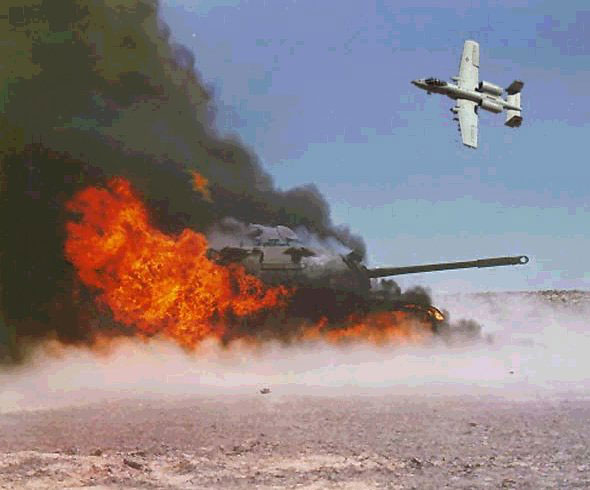
For many years, the marine corps has debated the need for a dedicated attack aircraft like the Air Force A-10. The A-10 "Thunderbolt II" aircraft was specifically developed as a close air support aircraft with reliability and maintainability as major design considerations. The Air Force Requirement documents emphasized payload, low altitude flying capability, range and loiter capability, low speed maneuverability and weapons delivery accuracy. About 30% of A-10s are modified as OA-10s forward air controllers, which use the A-10s longer loiter capabilities to orchestrate air strikes.
The A-10/OA-10 have excellent maneuverability at low air speeds and altitude, and are highly accurate weapons-delivery platforms. They can loiter near battle areas for extended periods of time and operate under 1000-foot ceilings with 1.5-mile visibility. Thunderbolt IIs have Night Vision Imaging Systems (NVIS), compatible single-seat cockpits forward of their wings and a large bubble canopy which provides pilots all-around vision. The Thunderbolt II's 30mm GAU-8/A Gatling gun can fire 3,900 rounds a minute and can defeat an array of ground targets to include tanks. Other equipment includes an inertial navigation system, electronic countermeasures, target penetration aids, self-protection systems, and AGM-65 Maverick [ASM] and AIM-9 Sidewinder [AAM] missiles.
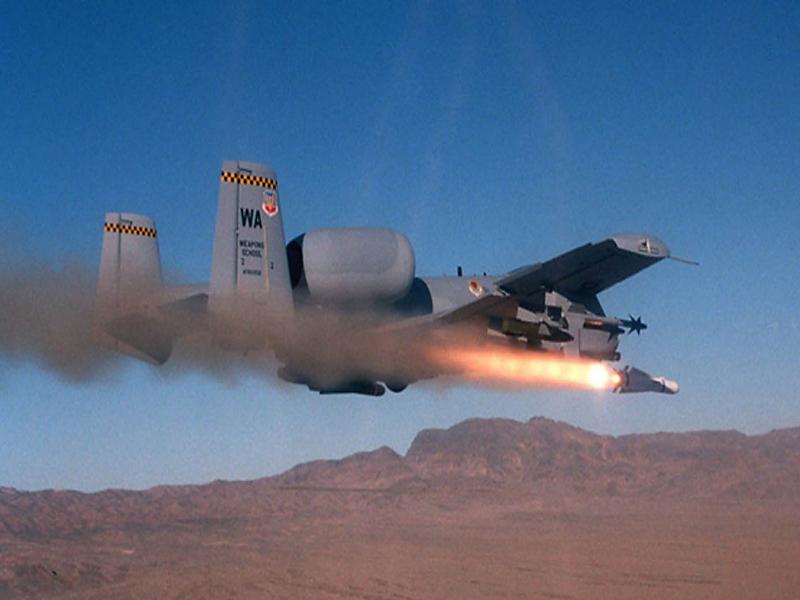
Specific survivability features include titanium armor plated cockpit, redundant flight control system, separated fuel tanks, two rear mounted engines, manual reversion mode for flight controls, foam filled fuel tanks, ballistic foam void fillers, and a redundant primary structure providing a get home capability after being hit during dangerous close air support missions. The aircraft can survive direct hits from armor-piercing and high-explosive projectiles up to 23mm. Their redundant hydraulic flight-control systems are backed up by manual systems to permit pilots to fly and land when hydraulic power is lost.
The Air Force currently has 368 x A-10s and OA-10s in active and reserve squadrons, and 149 in storage. The marine corps should modernize these surplus A-10s to replace their aging F/A-18s starting in 2006. The surplus A-10s in storage can begin overhauls in 2004, perhaps earlier if the Navy needs some marine F/A-18Cs to fill its squadrons until more F/A-18Es arrive. This will provide 8 x A-10 and 4 x OA-10 Thunderbolts for each of 10 marine attack squadrons (120 aircraft plus 39 for pilot training and spares).
Modifications for a marine corps A-10 "Sea Hog" should only require folding wings, a tail hook, and a catapult attachment point. The Air Force is currently upgrading its fleet of A-10s with better electronics and targeting equipment, so there would be no development costs as the marines simply join in the Air Force program. The A-10 uses the same TF34-GE turbofan non-afterburning engine as the Navy S-3 Viking carrier aircraft [were] now used primarily as refuelers This Navy supported engine produces less noise and heat, which is advantageous for an attack aircraft. The A-10s straight wings allow slower flight, making them ideal for carrier operations. The heavily armored A-10 was built to operate from primitive airfields, so it already has strengthened landing gear.
These "Sea Hogs" should cost only around $20 million dollars to overhaul and modernize, compared to around $80 million for each new JSF-STOVL. The Corps would still need 300 JSF-STOVL to replace its AV-8B Harriers and the other three active and three reserve F/A-18 squadrons, unless more A-10s are absorbed as the Air Force begins to retire more A-10s in 2018. A squadron of marine corps A-10 "Sea Hogs" can provide each Navy CAW with new Capabilities to engage ground forces with a custom built attack aircraft, while saving almost $2 billion in future procurement costs.
Realistic CAW Options
Each CAWs now deploys short a dozen fighter-attack aircraft, and one CAW was already disbanded. Even with planned budget increases, aircraft carriers will go to sea with fewer aircraft each year. Political leaders must force Admirals to accept realistic options.
| Current CAW | + 10 Marine sq | Current Goal | Realistic Goal |
| 26 F/A-18* | 24 F/A-18C | 24 F/A-18E | 12 F/A-18E |
| 10 F-14A/D | 10 F-14A/D | 12 F/A-18F | 12 F/A-18F |
| 12 F/A-18 | 12 JSF-Carrier | 12 JSF-STOVL | |
| 12 A-10s |
* 4 of 10 CAWs include a marine F/A-18 squadron with 12-aircraft
These three proposals can save the U.S. Navy billions of dollars over the next decades. It would allow the overall production goal for the F/A-18E to be cut in half. However, all the services have an urgent need for a new electronic jammer to replace the aging EA-6B. The obvious solution is a two-seat F/A-18G "Growler", which would offset some cuts to the F/A-18E program. The JSF-carrier version would be cut outright, while the JSF-STOVL remains unchanged as 300 go to the Navy and 300 to the marines, while the marines modernize and upgrade 149 A-10s. The future of carrier aviation and carriers themselves is fuzzy, unless the Navy-marine team combines to save money while improving the value of CAWs.
Carlton Meyer
Here an article from years ago from a Naval aviator warned of the coming implosion of Naval air...his warning were ignored and Naval aviation is dying...too bad the taxpayers are in a "Patriotic Correct" la-la land where one day they will wake up and realize they have no defense from enemy attack because narcissist lifers turned the military into ego clubs for boys.
www.usni.org/proceedings/Articles00/prorowe.htm
Saving Naval Aviation
By Lieutenant Commander Steve Rowe, U.S. Naval Reserve
Proceedings, September 2000
The Navy has unbalanced the carrier air group's support and force-protection capabilities in favor of decks jammed with strike aircraft, essentially duplicating the Air Force's role. If naval aviation is to survive, it must be able to perform unique missions with forces based entirely at sea.
Ask any naval aviator or naval flight officer (NFO) why the Navy bases its tactical aviation at sea, and he will tell you that Navy air is a vital and unique national capability. He will say that only carrier-based aviation can provide powerful combat power without the need for overseas airfields, basing rights, and overflight permissions, and regardless of the sensibilities of other nations. Navy aircrew will say that every aircraft carrier is little piece of sovereign U.S. territory from which the United States can defend its vital interests--with allies if desired; alone if required. Until very recently, the Navy
pilot or NFO would have been right.
During my 12 years as a naval flight officer, I took great pride in the unique contribution of naval aviation. Navy air was the nation's enabling air arm. This unique capability arguably is no longer credible today, and will almost certainly become a paper tiger in the near future. Why? Because the leaders of naval aviation and the Navy as a whole have forgotten what the Navy is about. In the mad rush for dollars in an under-funded military, the leaders have neglected our core competencies, and grossly unbalanced support and force-protection capabilities to favor strike aircraft. The capabilities Navy air has
retained are the same ones provided by Air Force tactical aircraft, and, to an extent, Army aviation and long-range artillery and missile forces. The capabilities the Navy has chosen to discard are those for which we alone are responsible. The once powerful enabling capability of naval aviation has become little more than a copy of an Air Force fighter wing. Today, like its Air Force counterpart, the carrier air wing (CVW) can no longer operate effectively without shore-based support.
The shift toward a littoral, land-attack focus was an appropriate response to the demise of the Cold War's open-ocean naval threat. In the rush to capture limited defense dollars by cashing in on power-projection funding, however, the Navy has effectively eliminated the battle group's ability to operate in a contested littoral without land-based support. This situation will become worse in the next decade, as current budget plans are followed and littoral area-denial threats continue to grow.
Consider the capabilities that today's carrier air wing struggles to bring into a littoral fight:
Antisubmarine Warfare (ASW). Littoral submarine threats are becoming Stronger, and advanced automated systems are eliminating the Third World submariner's traditional weaknesses--lack of training and the need to expose a periscope to attack. The failure to respond to these trends applies to Navy aviation and to the Navy as a whole. Despite the fact that the problem is more difficult and
the threat is becoming more dangerous, layered battle-group ASW capability is gone.
The S-3B Viking was the battle group's only air-ASW search platform, and it is being eliminated. In addition to a solid acoustic capability, the Viking had naval aviation's best non-acoustic sensor suite, and it was the only platform with the dash speed to investigate rapidly a contact more than a few miles away. Today, all acoustic ASW capability has been stripped from the S-3 community, and the aircraft will be decommissioned by 2008. [1]
In addition, the number of ASW-capable aircraft in carrier-based H-60 Seahawk squadrons has been cut in half. The special operations-configured HH-60 may be better suited for plane guard, passenger transfer, and other logistics functions, but it cannot prosecute a fleeting radar contact or flaming datum. Having an ASW-capable helo ready when needed will be a challenge in the face of other mission requirements, maintenance priorities, and flight-deck-spotting
considerations.
Its aging avionics and airframe and vulnerability to littoral threats can justify retiring the S-3. But it is inexcusable that no replacement has been planned or even seriously considered. The common support aircraft (CSA), in theory the S-3's replacement, never has been more than a Power Point slide. [2] Even if a new aircraft were made a priority today, it probably would not be
operational in less than 10-15 years.
To make matters worse, the P-3 Orion maritime patrol (VP) community, which is supposed to assume the Navy's air-ASW mission, has been cut dramatically. The Orion is even more vulnerable than the Viking to littoral air and missile threats, and antisubmarine training and readiness have suffered because the Navy's emphasis has been on other missions. Many VP aircrews will admit freely that they have lost perishable ASW proficiency. Finally, even though the P-3 has long legs, the aircraft is slow and must be based near areas of operation to keep pace with dynamic situations.
Furthermore, the P-3 is an aging airframe that will need replacement in the near future. Despite increasing corrosion and fatigue problems that threaten the airworthiness of the Orion, the Navy simultaneously is postponing a replacement and cutting a service-life-extension program that would push the aircraft's service life to almost 40 years. [3] The Navy is taking the same dead-end approach to the P-3s as it did with the S-3, despite the fact that studies have shown that building a new aircraft is the most cost-effective option.
The result of these programmatic decisions is that naval aviation will have almost no sea-based capability at a time when advanced submarine sensors, and fire-control and weapons technology will become widespread. The automation inherent in new submarine systems means that Third World submariners soon will be able to get off a good shot without extensive training or the need for a close approach. Battle-group capabilities for air-ASW search, mid- and long-range
attack, and possibly the close-in reactive capability needed to exploit the typically fleeting and unexpected submarine contact, are rapidly disappearing. Meanwhile, land-based ASW aircraft will continue to be affected by diplomatic constraints and by survivability, numbers, training, and aircraft condition limitations. If land bases are not available, the situation becomes worse; if they are available, one must wonder why carrier aviation is needed.
Anti-SUrface Warfare (ASUW). These programmatic decisions also will degrade the battle group's ASUW capability. The S-3B also was the battle group's best organic ASUW platform and remains the only CVW asset with an imaging radar. The Viking's endurance and multi-sensor suite made it the platform of choice to locate priority surface targets and coordinate war-at-sea strikes. The same factors that limit the P-3's ability to take up the ASW mission will limit its
ASUW contribution.
The carrier's strike fighters will be increasingly needed to step into surface search, war-at-sea coordination, and birddog missions. Strike fighters can locate and identify surface contacts, but they are not well suited to extended low-altitude ASUW. Appropriately, strike fighter crews focus on air-to-air and air-to-ground power projection. There simply is not enough training time or resources for small fighter crews to become experts at everything, and my at-sea experience consistently showed they are not the best choice for surface search, identification, and surveillance.
Tanking. With the A-6 Intruder long gone, naval aviation lacks a sea-based mission-tanker capability. The only organic Navy tanker aircraft, the S-3B, is well suited for the recovery tanker role, but never had the speed and high-altitude performance for mission tanking. Though sometimes pressed into the mission-tanking role--usually because Air Force tankers are not available--the S-3
must be launched well ahead of the strike group. This exposes the vulnerable aircraft to enemy defenses and potentially alerts the adversary to an impending attack. In addition, strike aircraft must make significant deviations from preferred flight profiles to rendezvous with an S-3 tanker, decreasing the potential reach of the strike package. In practical terms, the Navy is wholly
dependent on land-based Air Force tankers.
Given the recent emphasis on land attack, Navy air wings have made heavy use of mission tanking. These aircraft must come from foreign bases. They require diplomatic clearance and often they need overflight rights. Therefore, they may not be available when they are needed most.
Navy air is betting the farm on the ability of the F/A-18E/F to fill both the mission- and recovery-tanker roles. The program office promises great range, endurance, and resulting fuel off-load improvements over previous versions of the Hornet. There were similar high expectations for the early Hornets, an aircraft that is notoriously fuel critical. Without an organic mission tanker, the air wing cannot fill the enabling role; without reliable recovery tanking, the air wing cannot conduct flight operations safely at all. For Navy air, the stakes are immense.
Overland Surveillance. In the era of Navy power projection ashore, one would think that organic overland surveillance and strike support would benefit from strong programmatic support. The CVW, however, is dependent on shore-based aircraft.
Kosovo clearly showed that our strike forces lack the sensor capability to attack concealed, deceptive ground forces effectively. Precision weapons are great, but they require precision targeting that we just do not have for most mobile targets. Naval aviation has been slow to procure the multi-sensor capabilities needed to support modern, high-tempo strike operations. While the Air Force is developing a family of land-based unmanned aerial vehicles (UAVs) carrying a variety of sensor packages, the Navy UAV programs languish as backwater demonstration efforts that have not been integrated into air-wing operations. A handful of P-3s have been outfitted with advanced electro-optic and other sensors, but they are not sea-based and not survivable. Like other types of land-based support, these platforms may not be with the carriers when needed.
The Navy has retired the ES-3 Shadow, its only dedicated electronic surveillance aircraft. ES-3s made significant contributions to strike operations during both air wing strike training at NAS Fallon and real contingency operations. Beyond support for individual strike missions, day-to-day electronic surveillance is a key part of building knowledge of the enemy's electronic order of battle and pattern of operations. This knowledge, in turn, is the foundation for future strike planning. Today, this capability is resident only in shore-based
aircraft.
Suppression of Enemy Air Defenses (SEAD). In this area, at least, there is a very good tailhook aircraft. The EA-6B Prowler has a long and distinguished history of direct, integrated CVW strike support. Even so, the Prowler is now a national asset, not a Navy one--the community is considered to be "low density, high demand." It is generally accepted that strike aircraft will not fly opposed missions without EA-6B support, so dedicated Prowlers are an absolutely
critical requirement. The nationalization of the Prowler fleet means that the Prowlers may not always be where the Navy needs them, and even if EA-6Bs remain with the air wing, very high-use rates will prematurely wear out the airframes. Though SEAD is not the critical shortfall the Navy faces in many other areas, it is an area that bears watching.
Command and Control. For the last decade, the Navy has advertised its ability to plan and execute enabling air operations from our forward-deployed, on-scene carrier battle groups. The Navy argued that it could support an enabling Joint Force Air Component Commander (JFACC) in the early phases of a crisis or conflict, and exercise command and control of air operations until the preponderance of air power shifted to the Air Force and this function shifted ashore. The Naval Warfare Publication on JFACC (NWP 3-56.1) articulated this capability, and this publication represented the Navy position in joint doctrine.
Because the armed forces use joint doctrine to shape their operations, the Navy's doctrinal position on command and control of enabling air operations is a critical prerequisite for exercising this capability in the real world.
The Air Force has never accepted the Navy vision of a JFACC. Accustomed to operating out of sprawling land bases where limited shipboard space was never a problem, the Air Force argues that even a small JFACC must be a gargantuan organization. The Navy has long argued that JFACCs need not be so large or top-heavy. In the Navy's view, a smaller sea-based JFACC could not only manage moderately sized air operations, it also would be more agile, responsive, and better able to deal with mobile and time critical targets.
The Navy, however, recently accepted the Air Force vision of JFACC, and conceded that it cannot plan or control significant air operations from forward-deployed carrier battle groups. According to the minutes of the Navy's JFACC Coordination Committee and the revised draft of NWP 3-56.1, a carrier can support only a "Maritime Air Tasking Order (ATO)." The maritime ATO is defined as the carrier's own normal flight operations, with perhaps that critical Air Force tanker thrown in to support Navy strike aircraft. According to these documents, a true sea-based JFACC requires a fleet command ship. Because command ships
are not forward deployed with the battle groups, surging one from the United States could take weeks. Clearly, neither the maritime ATO nor a JFACC hosted on a command ship hosted is relevant for the command and control of enabling air operations.
Why Should We Buy Carriers?
The bottom line is that the naval aviation leadership's myopic dedication of strike capabilities has stripped the carrier air wing of critical support in virtually every other mission area. The recent reversal in Navy JFACC policy means that land bases will be required for command and control, even if they are not needed to support actual operational capabilities. The few bright spots are overwhelmed by the many gaps in essential capabilities.
While it true that the carrier may be able to position aircraft somewhat closer to an enemy's coastline, Air Force tanking (on which the Navy is also dependent) can ensure similar combat reach for land-based strike fighters. Even the supposed force-protection benefits of basing air power at sea are increasingly questionable, given the growth of area-denial threats and the Navy's reluctance to devote real resources to ASW, ASUW, overland sensing (to detect mobile missile launchers), or mine countermeasures. If putting the carrier air wing at sea provides no unique advantages, then why spend billions upon billions of dollars for aircraft carriers and specialized, tailhook-equipped aircraft?
The enabling air power that Navy air can provide is essential to the nation's security. I do not advocate disestablishing tactical naval aviation, but this is the path the Navy leadership has begun to follow. Navy air should do things that no one else can do--project air power without land bases.
Restoring naval aviation's enabling capability requires a dramatic and immediate change of focus--the balance in Navy core competencies must be restored. In the near term, the support aircraft capabilities that have been allowed to atrophy or vanish entirely must be restored. S-3B squadrons should be restored to eight fully mission-capable aircraft. At least some of these should be equipped with a synthetic aperture radar and the avionics to share these data with strike assets. In addition, chronically under-funded air ASW sensors should be assigned a higher priority. A carrier-based aircraft needs to be identified to fill the ES-3's electronic surveillance role. Perhaps some of these sensors could be carried by the S-3, E-2, or in UAVs.
Instead of accepting the Air Force definition of acceptable air operations command and control, the Navy should exploit information technology and incorporate distributed collaborative planning and its tradition of decentralization to the JFACC. Whether aircraft and capabilities are based at sea or ashore, we must be able to command air operations forward and without land bases to meet our enabling force commitments.
In the mid to long term, replacement airframes must be developed to replace aging support aircraft. The common support aircraft program must transition from sets of ill-defined view graphs into a real, funded, aircraft program. Naval aviation should exploit emerging UAV and sensor capabilities to field low-observable--and sea-based--land surveillance and targeting capabilities. This aircraft, or set of aircraft and/or UAVs, must correct the shortfalls in ASW, ASUW, overland surveillance, and strike support. This effort should be naval aviation's top priority, because without support, strike aircraft merely duplicate Air Force capabilities at much greater cost.
Such actions will not be cheap--taken together, they may be very expensive. Without them, however, Navy air becomes a redundant--even meaningless--force. The nation will lack the true enabling capability that it will some day need. Navy air is the foundation of Navy sea control and power projection. Therefore, the offsets required to make these changes happen should be found from across the spectrum of Navy programs. Given the long timelines for aircraft development, this work should start immediately. Only by making these changes now can we ensure that naval aviation remains a useful, relevant, and unique part of our nation's defense.
NOTES
1. "Leaner and Meaner: The New Naval Aviation Plan," Navy Times, 6 March 2000, p. 18.
2. Ibid. Rear Admiral J.B. Nathman (N88) officially announced that the CSA would not be developed in a February interview. His statement merely formalized the implicit decision by lack of a decision for the last few years.
3. "Admiral: Cash Woes Preclude the Most Cost-Effective P-3 Patrol Plane." Inside the Navy, 6 March 2000, p. 14. Rear Admiral L.D. Newsome, Air Antisubmarine Warfare Program Executive Officer, recently announced that the Multi-Mission Maritime Aircraft is unaffordable, and that the sustained readiness program has been cut short.
Commander Rowe was an S-3B naval flight officer, and served with the Naval Doctrine Command Staff. He currently works as a defense contractor, developing future naval concepts.
Summary/Conclusion
The return of two-seat observation/attack aircraft, Air Commandos and enhanced AFACs and GFACs to the USAF is an urgent requirement that can be filled quickly at low cost to the tax payers.
editor@G2mil.com
FEEDBACK!
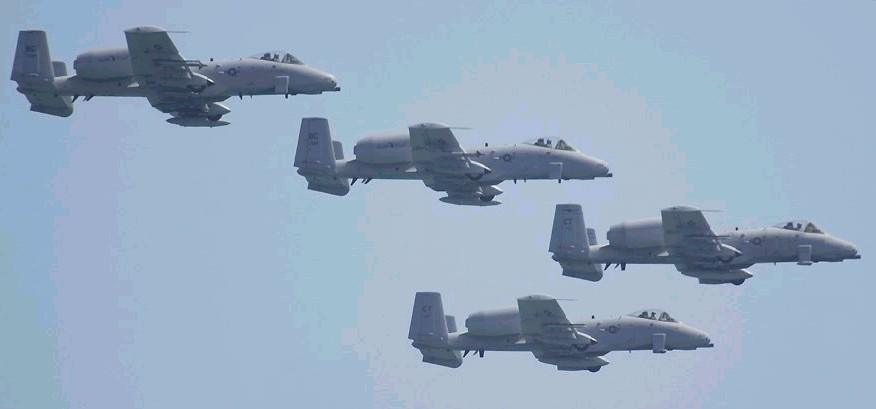
An Army Major from Afghanistan writes:
"ALCON
Excellent article and very accurate.
I served as an LNO in the 10th Mountain TOC during Anaconda and I can attest to the unusually long delays in getting CAS to hit targets spotted by ground forces. Instead of seconds to a minute or so it was more like 10s of minutes to the better part of an hour. Many targets subsequently disappeared within that time frame.
Sincerely"
Major XXXXXXX XXXXXXXXXX
A F-4 fighter-bomber pilot with extensive experience writes:
"I had no idea they ever made 2-seat A10s.
One of the big hassles in the USAF is the total resistance of HHQ to restricted duty pilots - that is, dedicated career pilots. I was at Nellis AFB on a reunion and we got to talk to a one-star on this matter about 6 years ago. It takes about 8 years for a pilot to go from nugget to expert - and can then go anywhere and do anything. The problem is gaining total situational awareness - thus not being surprised but anything that pops up and also be able to act correctly no matter what.
Then the way HHQ does things now - via D/Personnel - the pilot has about 4 years as an expert and he is shunted to a desk somewhere, or passed over because someone wrote him an 8 OER or he didn't get an MA degree. I was sort of unique - I was 40 when I went to DaNang in '71 and had been in the cockpit since 1954. As I mentioned above, nothing ever surprised me while flying at DaNang. My squadron (390th TFS) was short of 'old heads'. We had 4 pilots, including myself, that had enough experience to lead flight up North. All the rest of my pilots were training command, B52 and C141 types right out of F4 RTU and had never, repeat never, flown fighters before. The Army version of this would be to arm cooks and bakers and form an infantry platoon out of them for front-line duty. By luck, the grace of God, and the skill we 4 old heads possessed we never lost a man. Meanwhile, I personnally knew of 6 old heads who were sitting at desks in SEA and we could not pry them loose to help us out. The other two squadrons were in the same shape. It still gripes me that D/Pers will insist on 'career progression' as a reason to keep on shipping good pilots out of the cockpit. Why a brand new second lieutenant who hasn't yet proved he can really fly has to be stuck in a fifty million dollar fighter (F15E) is beyond me. I'd say put him in a second rate ship for two years and see if he survives. If he does, he obviously can fly adequately and we can then entrust him with a first-line machine.
NOTE: I am astounded that fighters made attack runs perpendicular to our own lines. That was absolutely forbidden in 'Nam. The only times I ever made very close attacks was a) in dire need as stated by the ground FAC and b) he gave me his initials. I have dropped hi-drags from 300 AGL within 100 yards of the wire, napalm (100 AGL) and strafe (same) in the wire, but always repeat always parallel to our lines.
I DO NOT understand what is so hard about strafe - one either makes a point attack with the fire concentrated on one spot or gently but quickly move the stick to lay down a pattern. I suspect the F15E troops were not really with the program.
CAS orbiting on-call say a couple klicks behind the front lines should be pretty immune to enemy reaction. As long as the ECM gear works, the crews keep eyes out, a quick drop down between the trees shoud suffice to dodge any incoming missile.
NOTE 2: Have any infantry types been over to talk to the CAS pilots? I know in my career I didn't get much cross-info. One class at Nellis in 1954, B/S swapping with Nike types, some X-training in Berlin FRG in '72 with Redeye crews, and that was it!
Let me know what I can do for you-all - your effort is extremely worthwhile. I found the most rewarding missions in 'Nam were 1) CAS and 2) knocking out SAM sites."
A noted Air Power experts writes in:
"I don't have time for a lengthy response, but some thoughts are pertinent.
1. The A-10 can remain viable in airspace without a radar guided SAM threat and fighter threat, but only if it carries a proper MAWS and IR jammer ie DIRCM/laser suite. Bad guys with plenty of cash might have some very modern MANPADS to shoot and flares will not cut it. Without an IR defensive package you will end up losing aircraft, not an if but a when question.
2. No problems putting in a new engine, plenty of choices, and no problems with an NVG compatible glass cockpit, there is plenty of stuff out there. No problems also with putting a big 14" diagonal AMCLD panel in the middle of the cockpit for heads down FLIR targeting.
3. You will need a FLIR/laser pod, probably the PANTERA/ATP would be the best off-the-shelf choice. That means a Bold Stroke PPC 604/VME processor box to drive it and do the weps delivery and digital datalink work. You would probably be reinforcing the Pave Penny pylon - the ATP has an internal LST facility.
4. JDAMs are more reliable than Paveways - they have GPS plus inertial and that provides defacto dual redundancy - a Paveway loses the laser signal and it goes ballistic. The problem with JDAM is fat fingers by folk on the ground and their peers in the cockpit - punching keypads in a hurry is a recipe for trouble. A digital datalink is what is needed here.
5. The two-seat F-16 CAS trials showed the value of a head steered FLIR slaved the the pilot's helmet, using a HMD with visor FLIR projection. There are HMD helmet packages out there (eg GEC and Pilkington) which combine visor projection with embedded NVG tubes.
6.Another option might be the Virtual HUD (VHUD) which would permit synthetic terrain coutour projection on the visor.
7.Direct low-level attack vs medium altitude drops:
a) if you drop a JDAM or an Paveway as if it was a dumb bomb to achieve best ballistic accuracy you won;t get into trouble with broken guidance. That problems happens mostly when people drop guided bombs at the edge of the guidance envelope.
b) people punching in wrong coordinates or pointing lasers in the wrong place is no different a problem to a poorly aimed arty barrage. Bad targeting is bad targeting regardless of weapon.
c) Going in low to acquire the target exposes the aircraft to all manner of fire but also shorten's the pilot's acquisition time and limits his warning time for reacting to SAM shots or AAA. If he goes in at 500 AGL he has this problem. If he goes in at 2,000 AGL the problem does not get much better. If he is up at FL 150 he has time to acquire and react if fired upon.
8. I don't know where the guy gets his 30 A-10Bs from, AFAIK only two protos were built:
www.wpafb.af.mil/museum/research/attack/a6/a6-19.htm
If you are aiming to use the A-10 then it has to be a `COIN' environment without radar guided threats, and you will need proper DIRCM which are absent in the current aircraft config. Not sure I'd be bothering with the two seater conversion, a decent avionic fit and glass cockpit solves that problem.
In principal I am not opposed to the A-10 but I would insist that it gets proper night/adverse weather avionics, a DIRCM package and be operated only in viable environments. Afghanistan was such since the radar guided threat got killed off on day one. Other theatres might be very different.
The strategic issue is whether you want to support a specialised CAS bird while all of this money is being invested into JSF to do only that job well.
Personally I'd be investing into datalinks and ground targeting gear to support such so that any asset which carries bombs can go plinking CAS targets on call. Solve the problem properly at last."
MORE NOTES
1. Washington POST article Ambush at Takur-Gar
2. "Going in"; Close Air Support in Afghanistan parts 1 and 2; by Lance M. Bacon, Soldier of Fortune magazine, September and October 2002' part 3 in due in November
3. Virtual Aerospace Web
www.aerospaceweb.org/aircraft/attack/a10/index.shtml
KNOWN A-10 VARIANTS:
YA-10 Prototype, competed with Northrop YA-9 for Air Force A-X attack plane contract and won on 18 January 1973
A-10A Production attack plane; 721 built, about 90 upgraded with radar altimeter, GPWS, autopilot, new bomb sight, and capability for 30 mm cannon to be used against air units
A-10T or A-10B Two-seat combat-capable trainer with enlarged nose and taller fins; 30 built
A-10NAW or YA-10B Two-seat Night Adverse Weather prototype developed by Fairchild for consideration by USAF, second seat for weapons officer responsible for ECM, navigation, and target acquisition; not put into production but many features later incorporated into A-10 fleet OA-10A
Small number of A-10As converted to observation and forward air control (FAC) role
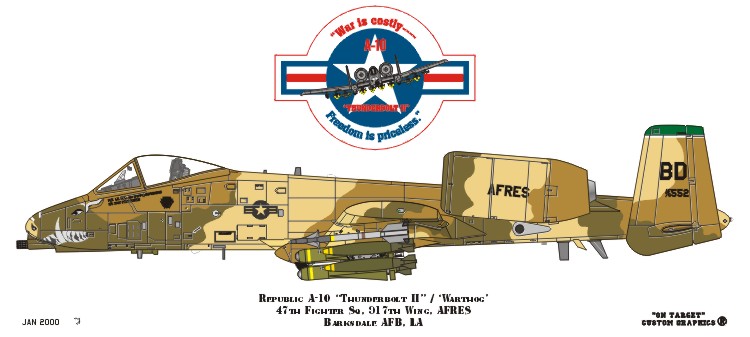
4. USAF A-10 Fact Sheet
www.af.mil/news/factsheets/A_10_OA_10_Thunderbolt_II.html
Mission
The A/OA-10 Thunderbolt II is the first Air Force aircraft specially designed for close air support of ground forces. They are simple, effective and survivable twin-engine jet aircraft that can be used against all ground targets, including tanks and other armored vehicles.
Features
The A-10/OA-10 have excellent maneuverability at low air speeds and altitude, and are highly accurate weapons-delivery platforms. They can loiter near battle areas for extended periods of time and operate under 1,000-foot ceilings (303.3 meters) with 1.5-mile (2.4 kilometers) visibility. Their wide combat radius and short takeoff and landing capability permit operations in and out of locations near front lines. Using night vision goggles, A-10/ OA-10 pilots can conduct their missions during darkness.
Thunderbolt IIs have Night Vision Imaging Systems (NVIS), goggle compatible single-seat cockpits forward of their wings and a large bubble canopy which provides pilots all-around vision. The pilots are protected by titanium armor that also protects parts of the flight-control system. The redundant primary structural sections allow the aircraft to enjoy better survivability during close air support than did previous aircraft.
The aircraft can survive direct hits from armor-piercing and high explosive projectiles up to 23mm. Their self-sealing fuel cells are protected by internal and external foam. Manual systems back up their redundant hydraulic flight-control systems. This permits pilots to fly and land when hydraulic power is lost.
The Thunderbolt II can be serviced and operated from bases with limited facilities near battle areas. Many of the aircraft's parts are interchangeable left and right, including the engines, main landing gear and vertical stabilizers.
Avionics equipment includes communications, inertial navigation systems, fire control and weapons delivery systems, target penetration aids and night vision goggles. Their weapons delivery systems include heads-up displays that indicate airspeed, altitude, dive angle, navigation information and weapons aiming references; a low altitude safety and targeting enhancement system (LASTE) which provides constantly computing impact point freefall ordnance delivery; and Pave Penny laser-tracking pods under the fuselage. The aircraft also have armament control panels, and infrared and electronic countermeasures to handle surface-to-air-missile threats. Installation of the Global Positioning System is currently underway for all aircraft.
The Thunderbolt II's 30mm GAU-8/A Gatling gun can fire 3,900 rounds a minute and can defeat an array of ground targets to include tanks. Some of their other equipment includes an inertial navigation system, electronic countermeasures, target penetration aids, self-protection systems, and AGM-65 Maverick and AIM-9 Sidewindert missiles.
Background
The first production A-10A was delivered to Davis-Monthan Air Force Base, Ariz., in October 1975. It was designed specially for the close air support mission and had the ability to combine large military loads, long loiter and wide combat radius, which proved to be vital assets to the United States and its allies during Operation Desert Storm and Operation Noble Anvil. In the Gulf War, A-10s had a mission capable rate of 95.7 percent, flew 8,100 sorties and launched 90 percent of the AGM-65 Maverick missiles.
General Characteristics
Primary Function: A-10 -- close air support, OA-10 - airborne forward air control
Contractor: Fairchild Republic Co.
Power Plant: Two General Electric TF34-GE-100 turbofans
Thrust: 9,065 pounds each engine
Length: 53 feet, 4 inches (16.16 meters)
Height: 14 feet, 8 inches (4.42 meters)
Wingspan: 57 feet, 6 inches (17.42 meters)
Speed: 420 miles per hour (Mach 0.56)
Ceiling: 45,000 feet (13,636 meters)
Maximum Takeoff Weight: 51,000 pounds (22,950 kilograms)
Range: 800 miles (695 nautical miles)
Armament: One 30 mm GAU-8/A seven-barrel Gatling gun; up to 16,000 pounds (7,200 kilograms) of mixed ordnance on eight under-wing and three under-fuselage pylon stations, including 500 pounds (225 kilograms) of Mk-82 and 2,000 pounds (900 kilograms) of Mk-84 series low/high drag bombs, incendiary cluster bombs, combined effects munitions, mine dispensing munitions, AGM-65 Maverick missiles and laser-guided/electro-optically guided bombs; infrared countermeasure flares; electronic countermeasure chaff; jammer pods; 2.75-inch (6.99 centimeters) rockets; illumination flares and AIM-9 Sidewindert missiles.
Crew: One or two
Date Deployed: March 1976
Unit Cost: $9.8 million (fiscal 98 constant dollars)
Inventory: Active force, A-10, 143 and OA-10, 70; Reserve, A-10, 46 and OA-10, 6; ANG, A-10, 84 and OA-10, 18
Point Of Contact
Air Combat Command, Public Affairs Office; 115 Thompson Street, Suite 211; Langley AFB, VA 23665-1987; DSN 574-5007 or (757) 764-5007. June 2000
5. FM 17-18 Light Armor Operations states:
Tactical Air Control Parties. The USAF provides one TACP to each maneuver battalion. Each TACP includes an ALO, who performs FAC duties, and two TACAIR C2 specialists. One of the specialists is trained in terminal air control techniques and can perform TACP duties. The ALO supervises the activities of the TACP personnel; he advises the commander, FSO, and S3-Air on capabilities and limitations of TACAIR and other technical or tactical aspects of TACAIR missions as required. The ALO uses USAF TACAIR requests to maintain radio contact with all other TACPs in the division and with the air support operations center (ASOC). When possible, he provides final coordination of CAS missions in the battalion area. The TACP transmits to the ASOC all requests for immediate CAS. He advises the S3-Air and FSO of other units' immediate air requests. As changes in the TACAIR situation are transmitted over the TACAIR request net, the ALO relays them to the S3-Air and FSO.
TACP procedures in this manual conform to US Army and USAF standards. TACPs participating in allied operations should be familiar with the characteristics and attack profiles of all aircraft that may support ground operations.
Preplanned Missions. Preplanned missions are those for which a requirement can be foreseen. They permit detailed planning, integration, and coordination with the ground tactical plan. In the defense, CAS can be used to thicken fires in a decisive EA. In the offense, CAS can be planned to strike an anticipated enemy counterattack in the vicinity of an objective. Inherent in such preplanned CAS missions is the possibility that the target will not appear at the place and time that was expected. Such missions would then be released and used to fill requests for immediate CAS elsewhere on the battlefield. Preplanned CAS missions are most desirable because munitions can be tailored to the target and complete mission planning can be accomplished. Categories of planned CAS are--
Scheduled mission. This is a CAS strike on a planned time on target (TOT), and will be included in the daily air tasking order (ATO).
Alert mission. This is a CAS strike on a preplanned target area executed when re quested by a supported unit. It is usually launched from a ground alert but may be flown from an airborne alert status. Alert (on-call) CAS allows the ground commander to designate a general target area within which targets may need to be attacked. The ground commander designates a conditional period within which he will later determine specific times for attacking the targets. Requests for planned CAS missions originating at the light armor battalion level are forwarded to the brigade FSE over the OI net or by any other means available. When the request is received by the FSE, it is reviewed by the G3-Air, the FSO, and the ALO. They determine the suitability of the targets for air attack and consider potential airspace conflicts. The FSO may decide that it would be better to use another weapon system against that target. As a minimum, he will integrate CAS into his FS plan. The G3-Air will then add the request to the file for planned CAS missions, eliminate duplications, and assign target priorities. He then forwards the consolidated request to an assistant G3. Consolidated requests are coordinated with the division FSCOORD and ALO. The requests are then forwarded to the corps G3-Air. Figure 7-6 depicts the planned CAS request net.
Figure 7-6. Planned close air support request channels.
Immediate Missions. Immediate missions are executed in response to requests from supported ground maneuver commanders to fulfill urgent requirements that could not be foreseen. Details of such missions are normally coordinated while the aircraft are in the air. Immediate mission requests are normally processed through USAF channels. Before requesting immediate CAS, the following points should be considered:
Target type. CAS is most effective when attacking exposed and/or moving enemy forces and air defense assets.
Enemy air defenses. Both antiaircraft artillery (AAA) and surface-to-air missiles (SAM) are systems that may require suppression before CAS can be effective.
Target acquisition. Well-camouflaged or small, stationary targets are difficult for pilots to acquire. These kinds of targets will require some kind of marking for identification. The use of an FSE or COLT to laser-designate a target can help target acquisition.
Day or night observation. For night missions, the FSO should give special attention to target identification and the use of artillery to illuminate the target.
Time available. Response and station time for CAS aircraft can vary from a few minutes to more than an hour. The TACP will normally have the most up-to-date information.
Figure 7-7. Immediate close air support request channels.
Requests for immediate CAS missions that originate at maneuver company level are forwarded to the battalion FSE and to the ALO (see Figure 7-7). Based on direction from the S3 and FSO, the ALO can make the request through the TACAIR request net from the TACP directly to the ASOC. The TACP at each level monitors the request and acknowledges receipt. Silence by an intermediate TACP indicates approval of the request by the associated Army echelon. If any echelon above the requesting echelon disapproves the request, the TACP at that echelon notifies the ASOC and the initiating TACP, giving the reason for disapproval. When the request is approved, the ASOC orders the mission flown. Immediate missions involve launching general alert aircraft using air alert sorties and/or diverting aircraft from other missions. Figure 7-8 depicts a typical immediate CAS request flow.
Before CAS aircraft release ordnance on the target, the TACP and FSO must accomplish several tasks. Radio frequencies and laser designation settings used by the FSOs, COLTs, and tactical aircraft should be predetermined and forwarded to all parties. Since most aircraft do not have FM radios, the ALO will use the ultrahigh frequency (UHF) tactical air direction net to communicate with CAS aircraft. Most USAF FM capability is nonsecure; therefore, it is critical that proper authentication procedures be used when FM radios are employed.
Following approval of the CAS request, the TACP and tactical air controller (TAC-A) receive aircraft mission data from the ASOC. These data include mission number, aircraft call sign, number and type of aircraft, ordnance carried, and TOT. The TACP determines any additional essential information, such as updated enemy locations and identification means, availability of fires for suppression of enemy air defense (SEAD), friendly ADA considerations, and time factors for the attack. If CAS aircraft are fitted with LSTs, the laser setting must be passed to the attack aircraft. When aircraft arrive at the target area, the TACP provides the pilots with updated information. They must be given enough information to positively identify the target. The TACP is also prepared to abort the attack if the safety of friendly troops is threatened. During the entire attack, the ALO watches for enemy surface-to-air fires and warns the aircraft accordingly.
If the CAS aircraft are fitted with LSTs, the TACP coordinates with the FSO or COLT to ensure that the targets are accurately marked for the aircraft. The LST-equipped aircraft detects the reflected laser, locks onto it, and illuminates an aiming cue in the pilot's head-up display. Even with laser designators, the use of marking smoke should be considered to help the pilot aim his LST accurately. Caution should be used to avoid laser-to-target visibility and attenuation problems caused by the smoke.
CAS Planning Considerations. CAS mission success is directly related to thorough mission planning based on the factors discussed in the following paragraphs.
Weather. Does the weather favor the use of aircraft? What is the forecast for the immediate future? Weather is one of the most important considerations when visually employing weapons; it can hinder target identification and degrade weapon accuracy.
Target Acquisition. Targets that are well camouflaged, small and stationary, or masked by hills or other natural terrain are difficult to identify from fast-moving aircraft. The use of marking rounds can enhance target identification and help ensure first-pass success. Moving targets will usually highlight themselves.
Target Identification. This is critical if CAS aircraft are to avoid attacking friendly forces by mistake. It can be accomplished by providing a precise description of the target in relation to terrain features easily visible from the air. Smoke, laser target marking, or other means can also be used.
Identification of Friendly Forces. Safe means of friendly position identification include mirror flashes, marker panels, and direction and distance from prominent land features or target marks.
Figure 7-8. Typical immediate CAS request flow.
General Ordnance Characteristics. What types of targets are to be engaged, and what are the desired weapon effects?
Final Attack Heading. Choice of the final attack heading depends upon considerations of troop safety, aircraft survivability, and optimum weapon effects. Missiles and bombs are effective from any angle. Cannons, however, are more effective against the sides and rears of armored vehicles.
Troop Safety. This is a key consideration in using CAS. The primary cause of fratricide is misidentification of friendly troops as enemy forces.
SEAD. SEAD will be required based on the capabilities of the aircraft and presence of enemy air defense systems in the target area.
CAS and Artillery Integration. Army artillery and tactical airpower are complementary. Because artillery support is more continuous and responds faster than CAS, CAS missions must be integrated with artillery so that limited firing restrictions are imposed. The ACA is the FS coordination measure used to accomplish this integration. There are four standard ACAs: lateral, altitude, timed, and altitude and lateral separation.
Other planning factors that must be considered are time available for planning, C3 and terrain. Refer to FM 6-20-50 for these additional planning factors.
Strike Execution. As the CAS aircraft reach the general vicinity of the target, they fly to a contact point that is normally given to the pilots through USAF channels. At the contact point, the pilots change radio frequencies and come up on the supported ground unit's TACP frequency. The pilots are then given a situation update by either a TAC-A or the ALO as they continue flying in the direction of the target. The CAS aircraft then fly to a reference point on the ground that the pilots can identify from the air, called the initial point (IP). When the CAS flight leader is cleared to attack, he switches to the attack frequency, contacts the TACP, and reports when his flight departs the IP and is en route to the target. This radio call is used to coordinate any required SEAD and/or target marking rounds.
It is important to remember that this entire procedure, in a high-intensity, high-threat environment, would have to be done as smoothly and quickly as possible. If the attack aircraft are not aligned with the correct target or if friendly troops may be endangered, the TACP must abort the attack. The CAS abort procedure uses a challenge and reply response. The CAS flight leader gives the TACP the two-letter challenge code; the reply "letter" from the TACP is the abort-call "code word." The reply letter should be transmitted after the words "ABORT, ABORT, ABORT." This procedure is possible only if the TACP or ALO has the same authentication system as the aircraft.
An effective daytime technique of marking target areas is to fire a mortar smoke round into the target area. Pilots can easily verify the target area prior to releasing ordnance. During limited visibility, the same technique can be used only using illumination rounds set for ground burst.
Night Planning and Operation Considerations. In a high-intensity, high-threat environment, the capabilities of CAS aircraft employed at night are very limited. To improve the capabilities of night CAS, the USAF is acquiring additional night-capable systems such as the low-altitude navigation and targeting infrared for night (LANTIRN) system. Despite the limitations, CAS aircraft still have a few advantages while attacking at night. The most important advantage is the limitation darkness imposes on enemy optically-sighted and infrared (IR) antiaircraft systems. This is particularly true if they do not have NVD. Airborne or ground-based illumination can also degrade enemy night-vision capabilities.
The two most important requirements of a night CAS operation are identification of the enemy or target and positive marking of friendly unit locations. The ground maneuver commander should rely on his own Army assets to accomplish the marking and illumination requirement. Although flares released from airborne FACs, other CAS aircraft, or "flare ships" can effectively illuminate target areas, illumination fired by ground artillery and heavy mortars are normally preferred due to the continuous capabilities of sustained indirect fire. Fixed-wing aircraft that can conduct night CAS missions with battlefield illumination are the AV-8B, A-10, A-7 [bye, bye], F-16, F-4 [bye, bye], F-111 [bye, bye], and F/A-18.
Laser designation capabilities of the A-10, A-7, AV-8B, and F/A-18 enable these aircraft to acquire targets without use of conventional illumination. The LSTs carried by these aircraft detect the reflected laser, lock onto it, and provide the data directly to the pilot. The F-4, F-16, F/A-18 and A-7 can also use radar to provide reference information for night operations. In addition, small radar reflectors, optimized for particular airborne radars, can create spotting cues for CAS aircraft.
Marking friendly unit locations improves joint air attack team (JAAT) and CAS safety and also provides target area references. Tracers and radar beacons can serve both purposes. If safe separation is a factor, friendly unit marking is critical. Fired into the air, 40-mm illumination grenades and flares are effective, but they may be useful to the enemy as well. Flares used during limited visibility operations can create the "milk-bowl" effect, making it more difficult for a CAS aircraft to find its target. When used under a low cloud ceiling, flares can also highlight the aircraft against the cloud cover. Strobe lights are very good night markers. They are commonly used with blue or IR filters and can be made directional by the use of any opaque tube. In overcast conditions, strobe lights can be especially useful. Aside from the obvious security considerations, almost any light that can be filtered or covered and uncovered can be used for signaling aircraft.
USAF Aircraft Characteristics. CAS missions never consist of less than two aircraft sorties. These aircraft may make more than one pass over the target area except in high-intensity, high-threat situations, where the capabilities of modern air defense systems present added dangers. The following paragraphs provide examples of two types of aircraft, the A-10 and the A-7, that will normally be given CAS missions. Table 7-5 is a summary of reference data for aircraft that perform CAS missions; Table 7-6 is a summary of ordnance available for CAS.
Table 7-5. Aircraft reference data.
Table 7-5a. Aircraft reference data (Cont).
Table 7-6. Aircraft ordnance reference data.
The A-10 (Thunderbolt) is designed specifically for the CAS role. In a typical CAS mission, the A-10 could fly 150 miles and remain on station for an hour. It can carry up to 16,000 pounds of mixed ordnance with partial fuel, or 12,086 pounds with full internal fuel. The 30-mm GAU-8A gun carried by the A-10 can fire 2,100 or 4,200 rounds per minute and defeat the whole range of ground targets encountered in the CAS role, including tanks. In addition to the GAU-8A, the A-10 can also carry free-fall or guided bombs, gun pods, six AGM-65 Maverick missiles, jammer pods, and the Pave Penny laser spot tracker. A typical standard ordnance load for the A-10 is two to four Maverick missiles and over 1,100 rounds of 30-mm ammunition, consisting of an armor-piercing incendiary (API) and high-explosive incendiary (HEI) mix. The API has a depleted uranium penetrator. The Maverick used by USAF aircraft uses TV or IR seekers with fire-and-forget and day-night capabilities. The warhead is a 165-pound shaped charge for use against tanks or a 300-pound penetrating high explosive. Time required to acquire and lock the weapon onto a target usually restricts the A-10 to one missile per pass. In a target-rich environment, there may be time for further engagements with the 30-mm gun before breaking off the attack. The 30-mm gun is normally aimed at a point target and fired for a one-second burst of 30 rounds. The on-board load of 1,170 30-mm rounds, fired at 2,100 rounds per minute, could be expended in just 30 seconds.
[Editor: A-7s are retired from U.S. service]
The A-7 (Corsair) is a subsonic tactical fighter that was delivered to the USAF and Navy between 1968 and 1976. The A-7 has on-station time of 30 to 50 minutes with a maximum speed of 663 mph. The aircraft's outstanding target kill capability, first demonstrated in Southeast Asia, is achieved with the aid of continuous-solution navigation and weapon-delivery systems, including all-weather radar bomb delivery. Additionally, a large number of A-7s were modified to carry the same Pave Penny laser target designation pod as the A-10. The A-7 can carry up to 15,000 pounds of air-to-air or air-to-ground missiles, bombs, rockets, and gun pods. In addition, it has the standard M-61A1 20-mm Vulcan gun, which is effective against lightly armored vehicles.
The F-16 (Fighting Falcon) is a single-engine, single-seat, lightweight, high-performance, multirole aircraft. This highly maneuverable fighter excels in air-to-air and air-to-surface roles. In the air-to-surface role, using a 20-mm Gatling gun, it is the most accurate aircraft in the inventory and can be used for both CAS and AI.
U.S. NAVY/MARINE CORPS TACTICAL AIR SUPPORT
U.S. Navy (USN) and/or U.S. marine corps (USMC) air requests are forwarded by the respective SALTs to the aviation unit in support of the unit. The brigade FSO submits all air requests, including those for USMC attack helicopters (AH-1W Cobra), through the Marine air officer or ANGLICO. The actual terminal control of the air assets is done by the firepower controller of the FCT. In the absence of an observer, USN and/or USMC air may be controlled by the company FSO, the ALO, or the USAF FAC.
Like USAF support, USN/USMC TACAIR never consists of less than two aircraft sorties. These aircraft may make more than one pass over the target area, but loiter time is contingent on transit distance. Refer to Figure 7-4 and Table 7-1 for additional information. The following are the two most common USN/USMC aircraft that provide CAS to light armor operations.
The F/A-18/D (Hornet) is an extremely versatile aircraft that can provide excellent CAS with its 20-mm rotary cannon and a basic load of either 515 or 580 rounds. Loiter time is 30 to 45 minutes, depending on external fuel tanks and ordnance load. The F/A-18 can carry 13,700 pounds of conventional ordnance consisting of 2.75-mm and 5-mm rockets, Walleye, HELLFIRE, TOW missiles, fuel-air explosive (FAE) and flares. It is equipped with a laser designator, radar, and FLIR/NVG. The maximum speed is 1,190 mph (without ordnance or external fuel tanks).
The AV-8B (Harrier) can also provide CAS with its 25-mm rotary cannon, however, its basic load is only 300 rounds and can only remain on station for up to 30 minutes. The AV-8B can carry 8,000 pounds of the same type of external ordnance as the F/A-18. For target acquisition, it has LST and FLIR/NVG. The maximum speed is 685 mph (without ordnance or external fuel tanks). Section III. Army Aviation Support
Army aviation assets will deploy with light infantry contingency TFs. Light armor units may operate with attack and/or reconnaissance aviation assets to perform reconnaissance and security operations.
ORGANIZATION
The organization of the light division aviation brigade and reconnaissance squadron is dependent upon whether the division is light, airborne, or air assault. The ACT in each type of division, however, has the same organization.
CHARACTERISTICS
The capabilities of the AH-1, AH-64, and OH-58D attack helicopters include--
The AH-1 Cobra can carry multiple loads, dependent on the mission, enemy situation, and atmospheric conditions. Weapon systems include 2.75-inch rockets, 7.62-mm minigun, 40-mm grenade launcher, 20-mm cannon, and TOW.
The AH-64 Apache is equipped with the pilot night vision sensor to enhance flight during periods of reduced visibility. It also has a target acquisition sight/designator to lase targets for laser energy-seeking munitions. Its weapon systems include 2.75-inch rockets, 30-mm cannon, and the HELLFIRE missile.
The OH-58D (Kiowa Warrior) is the armed version of the OH-58 (AHIP) with HELL FIRE, Stinger, 2.75" rockets, and .50 caliber [heavy] machine guns. The helicopter is equipped with a thermal imaging system (TIS) and a low-light camera system. The helicopter is capable of operating on a digital TACFIRE network. The Kiowa Warrior will eventually replace all Cobras and Kiowas in the cavalry squadrons and attack battalions of the light and airborne divisions. EMPLOYMENT
The aviation brigade provides divisional Army aviation support. This support can be for attack, air movement, air assault, reconnaissance, intelligence, security, and/or logistical operations. Cargo helicopters (CH-47s) are available only in the aviation brigade of the air assault division or at corps level.
Light armor leaders at all levels must be aware of the integration of Army aviation assets into the maneuver plan so that light armor and rotary aircraft can work efficiently as a team.
Light armor units will normally work with Army aviation assets in reconnaissance, security, or logistical roles.
An ACT may operate with a light armor battalion during a reconnaissance or screen mission. Planning and guidance for future operations are conducted by the light armor battalion. The light armor unit commander assigns missions to the ACT commander. The light armor battalion staff provides essential intelligence, logistical, and FS information. The ACT commander can respond quickly to support a ground commander's scheme of maneuver. The minimum information he must know is--
Enemy situation.
Availability of FS.
FS coordination measures in effect.
Current battlefield graphics.
Attack helicopter assets in the area.
Disposition of friendly ground elements.
Commander's relationship to the new unit.
Person to whom spot reports are to be reported.
Location of supporting Classes III and V aviation assets.
An ACT may also work with light armor companies or platoons as a reconnaissance team. For example, during the early stages of a CONOPS, air reconnaissance aircraft can provide early warning for the mobile light armor ground force tasked to provide security for the airhead. Available light armor and ACT assets can be task organized by the commander to provide a highly mobile screening force in a predominantly dismounted brigade AO.
Attack Helicopter Mission. The primary mission of attack helicopters is to destroy massed enemy forces with aerial firepower, mobility, and shock effect. Light armor with attack helicopter augmentation significantly gain, maintain, and exploit the initiative to defeat the enemy. They operate in offensive, defensive, or special purpose operations. The attack helicopter can be committed early in battle. It can reinforce ground combat units and can attack, delay, or defend by engaging the enemy with direct and indirect fires. Attack helicopter battalions cannot seize or retain terrain without cross-attached ground maneuver forces. However, to deny terrain to the enemy for a time, they can dominate the terrain by fire. Also, attack helicopters are limited by a combination of fuel capacity and flight time, weather and visibility restrictions, and the air defense environment. They are most effective when employed as a battalion. Attack helicopters can also be assigned to do the following:
Conduct rear operations.
Coordinate and adjust indirect fires.
Suppress or destroy enemy air defense assets.
Reinforce ground maneuver forces by fire.
Conduct JAAT operations with CAS and FA assets.
Destroy enemy communication and logistical assets.
Disrupt and destroy enemy second echelon and follow-on forces.
Protect air assault forces during all phases of air assault operations.
Destroy enemy helicopters that pose an immediate threat to mission accomplishment.
Considerations. The commander must consider the following factors before employing attack helicopters and air cavalry/reconnaissance troops.
Offense. Attack helicopters conduct combat operations against enemy force alone or along with friendly ground forces. In the offense, attack helicopters are most effective against a moving or counterattacking enemy force. They are least effective against a dug-in enemy force. With proper planning, attack helicopter battalions can provide antiarmor firepower against an enemy armored force. Rather than being used as a reaction force, attack helicopter battalions should be integrated into the maneuver battalion's scheme of maneuver. This is normally done at division or brigade level and must include coordination for terrain to support attack helicopter operations.
Defense. Attack helicopters, due to their mobility are shifted on the battlefield as needed. They are used to stop enemy penetration into the main battle area, to attack enemy in the covering force area, or to reinforce or thicken the defense on parts of the battlefield. They can also perform effectively in an economy-of-force defensive role. Planners must coordinate BPs for attack helicopters.
The light armor battalion may, on rare occasions have attack helicopter assets OPCON to assist in an antiarmor battle. An army aviation LO may be provided to the battalion to coordinate aviation support when this type of mission is planned. He will advise the commander and assist in planning the use of aviation assets to support the maneuver plan.
6. Defense News, September 16, 2002
Not your father's fighter jet
Faster than an enemy cruise missile, more complex than the space shuttle, able to carry out both air and ground attacks - (re)introducing the F-22
By Vago Muradian
Special to the Times
The Air Force is creating a new name, new missions and a new pitch for the jet formerly known as the F-22 Raptor air superiority fighter.
Air Force officials intend to redesignate it the F/A-22, reflecting a year of changes intended to give the stealthy, supersonic aircraft a potent ground-attack and electronic warfare punch. Behind closed doors, they also are arguing that the F/A-22 could play a large role in shooting down cruise missiles heading for U.S. soil, potentially a critical new mission for Air Force fighters.
Service leaders said the moves are driven by the changing nature of warfare. They also hope the broadened mission of the Raptor will help persuade Pentagon leaders that the military should purchase at least 381 of the aircraft, which Air Force Secretary James G. Roche and service chief Gen. John P. Jumper have called a top priority and key to service transformation. The Department of Defense has suggested as few as 180 of the airplanes.
"This isn't your father's F-22," Roche said in a recent interview, echoing a 1990s advertising campaign by carmaker Oldsmobile. "Is it the world's best air superiority fighter? Yes. But it's also going to be one of the world's most lethal strike aircraft, and that's the case that we are making."
Jumper plans to unveil the new moniker on Sept. 17 at the Air Force Association's annual symposium in Washington, D.C.
Armament to fit the mission
Air Force planners had long envisioned a ground-attack variant of the F-22, whose development is spearheaded by Lockheed Martin of Bethesda, Md. A fully equipped strike version was to enter service around 2012, about eight years after the air superiority variant hit squadrons.
But after the Sept. 11 terror attacks, Roche stepped up efforts to outfit air-to-air F-22s with strike avionics and equipment. The secretary has ordered that when the first planes enter service with the 1st Fighter Wing at Langley Air Force Base, Va., they will be F/A-22s with limited air-to-ground capability to go along with their air-to-air abilities.
The Air Force sees the fighter playing out its attack role in two ways.
When attack plans call for stealth, the F/A-22 will carry strike weapons in its two internal weapons bays in its lower fuselage. When stealth is not a priority, the aircraft can externally heft bombs, missiles or 600-gallon fuel tanks on four underwing weapons stations. Each wing will have a pair of stations capable of supporting 5,000 pounds apiece.
The aircraft's initial striking ability will come from a pair of 1,000-pound Joint Direct Attack Munitions in its weapons bays, then get beefed up over time through fleetwide upgrades, Air Force spokesman William Bodie said.
Given the size of the 1,000-pound weapon, the aircraft can carry only two of the bombs internally. That will change, however, with the arrival of the Small Diameter Bomb in 2006. The F/A-22 will be able to carry eight of the 250-pound, high-yield precision munitions internally, and additional ones on the underwing weapons stations. Upgrades will eventually allow the Raptor to hit moving ground targets in all weather conditions, Bodie said.
The name change also highlights the Raptor's new radar, which will be much more advanced and suited to multiple purposes than the one originally planned, he said. Some research and development work on the Joint Strike Fighter will be incorporated into the F/A-22's multimode radar. The blend of advanced capabilities, Air Force officials said, make the F/A-22 an air dominance fighter.
Air Force officials also continue to discuss whether to press ahead with a larger, radically modified version of the F/A-22. Dreamed up last year and dubbed the F/B-22, this medium bomber would carry nearly 30 Small Diameter Bombs at supersonic speeds 2,000 miles without refueling.
Bodie called the aircraft "a concept that has focused our minds in creative and constructive ways" but said Air Force officials are focusing on the much less expensive F/A-22 effort.
Air Force will ask for 381 jets
Conceived during the Cold War, the Raptor program has been scaled back as costs rose along with doubts about its relevance. The 2001 Quadrennial Defense Review recommended shrinking the planned purchase from 339 jets to 295 unless the Air Force could keep the program under its $43 billion cost cap. The 2002 Defense Planning Guidance - a Pentagon document that shapes long-term budgeting - recommended that the program be capped at 180 aircraft.
Now Air Force officials say that the aircraft's revolutionary capabilities - grounded in its stealth, speed and range - make the plane well-suited for strike and counter-missile roles, and thereby support increasing the planned buy to 381. That total would allow the service to keep 240 of the jets available for combat at all times, enough to outfit each of its 10 Air Expeditionary Forces with a 24-plane squadron.
Cut that number below 339, and the Air Force has to start treating the Raptor the same way it does reconnaissance and special-operations aircraft, former Air Combat Command boss retired Gen. Richard Hawley told Air Force Times in May. Pilots and maintainers will face a high operations and deployment tempo as field commanders demand the planes be available on short notice.
Those who support the cuts see the Raptor as a "silver-bullet' force. The fighter jet would be sent abroad only when a war threatened and its stealth air-combat and ground-attack capabilities were needed.
But the idea of anything fewer than 339 Raptors doesn't make sense to Hawley.
To be effective warplanes, some Raptors will have to be stationed outside the continental United States, the same way F-15 Eagles are now forward-based in Japan, England and Alaska, he said.
Having jets close to potential war zones is what the four-star generals in charge of the European, Pacific and Central commands expect, Hawley said.
To back up those squadrons, the Air Force will need Raptors in the continental United States. These stateside bases will allow pilots and maintainers to be rotated home and train on the ranges here.
So far, Langley Air Force Base, Va., is the only base slated for a combat Raptor wing. Tyndall Air Force Base, Fla., will be home to training squadrons. A few jets will be scattered at other bases for test and evaluation missions.
Everything but the kitchen sink
The Air Force's highly classified F/A-22 proposal - demanded by the Defense Planning Guidance - was discussed at a series of Sept. 6 meetings and calls between Air Force and Pentagon officials. The meetings laid the groundwork for Roche and Jumper to make their case to Defense Secretary Donald Rumsfeld later this year.
"We're doing our best to define the Raptor in the transformational context of this era, emphasizing its qualities of combined stealth and supercruise to penetrate not only the next two generations of surface-to-air missile threats, but also handle anything regarding next-generation fighters," Bodie said.
The Raptor's all-aspect stealth will make it virtually invisible to radar, he said. Other stealthy attack aircraft, such as the Air Force's F-117 Nighthawk attack plane, reflect radar energy at certain angles, forcing pilots to approach targets with carefully choreographed flight plans based on careful analysis of enemy defenses. All-aspect stealth has also been deemed too expensive for the new F-35 Joint Strike Fighter, which is under development by Lockheed for deployment in 2008, sources said.
The Raptor's range at great speed offers a solution to the need to destroy mobile targets. Part of the problem is getting a strike aircraft on station fast enough. The F-15 Strike Eagle can fly at twice the speed of sound, but for relatively few minutes, especially when loaded with bombs.
The Raptor, on the other hand, can cruise about Mach 1.5 for hundreds of miles. Dispersed around a military theater, F/A-22s could give military commanders a way to attack targets on short notice, officials said.
And there's more to the F/A-22 than speed and stealth, Bodie said.
"Its capabilities also let us use it as a very sophisticated intelligence, surveillance and reconnaissance tool that can data-link critical information directly into our command networks, a capability that we don't have now," he said.
Defense against cruise missiles
These abilities, Bodie said, make the F/A-22 key to many of Rumsfeld's most cherished ideals: jointness, transformation, missile defense.
"Taken in total, these capabilities blend well with the new doctrinal emphasis in our Global Strike Task Force, which includes working closely with the Army, Navy and marines to leverage our stealth, standoff and precision to better support joint operations," he said.
Air Force planners are teaming with their Army counterparts to support the ground service's new Brigade Combat Teams, he said.
"The Raptor can support mobility forces deep in enemy territory while at the same time penetrating any defenses to come to the aid of soldiers on the ground, 24 hours a day and in any weather," Bodie said.
At the high-level meeting, officials also discussed the idea that the F/A-22 might be able to fill near-term gaps in the military's ability to defend the nation against cruise missiles, sources said. The proposal is part of the highly classified F/A-22 briefing submitted earlier this month to the Pentagon leadership.
Roche, Bodie and other Air Force officials declined to comment on this potential use for the F/A-22, why the new aircraft would be suitable for the mission, how the jets would be employed or where they would be based.
But Roche confirmed that Rumsfeld has asked the Air Force to rapidly field a limited cruise missile defense capability.
"That is something we are thinking about in earnest to see how quickly we can put together at least a modest defense against such weapons," Roche said.
Raptor has had some bugs
Raptor tests, which have fallen behind schedule in recent months, are expected to speed up in coming months as test airplanes receive the latest offensive and defensive avionics.
Key electronics have shut down during flight tests, Air Force Brig. Gen. William Jabour, the service's program executive officer for fighters and bombers, said in an interview. The problem forces pilots to wait three to five minutes to reboot their systems in flight, an industry official working on the program said.
The problematic package includes the radar, electronic warfare system, communications and navigation equipment. The software that controls the plane's flight is working fine, Jabour said.
The major components of the offensive and defensive avionics suite are working well on their own, but the challenge has been "getting them to talk together," Jabour said.
"This is the single most complex avionics system we ever built. . More complex than the [avionics aboard] the space shuttle and the B-2," the general said. "The outside experts said, 'You're experiencing problems you should anticipate.'."
Vago Muradian is editor of Defense News. Staff writers Gail Kaufman and Bruce Rolfsen contributed to this report.
7. An EXCELLENT web page showing the best pictures of the two-seat A-10 are here:
Night/All-Weather Attack (N/AWA): two-seat A-10 walk-around
8. Pentagon lying about its failed "precision warfare" fantasy turned nightmare
www.newhousenews.com/archive/wood020703.html
In the three years since her son, Jason, was killed by bombs from a U.S. Navy strike fighter, Sue Faley has tried to find out how such an accident could happen. (Photo by Tyrone Turner)
NATIONAL SECURITY
Grisly Accidents Call `Precision Warfare' Into Question
BY DAVID WOOD
c.2003 Newhouse News Service
It is well after dark in Kuwait but still warm out on the desert floor. In the constellations of stars overhead on March 12, 2001, are the faint, winking navigation lights of three jets, circling high.
One is piloted by squadron commander David O. Zimmerman, among the most experienced aviators in the Navy. On the ground below is a cluster of men including Jason Faley, an Air Force special operations forward air controller. Together they are practicing close air support, the most difficult and dangerous mission in today's military: dropping bombs in the vicinity of friendly troops, on small targets, at night.
Zimmerman pushes his F-18 over into a power dive, 26 tons of high technology plummeting the equivalent of a 30-story building every second. All systems go. Three 500-pound bombs on the racks. Airspeed 533 mph. Zimmerman searching for his target, thumb poised above the bomb-release button.
Then a terrible moment in which it becomes clear the pilot is in the wrong place. Someone on the ground screams into his radio, "Abort! Abort! Abort!" But Zimmerman's thumb has already depressed the bomb release.
As the explosions blossom below, there are words of shock in another cockpit: "He just killed every single one of them."
Six were dead, in fact. And 11 wounded.
***
The United States military heads toward war in Iraq boasting of its ability to wage "precision warfare" -- not only to hit any target at any time, but to accomplish "the surgical destruction of specific aim points within a target," as Navy Vice Adm. John Nathman, a senior naval air commander, once said.
Indeed, the notion that Americans have mastered technology to produce a "revolution" in warfare is gospel to today's military, a bedrock belief that brooks no challenge.
Out in the real world, though, things look different: a long and continuing history of accidents including, notoriously, last year's deadly bombing by an Air Force F-16 of Canadian troops on maneuvers in Afghanistan.
The mounting death toll -- of U.S. Soldiers, allied troops, innocent civilians and simply "unknowns" -- is bloody evidence that despite the best pilots, the best forward air controllers and indeed the best technology, "The system is out of control," as a strike fighter pilot phrases it.
Despite a rising chorus of critics, the high command maintains there is no problem -- or at least, that any problem can be fixed with some tweaks and patches.
"In the history of warfare, there's always been friendly fire; it's always heartbreaking," Defense Secretary Donald Rumsfeld said last fall.
But, Rumsfeld added: "I've not heard nor seen anybody who has seen a pattern that's correctable. ... It's just the way life is, I suppose, and when you're dealing with bombs ... people get hurt. It's a shame."
***
In her immaculate bedroom, by the curtained window that looks across a suburban cul-de-sac outside Richmond, Va., Sue Faley bends her head over her Gateway computer and begins once again to type. The keys clack into the emptiness of the new white frame house. The room smells of furniture polish and despair.
"Dear Mr. President, we are writing to you today, asking for your help -- on March 12, 2001, our beloved son, Staff Sgt. Jason Faley, was taken from us."
She got the news from a relative who heard it on the radio. Six killed, 11 wounded in Kuwait by bombs mistakenly dropped on their position. Without hearing his name, she knew, in the terrible and final way that mothers, with sons at war, know.
***
In the old days, pilots flew low and slow over the battlefield, craning out the cockpit window, jawing by radio with the grunts below who talked them onto the target. World War II pilots lived with the Army -- indeed, they were the Army Air Corps. They had a gut feel for the flow of battle and became murderously adept at finding and killing pockets of German forces.
In 1947 the Air Corps was wrenched away from the Army and made an independent Air Force, and some say the trouble started then.
With exceptions -- notably during Vietnam when some fighter jocks would come in under 500 feet to strike enemy that were in direct contact with U.S. troops -- pilots have been flying faster and higher ever since, relying on instructions from elsewhere to distinguish their targets.
In recent years, the wildfire spread of lethal shoulder-fired missiles, common to armies and terrorists alike, has forced pilots still farther from the ground -- to heights of three miles and more. Dizzying advances in such precision bombs as the satellite-guided JDAM, for Joint Direct Attack Munition, give air crews confidence that from any altitude, in any weather, they can "hit the `dimpi,"' the Desired Mean Point of Impact.
To compensate for the pilot's loss of direct awareness of the situation on the ground, the military has devised a network of remote sensors, intelligence fusion centers, targeting cells and high-speed data streams linking airborne and ground control nodes that may be hundreds of miles or even continents apart.
Airborne platforms such as the Predator spyplane and AWACS and JSTARS aircraft, which use sophisticated radar and other sensors to track air and ground traffic, transmit data back toward an air operation center. There, analysts assign targets and coordinate air traffic hours or days in advance.
In the process, critics say, the exercise of judgment has left the cockpit and gone inside this complex "command and control" system.
Deviations from the plan are bucked to higher-ranking officers, who hold authority over requests from pilots to respond to unanticipated targets or threats.
Forward air controllers on the ground -- like Jason Faley -- provide final guidance to inbound strike aircraft.
The weaknesses of this rigid, bureaucratic structure in swiftly and accurately handling today's swirling, unpredictable battles are evident. But there are other problems as well.
One is that Navy, Air Force and marine Corps jets don't all use the same communications equipment, complicating efforts to get everyone the same data. Different models of the same airplane can carry different and incompatible communications gear.
And so, persistently, the "dimpi" turns out to be something other than the target, sometimes with tragic consequences.
"We can put a munition on that three-dimensional spot," says Mark Mandeles, an independent systems analyst who has studied the problem for the Pentagon. "But we have not put even a fraction of that effort into figuring out what it is we are killing."
In December, five of the nation's most experienced retired warriors -- two infantrymen and three strike fighter pilots -- launched a fusillade against the Pentagon, warning of "severe deficiencies" in the strike aircraft, tactics, equipment and training involved in close air support.
"Our armed forces' ability to provide and employ effective CAS (close air support) is waning," wrote these experts, including Chuck Myers, who flew close air support missions in two wars and was director of air warfare for the Pentagon.
The Navy, Air Force and Army all declined to talk about close air support for this article and referred questions to the Defense Department's joint staff, which designated Army Col. Peter T. Hayward, an air defense officer, to respond.
"The system is way too complex for a (single) `fix,"' Hayward says. "We're looking at a series of fixes that will evolve over time."
But with senior officers acknowledging that they are "years away" from a solution, the unfolding of grisly accidents is expected to continue.
Among them:
-- In 1983 in Grenada, Navy fighter-bombers mistakenly attacked a mental institution, killing 21 patients, and four Navy strike jets strafed a U.S. Army command post, wounding 17 Soldiers.
-- During Desert Storm eight years later, seven U.S. marines were killed and two wounded when an Air Force A-10 fired a Maverick missile into the marines' Light Armored Vehicle.
-- In Serbia four years ago, U.S. fighter-bombers put precision-guided bombs directly on a target in Belgrade -- which turned out to be the Chinese embassy.
-- In Kosovo, a "misfire" caused bombs to hit a civilian convoy, incinerating several dozen men, women and children.
-- In December 2001, a B-52 bomber dropped a satellite-guided bomb that went "errant," according to a Defense Department press statement. The 2,000-pound bomb killed three U.S. Soldiers and five allied Afghans and narrowly missed killing the just-appointed president of Afghanistan, Hamid Karzai.
-- Three months later, a Special Forces Soldier was killed in Afghanistan by precision-fire from an AC-130 gunship.
-- Last April, four Canadian Soldiers were killed and eight wounded by a bomb dropped by an F-16.
In dozens of exhaustive investigations of these and other incidents runs a common thread. The equipment worked perfectly. The pilot was well trained and experienced. The system worked. Conclusion: human error.
***
In a small house outside Fort Campbell, Ky., where Jason Faley was stationed, his wife Shannon and their son Andrew, now 3, go on with their lives. Shannon is pursuing a doctorate in biomedical engineering and works fulltime as a single mom.
Sometimes, she says, she and Andrew will be strolling down the street and Andrew, spying a distant figure, will shout, "There he is! That's my Dad!" Andrew, she says, "is just beginning his own struggle" with what happened.
Doggedly, with her grandson in mind, Sue Faley writes on.
June 10: "Dear Sen. Warner, I am writing to you today to ask for your help in getting answers to what really happened on March 12, 2001."
June 17: "Dear Sen. Clinton, I am writing to you today to appeal to you as a woman and a mother to please help me."
E-mail, July 17: "Dear Sen. Lott, This is not my first letter or e-mail, nor will it be the last."
When she receives a copy of Jason Faley's death certificate, it is dated 12 March 1945. "Hell, I wasn't even born then," she says.
"Dear Mr. President, On May 17th I wrote to you in regard to the `military accident' in Kuwait. It seems you must be too busy to reply."
***
Hours after Jason Faley was killed, the military convened an investigations board. Its findings became known as the Udairi Range report, after the training area where the incident took place.
Among those testifying was Air Force Staff Sgt. Timothy B. Crusing, a forward air controller who was in charge on the ground that night, working at Observation Post 10 with Faley and the others.
"Incidents like this have happened before," Crusing said, according to a transcript that has not been made public. "It's just -- it's never killed anybody and we as staff sergeants rant and rave -- but it's not -- it doesn't seem to be heard higher up -- nothing was said or done about it."
Three weeks before Faley's death, in fact, an inbound strike fighter had mistakenly bombed the observation post -- in broad daylight. No one was hurt. Authorities ordered the roof on the observation tower painted white with a red cross, to distinguish it from the target, a cluster of vehicles 1.2 miles away.
Somehow, the Udairi Range board decided, Zimmerman mistook the observation tower for the target and dropped his bombs, without being cleared by the ground controllers as required. Besides Faley, the blast and shrapnel killed four American Soldiers and a New Zealand officer. The 11 wounded included Crusing.
The carnage was the result of "human error," the board concluded. And closed the books.
Zimmerman exercised his right not to testify, but did give a voluntary verbal statement "indicating he was deeply saddened." The board amassed hundreds of documents and statements in its effort to understand how one of the nation's most senior pilots could make such a blunder.
But that material is locked away, as Sue Faley found when she pleaded repeatedly with the Navy to help her understand how and why her son was killed.
Eighteen months after Jason's death, she received a letter from the U.S. Central Command rejecting her plea for more information about the incident.
"Dear Ms. Faley," the letter read. "After a thorough review of the requested information, we have determined ... (it) is properly classified in accordance with executive order 12958, section 1.5(a) and (g) and therefore exempt from release under the Freedom of Information Act (FOIA), 50 U.S.C.552(b) and DoD 5400.7-r, paragraph C3.2.1.1.
"Release of this information could damage the national security and pose a danger to the safety of forces involved in future operations. ...
"Please accept my condolences regarding the death of your son."
(Signed) Michael P. DeLong, Lieutenant General, United States marine corps and Deputy Commander in Chief, United States Central Command.
DeLong did not respond to requests for comment for this article. Zimmerman was relieved of squadron command and retired last August. He could not be located for comment.
"They're not going to give me any answers, I am resigned to that," Sue Faley says in a flat voice. "I have lost a lot of respect for our government."
***
What the classified documents reveal, according to an internal Navy assessment by a frustrated Navy captain, a veteran F-18 pilot, are "systemic close air support failures."
The Defense Department denied permission for the officer to speak on the record.
"To my knowledge," the officer wrote 17 months after the Udairi Range accident, "the changes necessary to fundamentally improve these deficiencies were never taken -- another missed opportunity.
"The pattern is, we go kill a bunch of people, we have an investigation, nothing happens. Then we kill another bunch of people, and usually, they shoot the lowest possible person in the career head and nothing is addressed in the fundamental underlying problem."
The military has a documented propensity to blame pilots for "human error," or what pilots call the "fat finger" problem of hitting the wrong switch.
Others, however, blame the command-and-control system, the enormously complex means of gathering, analyzing and distributing information on targets. Moreover, there is evidence that all the data streaming into strike aircraft are testing the crews' ability to focus.
In Bosnia a few years ago a Navy F-18 mistakenly dropped a 500-pound guided bomb just outside a military barracks packed with U.S. troops. Investigators said the pilot was "an experienced and highly trained aviator," a test pilot and combat veteran. But he was too busy ("task-saturated," the investigators concluded) and inadvertently hit the wrong switch.
Beyond these concerns, critics such as Army Lt. Col. Chris Bentley, the 10th Mountain Division's fire control officer during Operation Anaconda in Afghanistan last March, say the command-and-control system is too rigid to be much use.
"When there's a bad decision," says systems analyst Mandeles, "it cascades through the whole system -- and bad things happen."
Air Force Gen. Richard B. Myers, an F-15 pilot and chairman of the Joint Chiefs of Staff, acknowledges that adjustments are needed in "organization, some doctrine, some tactics, techniques and procedures, some technological changes, training, I mean, across that whole gamut of things."
He insists the basic system is sound.
"We are going to have to continue to work that, because war is not a science, it is an art," Myers says. "I think we will be much better in the next potential conflict than we were in Afghanistan."
But critics reject mere polishing.
"We need to stop and do a full accounting of the system and the failures," says the Pentagon-based pilot who was not allowed to speak for attribution. "Because unless we correct this, we open ourselves up to legitimate charges that we are cooking the books, just like Enron did.
"And we're going to kill more people."
***
That thought also visits Shannon Faley, especially as she thinks fondly of the military's young enlisted people -- those enthusiastic, proud, underpaid and under-recognized kids Jason worked with. She ponders the implicit moral contract among warriors, and the concepts of military command and accountability.
"By failing to uncover every detail of the accident, those responsible are essentially signing the future death certificates of unsuspecting Soldiers," she says.
"As the old saying goes, `If we do not learn from our mistakes, then we are destined to repeat them."'
(David Wood can be contacted at david.wood@newhouse.com)
FEEDBACK!
FEEDBACK!
"Airborne Equipment Shop,
My name is Tonio DeSorrento. I really love your site and I appreciate what your organization is doing to try to persuade our nation's senior leadership to make the best decisions for our military.I have just started a company that is trying to improve fire support procedures and products in the Army, marines and Air Force. We're based near Ft.Sill, OK. We're very small (two people) and probably won't ever make a profit-but we've already begun making a difference for company- and platoon-level fire supporters. We've rewritten a key handbook, made a better version of a product called the OF fan, and INVENTED a new close air support template (not yet for sale) that allows fire supporters to determine lat/long coordinates off of a UTM/MGRS map at any latitude. (Because those lasers and GPSs don't always work!)Would you consider posting a small link to my website in the corner of one of your pages? Please visit it and decide whether it is compatible with your message:
Thank you for your time, and I hope that we can agree to posting mutual links.
Very respectfully,
Tonio DeSorrento
Partner/Founder, The Universal Observer Company
A perceptive defense reader offers the following:
"I saw articles on 'Killer Bees', 'Spads', and 'Cactus Airforce' and I agree completely. Our ground forces are suffering from a dearth of fire support, both in the form of air support all the way down to ground rocket and tube artillery (from heavy howitzers to light mortars/recoilless rifles). We should increase air support but not at the expense of ground based fire support (or wind up like the Israelis in the first part of the Yom Kippur war where they were interested in 'pit crew' aircraft turnaround time, ignoring tube artillery and getting their tube artillery mauled by counter-battery fire). I got the idea for an integrated multi-tiered system from a diagram illustrating levels of air defense coverage with a large hemisphere representing THAAD, smaller hemispheres inside it PAC3 patriot, and smaller hemispheres still representing HAWK or a medium range air defense system replacing it. 'Killer Bees' are a way of combating platform centricity in Army Aviation. Its role, like it or not is to support the troops on the ground who are the final means of implementing a nations policy (Patton's comment on how with all the new methods of fire support, it still was the infantryman who forced the enemy to sign the peace treaty.)
The "Killer Bees" article wanted to have the U.S. First Cavalry Division reequip as a true air cavalry force. My idea takes that concept and gives each division a brigade (group of four squadrons, AF unit designations) modeled on this, three squadrons of which will be killer bee style light helicopters, and a fourth consisting either of AH-64's, OV-1's or OV-10's to provide heavier fire power on demand. For this, an armed version of the XV-15 (smaller V-22 test bed) would be ideal, but I have herd of mechanical problems with the V-22 and how its complexity makes it vulnerable, so it probably is not ideal. They also should be able to scout, spot for artillery, and give forward air control to higher tiers. I have always loved the AH-64 as a platform, it can take allot of punishment, but it can not get close in and commanders do not want to risk such an expensive platform.
The second tier borrows from an old Soviet idea of stationing an air force frontal aviation command in each military district subordinated to the local army commander to provide air support. In a humorous parody piece entitled '219 Reasons to Love Your CORPSe' (1st TSG website), one of the original statement said 'when you look up you see marines, not zoomies' upon which the original author is rightly upbraided for lack of respect for his fellow servicemen. Nonetheless, there needs to be greater coordination between air and ground (ie simply saying pilots and ground troops are of the same service would have been a more polite way of making the same point), and as such the dedicated ground attack squadrons should be manned by army pilots. This level is a wing (division in army terms) of three ground attack groups, one fighter group, one medium bomb group (medium bombers, eg Su-34 type aircraft or transports converted into gunships), one air refueling group, and 1 electronic surveillance squadron (AWACS, JSTARS). Fighters are provided to provide top cover and protection to the ground attack aircraft. The three ground attack group will consist of three squadrons of dedicated ground attack aircraft (eg A-10's, Su-25's) and a fighter bomber squadron (eg F-18's, F-16's, F-35's MiG-29's). The fighter group would have three squadrons of fighter bombers and one squadron of air superiority fighters (eg F-15's, F-14's, F-22's, Su-37's). With this configuration it would probably be more appropriate to have an Air Force officer in command this unit, but nonetheless support of ground troops needs to be the primary mission, and should be subordinated to an army corps.
The final level is a numbered air force (corps in army terms) to provide top cover for an army (large combat unit, not a service), would consist of three wings of fighter bombers, one wing of air superiority fighters, one heavy bomber wing (eg B-52's, B-1's, B-2's to provide heavier air support/ARCLIGHT capabilities, preferably an EB-52 as written about in author Dale Brown's novels, perhaps even a squadron of airborne lasers for protection form theater missiles), an air refueling wing, and a electronic surveillance group.
I have been a bit long winded here, but thank you for your forbearance. I realize I have ignored transport duties, costs, inter-service politics, and a general trend towards smaller unit actions less likely to involve corps and army level units. But what is your opinion on the idea of multi tiered air support more integrated with the ground units they are to support."
Phil West makes the first reply:
"The V-22 seems to be to aircraft what the SA-80 is to firearms -this has been extensively documented on the www.g2mil.com pages.
Placing certain platforms/units under direct army control would help alot -notably A-10s and AC-130s. It is possible an exchange scheme between attack airforce and army aviation pilots may be possible"
Phil
A-10C SITREP
A retired USAF officer writes:
WartHog's New Teeth -- From CAS-bird to Long-loiter Medium Bomber
"The Air Force really needs more bombers, so the old WartHog, developed as a Cold War close air support attack jet, is going to be converted into a medium bomber -- a very belated replacement for the old B-25G/H (which the A-10 resembles except for having two barrel-shaped turbofans near its twin tails instead of two reciprocating engines on the wings) and Vietnam-era B-66.
The original Fairchild Republic YA-10 Thunderbolt II (a name never used except at the manufacturer and in the Pentagon) beat Northrop's YA-9 Blitzfighter to provide a slow-flying, low altitude, flying tank destroyer for use against massed armor heavy aggressors (e.g., Warsaw Pact, North Koreans, etc.). Its main armament was to be the VW (Old) Beetle-sized GE GAU-8 30mm gun with its depleted uranium penetrating anti-armor ammo. The A-9 was smaller (less susceptible to ground fire), cheaper, more agile and just as well armored as the A-10, but lost out on two counts. In overall configuration, the A-9 looked like a 9/10-scale prototype of the later Soviet Su-25 (FROGFOOT). The A-10 could carry a prodigious weapons load on nearly a dozen external weapons stations while the A-9 was designed mainly to carry the gun, 2-4 AGM-65 Maverick anti-tank missiles, and a couple of wing-tip mounted AIM-9s for self-protection against other aircraft. Congress indicated that it wanted this new attack plane to also be able to carry 10,000 lbs of bombs as well as the gun and anti-armor missiles. Also of significance was the political reality that Mid-Atlantic-region-based Fairchild Republic had a lot of support in the heavily Democratic Congress, while California-based Northrop was clearly identified with Republican interests -- not a good thing in the mid-1970s.
As it turns out, if the AF had bought the A-9, it would probably be retired by now, as the likelihood of the U.S. having to deal with thousands of tanks invading allied territory has become less and less likely since the early 1990s. The A-10, on the other hand, is getting a new lease on life as a medium bomber for loitering over battlefields where the air defenses have been eliminated or can't reach up to find its low IR-signature, taking advantage of its large payload, excellent fuel efficiency, and plenty of "growth margin" (room to add new avionics and systems inside the aircraft). Armed with laser- and GPS-guided weapons designated by ground personnel operating in direct liaison with and support of maneuver units and commanders, the A-10's pilots will no longer need to dive down to treetop level braving SAMs and AAA to strafe with the 30mm cannon. Instead, they will drop ordnance as directed onto laser-designated targets, or release weapons programmed to hit a GPS-derived 1-5m2 target. While A-10Cs will still perform close air support as well as air interdiction sorties, the closeness is a matter of digital integration between air and ground, not how low and close to the ground troops the pilot can fly without hitting the ground or being hit by lethal ground fire.
The F-35 JSF cannot replace the A-10. It lacks the payload capacity/range/loiter capability of the old WartHog, and also lacks the option of reverting to old-style "pilot eyeball on target" strafing CAS with the GAU-8. The A-10C would also retain the ability to escort helicopter assaults or operate as an Airborne Forward Air Controller (FAC-A) if necessary, missions for which the faster, unarmored F-35 would also be ill-suited.
There may be some inaccuracies in this article. While upgraded engines for the A-10C would be greatly appreciated (the TF34s, also used on the Navy's now retired S-3 Vikings, while very efficient and having low IR signatures are also notoriously unresponsive to throttle inputs and prone to high angle of attack compressor stalls), the last I heard was that the engine upgrades were "indefinitely deferred" due to cost. The avionics upgrades will mainly be in the areas of datalinks and communications and equipment enabling the pilot to program guided weapons in flight, plus a modern "glass" cockpit to replace old and increasingly unreliable electro-mechanical instruments. The wing upgrades may or may not proceed depending upon how many A-10As are to be upgraded. The first third of the original 700+ A-10s built in the 1970s had wing skins that proved too weak. The wing upgrade would entail strengthening the skins (the spars are plenty strong!) of the earlier planes up to the standard of the later ones -- assuming any of the older birds are included in the "C" upgrade. Over a third of the total A-10 production run has been retired or lost over the past three decades.
A-10's New Teeth
Upgrades Make WartHog Stronger, Deadlier, and Secure Its Future Role
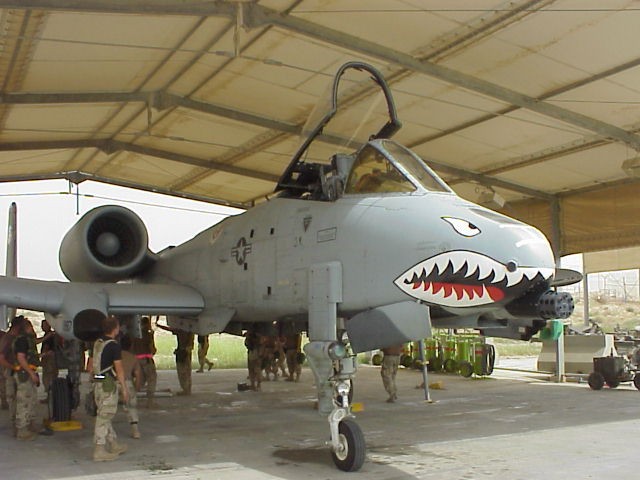
By BRUCE ROLFSEN
DefenseNews.com
www.defensenews.com/story.php?F=1851223&C=airwar Posted 06/12/06 11:49
When U.S. airmen take a peek into the cockpit of an upgraded A-10C Thunderbolt, Master Sgt. Van Hess knows what comes next.
"I love watching a guy climb into a jet for the first time. Right before he fires the jet up, he goes 'Wow!'" said Hess, an avionics specialist with the Maryland Air National Guard's 175th Maintenance Squadron.
The "wow" factor is coming soon to an A-10 unit near you, as the aircraft's mission evolves from Cold War tank-killer to the aircraft of choice for tracking down Taliban insurgents.
"You don't have 50 tanks rolling across a desert valley," said Maj. Doug Baker, an A-10C operational test pilot and chief of current operations for the 104th Fighter Squadron at Warfield Air National Guard Base, MD. "You've got to be able to find a target, figure out what it is and get a bomb off before it scurries away."
Ongoing A-10C upgrades are part of a larger effort to keep the WartHog in the fight through 2028 and help each jet reach 16,000 hours of flight time, said Brent Berrett, who helps oversee improvements to the A-10 as deputy commander of the 508th Aircraft Sustainment Squadron at Ogden Air Logistics Center in Utah. About 355 A-10s are flying.
The long-range plan to keep the A-10 flying will cost billions of dollars and include new cockpit avionics and flight controls, deadlier bombs, more powerful engines and stronger wings.
The WartHog upgrades will change how the A-10 is used and accelerate reaction time to critical calls for close air support. "It will absolutely speed up the process of prosecuting a target from the time terminal air controller develops 'I need that thing shot,' to me as a flight lead putting my weapons on that," said Capt. Andy "CJ" Taylor, who is looking forward to flying the A-10C in 2007 as a pilot assigned to the 75th Fighter Squadron at Pope Air Force Base, NC.
The upgrades mean a new lease on life for the A-10.
The aircraft was targeted for retirement when the Cold War ended in the late 1980s. Although Operation Desert Storm in 1991 proved the A-10 still had a role, some Air Force leaders in the 1990s weren't keen on the plane and considered trading its mission to the Army in exchange for taking over Patriot missile batteries.
Today, with Air Force leaders emphasizing the service's close air support role, the A-10 seems to have a secure future. Although the stealthy F-35 Joint Strike Fighter is intended to replace the A-10, the F-35 has yet to fly or prove itself.
Controls 'At Your Fingertips'
The A-10C precision engagement upgrade replaces the attack jet's 1970s-vintage electronics and flight controls with a digital system that allows the A-10C to release almost any bomb in the Air Force stockpile. The A-10 will still have its 30mm cannon with 1,150 rounds ready to fire. "You want to carry all that stuff because the guy on the ground is hoping to have all that stuff," said Col. Warren "Wardog" Henderson, commander of the 23rd Fighter Group at Pope Air Force Base, NC, home of the A-10 Flying Tigers.
The Air Force is expecting to spend about $236 million to develop and field the precision engagement kits, Berrett said. By the end of this year, A-10Cs should be in the hands of operational fighter squadrons. Early versions of the A-10C are being flight-tested at Nellis Air Force Base, NV, and Eglin Air Force Base, FL. The test planes were the first to roll out of the Ogden Air Logistics Center, where old A-10As are turned into A-10Cs. The controls of the new A-10C feature a system called HOTAS - short for Hands on Throttle and Stick - that puts the A-10C on the same level as supersonic fighters. While hands-on controls are standard in other fighters, the old A-10As never had them.
Henderson appreciates the difference.
"I've flown the F-15E Strike Eagle. I've flown the A-10," said Henderson. "In order to do the same things you'd do in the Strike Eagle with a couple movements of your thumb, in the A-10 we have to move our hands all over the place to throw switches in order to do the same thing. For me to drop a laser-guided bomb in the A-10 is kind of tasking, while in the Strike Eagle it's just two or three switches."
"Now we can control all of our targeting pods, our weapons, our navigation system... without taking our hands off the stick and throttle, which is a big deal," said Baker.
The A-10C incorporates the control stick of an F-16 and the right-hand throttle of an F-15, explained Maj. Eric "Emmitt" Smith, the chief test pilot for the A-10C program at the 40th Flight Test Squadron, Eglin Air Force Base, FL. The new controls are easier to use. As an example, Smith cited the new avionics that control the bombs and missiles carried by the A-10. The old system uses 11 sets of dials and switches, one for each of the A-10's weapon stations, Smith said. The stick's buttons control the new system, called the "digital stores management system." Now, instead of looking at dials and switches to see the settings, the pilot looks at one of the cockpit's two computer screens and uses the stick's buttons as if they were a computer mouse.
The pilot of an A-10A must go through a cumbersome process to use its Litening II targeting pod. The pod's laser system enables a pilot to find targets on the ground and displays the coordinates on the A-10A's lone video screen. But to remember the coordinates, the pilot has to write out the location and then hand-punch the numbers into the A-10A's computer system. The A-10C system is easier and faster. It can store coordinates from Litening II or Sniper pods, so its pilot doesn't have to reach for a pen. The pilot can also feed in coordinates by moving a cursor over a spot on an electronic map. The computer then saves the coordinates and aims the bombs at that location.
"In the new system, it's all going to be at your fingertips," Baker said.
Deadlier Weapons
Accurate coordinates are even more important because for the first time, the WartHog will be able to drop satellite-guided bombs.
While A-10 pilots will tell you about ducking below clouds while helping troops under fire on the ground, the A-10 hasn't been an all-weather fighter that can drop guided bombs through clouds or sandstorms. That changes with the precision engagement upgrade. In 2007, hardware and software will be added to enable the A-10C to drop Joint Direct Attack Munitions, as large as 2,000 pounds, and the Wind Corrected Munitions Dispenser, a high-tech cluster bomb. These satellite-guided bombs use Global Positioning System satellite signals to steer themselves to a target.
Most of the avionics hardware testing is complete and the focus now is on the software for the cockpit and targeting systems, said Smith. The goal is to have the evaluation of the cockpit avionics software complete by the end of the year. Another addition will be the situation awareness data link (SADL) that lets an A-10C pilot send and receive information without using the radio. For example, a flight leader who needs to know what weapons his wingman has on board can look it up by using SADL, without having to speak to the wingman.
Better Engines, Stronger Wings
Still in the planning phase are improvements to the A-10's engine. The plan is to replace sections of the planes' General Electric TF34-100 engine, increasing its thrust by about 30% to around 12,000 pounds. The more powerful engine would allow the A-10 to take off safely from bases at high altitudes and temperatures with a full weapon load, pilots said. The A-10s could also operate from shorter runways. The service has spent about $13 million developing the idea and is proposing to spend $257 million, starting in 2007, to buy up to 110 engine improvement kits.
About 240 A-10s fly with what the Air Force calls "thin-skin wings," said Berrett. These wings were installed on early production runs of the A-10. These thin wings are proving costly to repair as layers of metal inside the wing separate. Instead of continuing to repair the thin wings for an estimated total of at least $1.9 billion, the Air Force wants to build and install new wings that have thicker layers of metal. The wings should cost about $1.3 billion to manufacture and install. The new wings are expected to fly for 10,000 hours without a major inspection, Berrett said.
The proposed wing installations would begin in 2011 and continue through at least 2015.
As the testing ends and production ramps up, the A-10C will be gradually introduced to operational units in 2007. The Maryland Guard's 175th Wing will be the first unit to integrate the A-10C into normal operations. Among active-duty units, the 23rd Fighter Group at Pope will be the first to receive the improved jets. Henderson, the group's commander, expects the 23rd to receive its first upgraded jets in early 2007.
The conversion will require pilots, maintainers and munitions troops to become qualified on the upgraded jet. The training courses for ground crews are being developed based on what munitions troops and maintainers assigned to the test teams are learning, said Hess. "The great thing about the precision engagement program is that the whole thing was built by A-10 pilots and A-10 maintainers," said Maj. Shane Henderson, a maintenance officer with Pope's 23rd Aircraft Maintenance Squadron.
Ties to the Past, Future
Maintainers look forward to the A-10C because it brings order to nearly 30 years worth of smaller-scale changes. "You can open an access panel and see a part that looks like it has been there since 1978 and a part that looks like it came out in 2000," said Tech. Sgt. Kristian Safford of Pope's 23rd Aircraft Maintenance Squadron.
For example, past upgrades added new computer processors, but the electronic information had to pass through old wires and connectors. With the A-10C designed to handle the demands of faster computer processors, the avionics should run smoother.
• E-mail: brolfse@airforcetimes.com.

